GIBBES, EDMUND A. (1819-1876). Surgeon, Confederate States Medical Staff; acting assistant surgeon, General and Staff Officers Corps, Confederate States of America. Gibbes was a native of Charleston, South Carolina. When his attorney applied in 1844 for a passport for Gibbes to travel to Europe for two years, he described him as 5′ 8″ tall with light hair and eyes, a nose “rather inclined to the Grecian form,” with a pale complexion and “general appearance delicate.” According to Three Rivers Form an Ocean…Vignettes of Life in Charleston, SC, by James Funk (2003), Emma Holmes wrote in her diary on October 14, 1861, that the government sequestered the property that belonged to Edmund Gibbes for “refusing to do military service, or pay his fine” and that “…his only good point was that he loved his mother.”
Civil War Bio Search
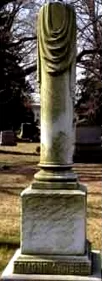
The 1861 census for Charleston showed that he owned three properties on John Street in the 5th Ward that were occupied, one only by slaves and the others by slaves and free persons. He also owned two properties on Wall Street in Charleston. Other documents note that he desired to obtain $16,000 in funds that he had in New York in 1861. On November 21, 1861, he was in custody of the marshal of the CSA, South Carolina, accused of taking an oath of allegiance to the United States. The next day, he wrote a statement claiming that he had visited New York City after the Civil War began in order to collect a $16,000 debt. He insisted that he was loyal to the Confederacy and denied any oath of allegiance to the Union. To support that statement, he said that in the spring of 1861 he bought $6,000 of Confederate stock, $5,000 of state bonds for the War, and that his real and personal property in South Carolina was worth more than $300,000. He also attested that he was willing to take an oath of allegiance to South Carolina.
Subsequently, Gibbes was an acting assistant surgeon, in the General and Staff Officers Corps, serving in the Number 4 General Hospital at Wilmington, North Carolina, for November 1864, after receiving an appointment on June 6, 1864. As of February 1865, he was assigned to the General Hospital in Wake Forest, North Carolina. Then, Gibbes was a surgeon for the Confederate States Medical Staff. On March 9, 1866, Doctor Gibbes wrote this letter to Lieutenant Jesse Craig of the 35th U.S.C.T. outlining his contract with five freedmen from his plantation in Charleston, South Carolina:
Dear Sir,
Your letter of March 3rd requesting information regarding my plantation near Adam’s Run, &c has been received & in reply I would state, that the lands, premises, & c are leased for one year from Jan 1st 1866 to Samuel Gibbes, Sampson Fenwick, Gainey Singleton, Ancel Guerard & Harry Rivers; Freedmen formerly belonging to me. The terms are Five Bushels of produce to each acre of high land planted to be delivered to me as soon as harvested. I furnish nothing, & have no control over their actions whatever, they being at liberty to contract for labor with who they think proper, irrespective of former owners, & are amenable to the laws, as we all are. I have but little faith in written contracts, as they offer no more security than a verbal understanding between parties disposed to be just, hence this is a verbal contract between persons, who have known each other all their lives, but it was understood, that if the law required one, it must be at their expense. This contract was made as early as the first November 1865, with a reservation on my part, that if the landholders came to any determination, as to what course they would pursue, that I would feel myself bound to c??? with them, but as no such plan was followed, but each has entered upon his own course, I then concluded definitely(?) the terms here named on the 1st January 1866.
I have been repeatedly invited by them to visit the place, but in consequence of the absence of all comforts, I have not ???? done so, but I now contemplate going up there on Saturday by railroad to Edisto River, & by boat to the plantation, where I shall remain until Tuesday & return, I have no mode of conveyance to Adams Run, but if you will call on the place will be happy to see & confer further with you on Monday.
I remain Yours very Respectfully,
E.A. Gibbes
He last lived at 50 Navy Street in Brooklyn. He died of stomach cancer. Section 186, lot 18533.
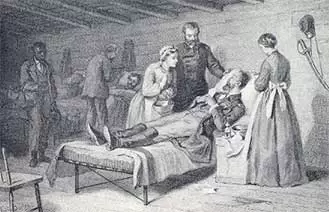
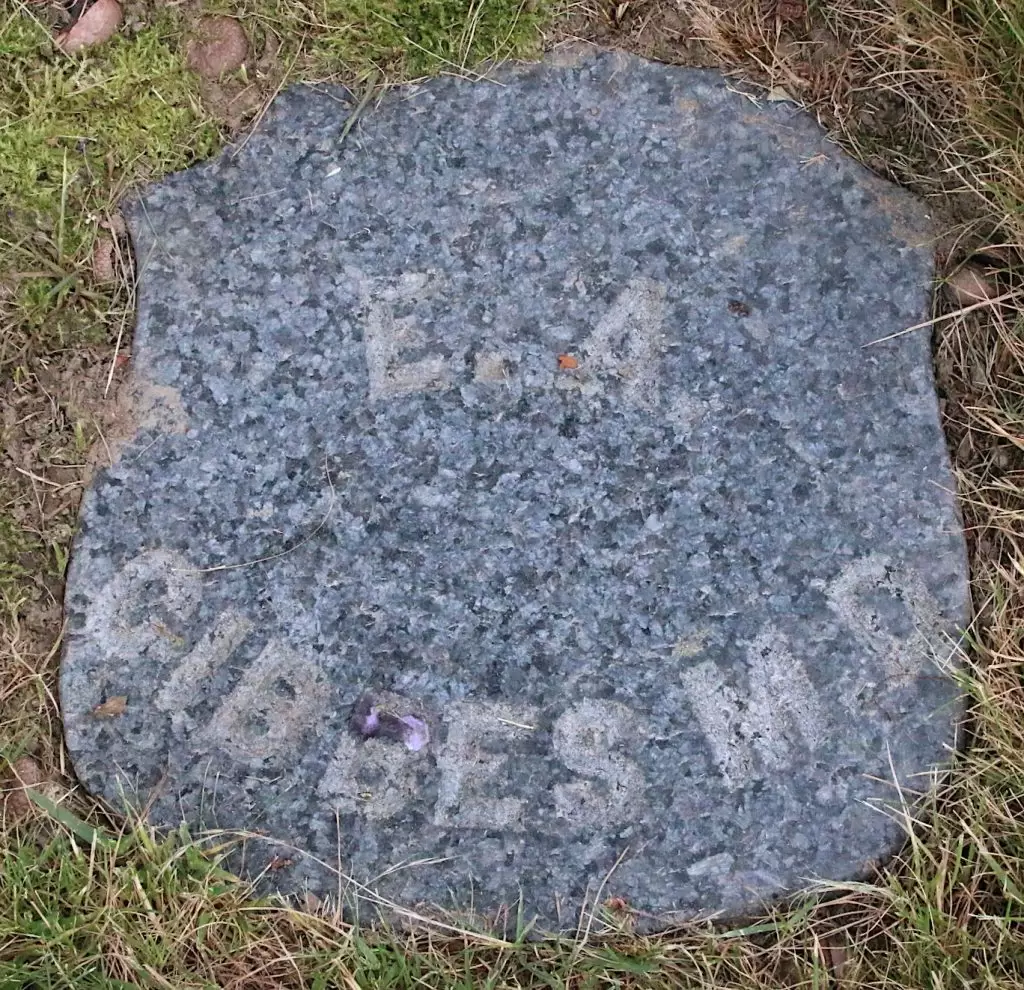
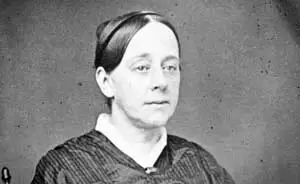
GIBBONS, ABIGAIL HOPPER (1801-1893). Antislavery and prison reformer and Civil War nurse. Gibbons was born in Philadelphia, Pennsylvania, to Quakers Sarah and Isaac Tatem Hopper (see), educated at home and in Quaker day schools, and reared in an atmosphere in which devotion to good works was a daily concern. In 1821, she established a school for Quaker children in her native city, and ran it for the next decade. She joined her father in New York City in 1830, married James Sloan Gibbons, a Philadelphia Quaker, in 1833, and settled in New York City. Together with her husband, she became an important worker in the Manhattan Anti-Slavery Society, and their house became a haven for escaping slaves. She organized fairs to raise money for abolitionism. When her father and husband were disowned by the Meeting of Friends for their anti-slavery activism, she read her own resignation from the society at its yearly meeting.
She devoted herself to other causes including temperance, aid to the poor, opposition to capital punishment, and the rehabilitation of prisoners. A leader of the Prison Association’s Female Department, she was on the managing committee of the Isaac T. Hopper Home (which offered lodging to women just discharged from prison), and was an important member (and later head) of the Women’s Prison Association and Home. In 1855, when her son’s death at Harvard caused her such depression that she feared she might become insane, she mustered even greater energy to help others. She did welfare work in New York’s tenements, visited prisoners at the Tombs every week, and worked at the Randall’s Island Infant Asylum. In 1859, she was named president of the German Industrial School.
When the Civil War began, she and her daughter Sarah went to Washington, D.C., and worked as nurses for the next three and a half years. At the hospitals, principally the Patent Office Hospital, she and her daughter distributed supplies to the soldiers that were provided by friends and from the Woman’s Central Association of Relief, an organization that was most active in New York. On a visit to a hospital in Fall’s Church, she was implored by a volunteer recruit from Penn Yan, New York, to stay and help. The sight of the emaciated soldier remained with her and she took a room in a nearby saloon for $5 a week and tended to 39 sick men who were most in need. Six weeks later, they were restored to health, including the man from Penn Yan, according to L. P. Brockett, M.D., and Mary C. Vaughan in Woman’s Work in the Civil War (originally published in 1867, page 469). She then traveled to Seminary Hospital where the severely wounded were housed and later was at Strasburg, Virginia, when the enemy took over the facility and the nurses and patients were forced to flee. Gibbons was at Point Lookout, Maryland, when Hammond United States General Hospital opened in July 1862. During her fifteen months there, she and her daughter nursed soldiers who were traumatized by War, barely able to walk, dirty, and malnourished.
During her service she advocated for Negro contrabands and criticized the “ignorant butchery” of army surgeons. Some army officers resented this criticism, but she was protected from retribution by Senators and other prominent officials. She was not so lucky with the mob that sacked her New York home during the Draft Riots of July 1863. Brockett wrote that all the window panes of her house were broken, the furniture destroyed, contents of drawers stolen or ruined, carpets were soaked with water and mud, and her piano burned. Papers and memorabilia from her father and late son were also defaced (pp. 473-474). After a stay in New York, Gibbons and her newly-widowed daughter returned to their work as nurses after the Battle of the Wilderness, Virginia, in May 1864. Shortly thereafter, they opened a make-shift hospital at Fredericksburg, Virginia, readied beds that they filled with straw and prepared food for the sick and injured. Eventually, they accompanied and ministered to the soldiers when Fredericksburg was evacuated. After stays in White House and City Point, Virginia, the two women accepted appointments at a hospital in Beverly, New Jersey, that housed 1,900 patients, and required long hours and arduous labor.
After the War, Gibbons organized the Labor and Aid Society to help veterans find work, and established laundries and nurseries to provide work and help for the widows and orphans of the Union dead. She was a founder in 1873 of the New York Diet Kitchen Association which gave food to the sick who could not otherwise afford it. In her capacity as head of the New York Committee for the Prevention of State Regulation of Vice, she opposed bills in the State Legislature that would have mandated the licensing and examination of prostitutes. She successfully championed a bill which in 1890 created the position of police matron, allowing women to be searched for the first time by female officers. Her greatest achievement, she believed, was the creation of a women’s reformatory in New York City. Elizabeth Cady Stanton said of her, “Though early married, and the mother of several children, her life has been one of constant activity and self-denial for the public good.” Gibbons died from pneumonia. Section 31, lot 5805.
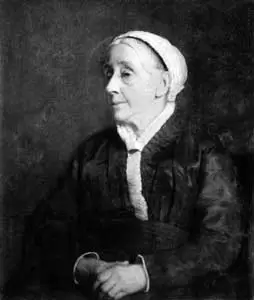
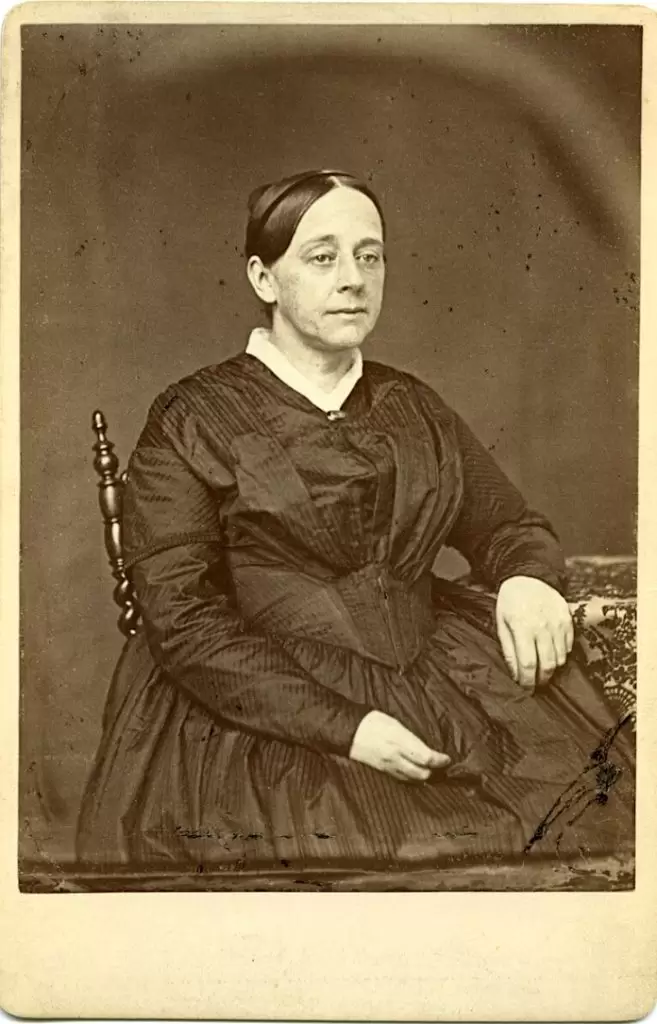
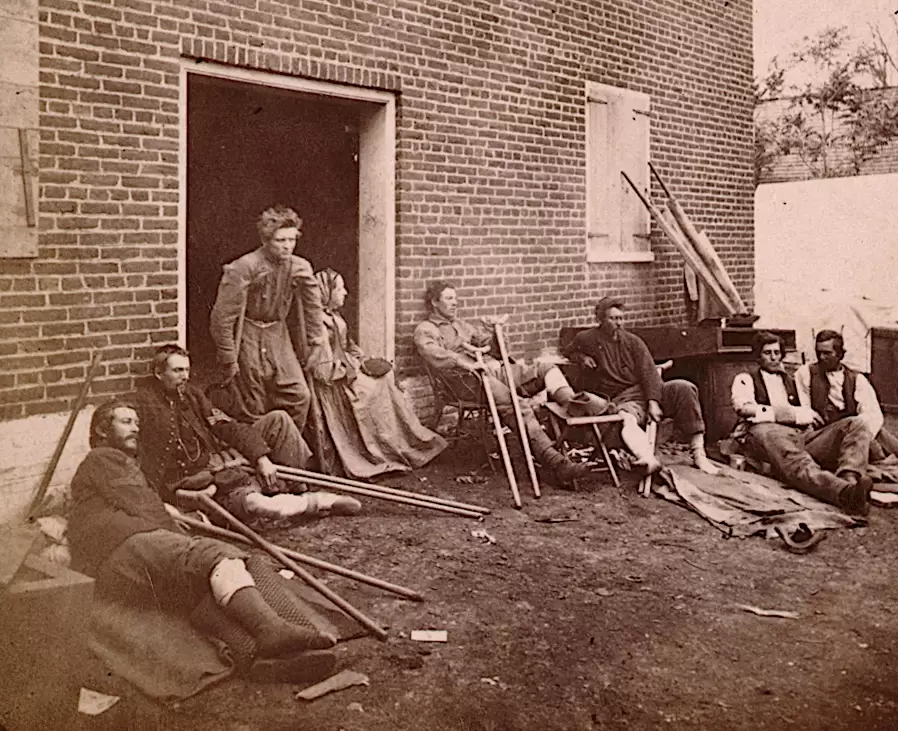
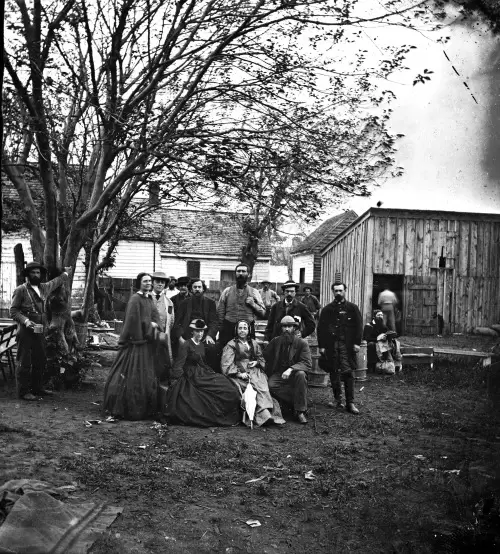
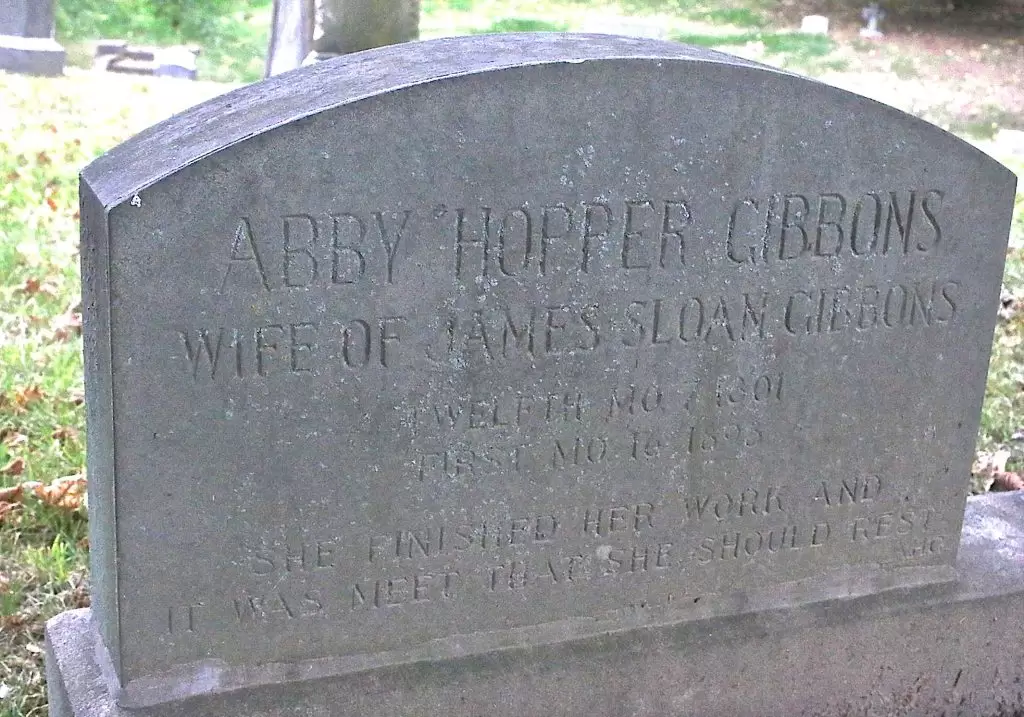
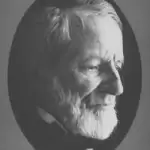
GIBBONS, JAMES SLOAN (1810-1892). Abolitionist and Abigail Hopper Gibbons’s husband. A Quaker abolitionist who had “a reasonable leaning toward wrath in cases of emergency, he wrote a popular recruiting poem that was set to music by Stephen Foster, Luther O. Emerson, and others, “We are Coming, Father Abraham, Three Hundred Thousand More.” His death was due to a hemorrhage. Section 31, lot 5805.
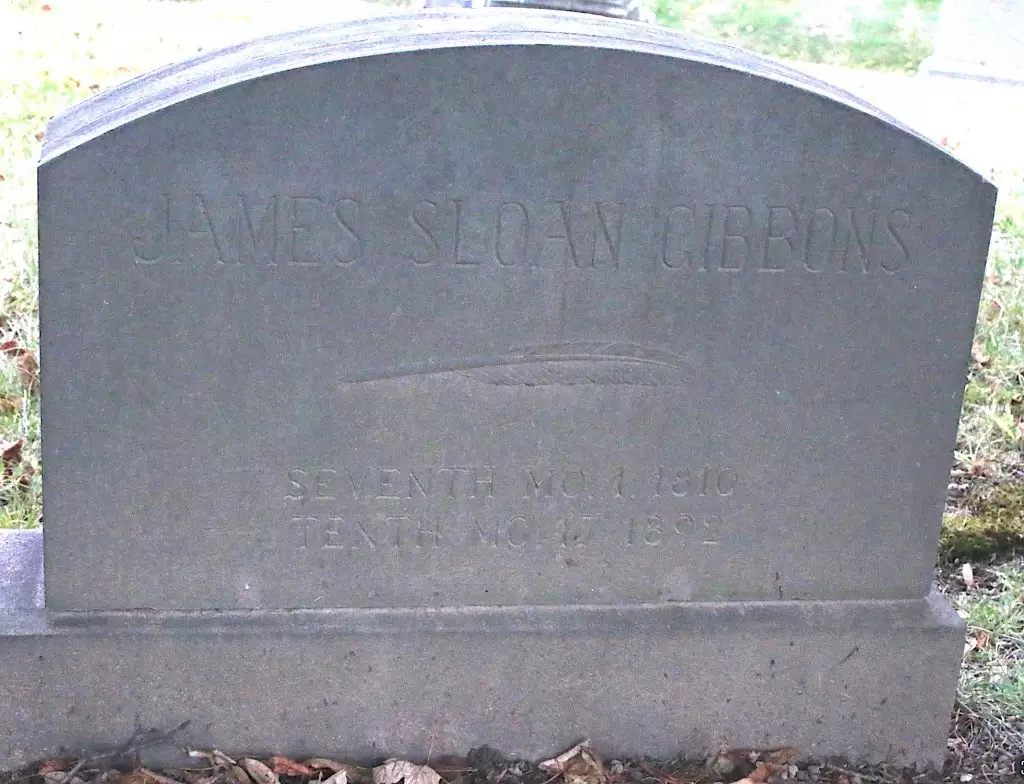
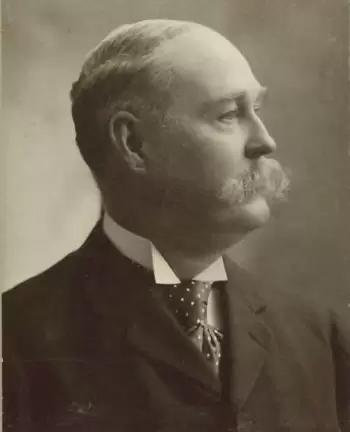
GIBBS, FREDERICK SEYMOUR (1845-1903). First lieutenant by brevet; second lieutenant, 148th New York Infantry, Company A. Gibbs, who was born in New York State, enlisted on July 30, 1862, at Seneca Falls, New York, as a private. On August 8, 1862, he mustered into Company A of the 148th New York, a regiment raised chiefly in Geneva, New York. He became corporal the next month on September 14, and was promoted to sergeant on January 1, 1864. He was wounded in the face on June 3, 1864, at the Battle of Cold Harbor, Virginia. (Later, he grew a heavy moustache to conceal the scar.) Subsequently, he was promoted to sergeant major and transferred into the Field and Staff on March 2, 1865. On April 2, 1865, he was wounded in the leg by a shell at Petersburg, Virginia. He rose to second lieutenant on June 9, 1865, but did not muster in at that rank. Gibbs mustered out on June 22, 1865, at Richmond, Virginia, and returned to Seneca, New York. According to his obituary in The New York Times, he was brevetted to first lieutenant for “gallant and meritorious services.”
In civilian life, Gibbs worked for the Gould Pump Company in Seneca, then came to New York City as that company’s representative. His application for an invalid pension was granted in 1880, certificate 227,252. Active in the Republican Party, he ran for mayor of New York City against William R. Grace, in 1884, while he was a member of the New York State Senate, having won election to that legislative body in 1883 where he was chairman of the Committee on Cities. After losing the mayoralty election, he returned to the State Senate representing the 8th District from 1884-85, then represented the 13th District from 1889-90. A member of the Republican National Committee from New York from 1896 through 1903, he was a delegate to the Republican National Convention from New York in 1900, supporting William McKinley. An art collector, he was the president of the Metropolitan Water Company at the time of his death. Among the civic organizations to which he belonged were the New York Republican Club, the New York Athletic Club, and the Salamander Club. Gibbs last lived at 421 West 22nd Street in Manhattan but died in Asbury Park, New Jersey. Daisy Gibbs, his wife, applied for a widow’s pension in 1903, application 794,631, but there is no certificate number. An application for a minor’s pension in 1913 was approved under certificate 566,298. Section 153, lot 20154, graves 12 and 13.
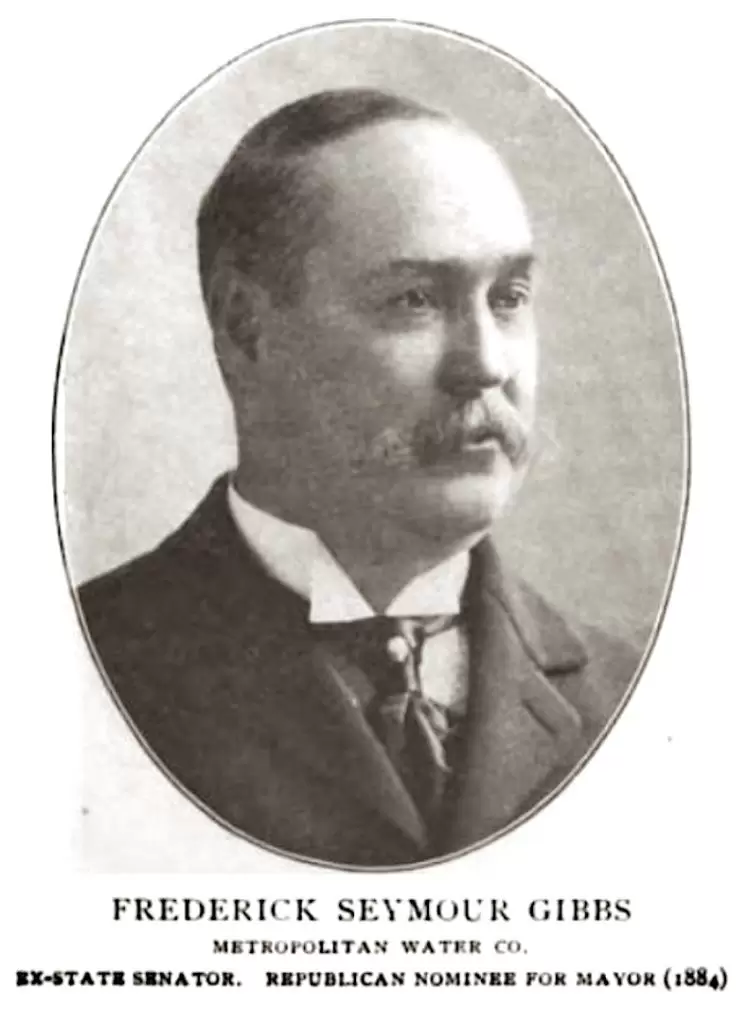
GIBBS, JAMES (1835-1866). Private, 84th New York (14th Brooklyn) Infantry, Company A; 6th Veteran Reserve Corps, Company G. Of English birth, Gibbs enlisted as a private at Brooklyn on September 3, 1862, mustered into the 14th Brooklyn seven days later, and was wounded at Gettysburg, Pennsylvania, on July 1, 1863. He transferred into the 6th Veterans on March 16, 1864, from which he was discharged. His last residence was on Atlantic Avenue in Brooklyn. His death was attributed to cholera. Section B, lot 11005, grave 112.
GIBERSON, CHARLES H. (1838-1879). Lieutenant and surgeon, United States Navy. Originally from Bath in New Brunswick, Canada, Giberson studied medicine in Fredericton, New Brunswick, and then was a graduate of the Medical College at Burlington, Vermont, from which he graduated with high honors. During the Civil War, he was a New York City resident who was a house doctor at Island Hospital at Blackwell’s Island, New York City, as of July 24, 1861. Subsequently, he was appointed by the Naval Medical Board and served on the USS Susquehanna as an assistant surgeon with the rank of lieutenant in 1862. As per his obituary in the Brooklyn Daily Eagle, he was a surgeon on the USS Tennessee and the USS Mississippi where he was attached when the latter vessel captured New Orleans, and then when that ship burned at Port Hudson, Louisiana. He was promoted to surgeon on May 1, 1865.
After the Civil War, Giberson sailed to South America on one of the War vessels and then became a surgeon at the Naval Hospital. After resigning his commission in 1868, he practiced medicine in Brooklyn, built a large practice and gained renown as a surgeon. He was loved and respected by colleagues and patients. A Freemason, he was active in many medical societies including the King’s County Medical Society, Physicians’ Mutual Aid Association, New York Medical Historical Society, and the Brooklyn Pathological Society (of which he was a founding member in 1870 and its secretary and treasurer). An attending surgeon at the Brooklyn City Hospital, the Brooklyn Daily Eagle reported that he completed his rounds despite a severe headache a few days before he took sick with peritonitis, which ultimately caused his death. Giberson last lived at 98 Remsen Street in Brooklyn. His funeral took place at the Reverend Dr. Storr’s Church of which he was a member. He was survived by his wife and four daughters. One of his daughters, Indiana Gyberson, who took her mother’s first name, changed the spelling of her surname and who is interred with him, was a painter who first showed her work at the Art Institute of Chicago in the 1920s. Section 141, lot 23029.
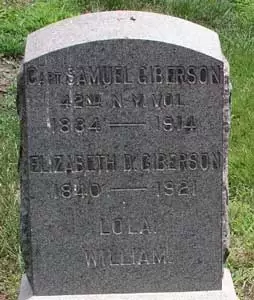
GIBERSON, SAMUEL (1834-1914). Captain, 42nd New York Infantry, Companies I, D, and A; private, 7th Regiment, New York State Militia, Company I. Born in Tom’s River, New Jersey, and a ship carpenter by trade, Giberson enlisted at New York City on April 19, 1861, to serve 30 days. He mustered into the 7th Regiment as a private, and mustered out with his company on June 3, 1861, at New York City. He re-enlisted at New York City as a second lieutenant on May 12, 1861, and mustered into Company I of the 42nd New York on July 6, 1861. On August 23, 1861, he wrote to his mother that he intended to be home for turkey and all the trimmings of New Year’s Day. He noted, “I will be home to eat dinner with you.” He was promoted to first lieutenant (not commissioned) and transferred to Company D on September 13, 1861, then transferred to Company A six days later. On October 21, 1861, he was captured in action at Ball’s Bluff, Virginia, and was promoted to captain the next day. His exact date of parole is not stated. However, he did not spend New Year’s Day with his mother; he was in fact incarcerated at Richmond Virginia’s Liggon Tobacco Factory which had been converted into a prison for Union captives. After his release, he returned to his company as its captain. He was discharged on September 28, 1862. The 1863 Draft Registration lists him as a ship carpenter.
On November 7, 1870, an article to voters of the Twentieth Ward appeared in the Brooklyn Standard Union in support of Giberson’s campaign to be alderman from the Republican Party. That piece, written by ex-collector A. M. Wood, notes that Giberson, his deputy collector of internal revenue for the Second District, was efficient, honest and well-qualified to represent the taxpayers. The two first became acquainted while they were prisoners of war in Libby Prison in Richmond, Virginia, in 1861. The censuses of 1880, 1900, and 1910 indicate that he was a customs inspector. On October 17, 1884, he mustered into Edward Wade Post #520 of the G.A.R. He applied for and was granted a pension in 1908, certificate 1,057,571. Giberson was a member of the Seventh Regiment War Veterans Association. His obituaries in the Brooklyn Daily Eagle and the Brooklyn Standard Union confirm his Civil War Service, promotion for bravery, and confinement in Libby Prison. At the time of his death from pneumonia, he was residing at 397 Adelphi Street, Brooklyn. Elizabeth Giberson applied for and received a widow’s pension in 1914, certificate 788,346. Section 33, lot 5519.
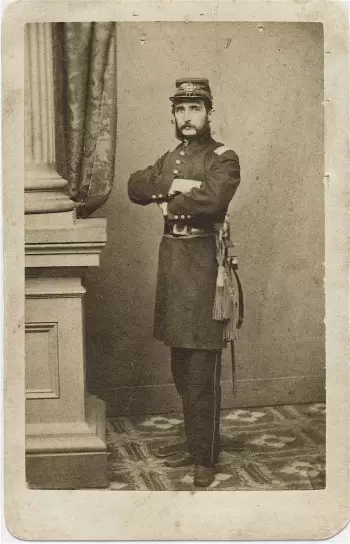
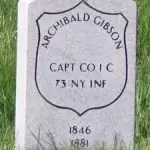
GIBSON, ARCHIBALD (1846-1881). Captain, 73rd New York Infantry, Companies I and C. Of Scottish birth, he enlisted at New York City as a first lieutenant on May 3, 1861, and was commissioned into the 73rd New York on August 2. He was promoted to captain on November 10, 1861, effective upon his transfer that day to Company C, and was discharged on June 3, 1863. As per the 1880 census, he was a carpet printer. He last lived at 551 West 51st Street in Manhattan. He died of phthisis. Section 15, lot 17263, grave 1486.
GIBSON, DEWITT J. (1843-1909). Private, 72nd New York Infantry, Company G; 120th New York Infantry, Company I; 73rd New York Infantry, Company G. Gibson was born in Warwick, New York, on November 23, 1843, to David and Elizabeth Gibson. At the time of his birth, he was the youngest of three siblings, including Mary R. Gibson and William H. Gibson. The 1850 federal census locates him in Chester, New York, at age seven with his parents, Mary (12), William (8), and younger siblings Anson (5) and Emily 2.
While an 18-year-old farm laborer, Gibson enlisted on July 17, 1861, and mustered into the 72nd New York Infantry, Company G, in Chester on July 28. On his muster roll, he was described as having gray eyes, dark hair, and light complexion. That muster roll also notes that he was wounded in action in Fredericksburg, Virginia, on December 13, 1862. On December 20, 1863, at the age of 20, he re-enlisted into Company G before again being wounded (no date or location recorded). On July 24, 1864, he transferred into the 120th New York Infantry, Company I. Just short of a year later, on June 1, 1865, he transferred out of the 120th and into 73rd New York Infantry, Company G, where he finished his military service. On July 24, 1865, Gibson mustered out at Washington, D.C. According to the 1865 New York State census, he, at age 22, returned to his parents’ home in Chester.
His pension index card confirms his service in the 72nd, 73rd, and 120th Infantries He applied for an invalid pension in 1871; it was approved, certificate 114,514.
Per Ancestry.com, Gibson married Elizabeth Morgan (1845-1911) in 1867. The 1870 federal census indicates that they lived in Blooming Grove, New York, with two children: Dewitt Jr. (3 years old) and older sibling Melvina (age not given). In the census, Gibson is identified as a 26-year-old farm laborer.
The New York State census of 1875 identifies Gibson as head of household of a residence in Chester with wife Elizabeth, and two additional sons: Eugene A Gibson (5) and Edmond Gibson (1). In 1880 at age 35, DeWitt moved his family to Middletown, New York.
In 1900 federal census lists DeWitt (60), Elizabeth Gibson (59) and their children as living at 249 59th Street in Brooklyn, in the home of his daughter Melvina Moyle (30), who was now married to J. Samuel Moyle (married for three years) with their three children.
Gibson’s last residence was 523 59th Street, Brooklyn, State Hospital Boro of Brooklyn, where he died on April 14, 1909, at the age of 65. The cause of death was “mental disease.”
On May 7, 1909, his widow, Elizabeth Gibson, applied for and received a widow’s pension, certificate 685,438. She died in 1911 and is interred in the lot with him. Lot 27263, grave 2253.
GIBSON, JOHN DOUGLASS (1803-1869). Purser, United States Navy. Gibson enrolled in the Navy as a purser on June 4, 1840, and served until his retirement on December 10, 1867. He last lived at 156 Union Street in Brooklyn. He died from cirrhosis of the liver. Section 171, lot 9218.
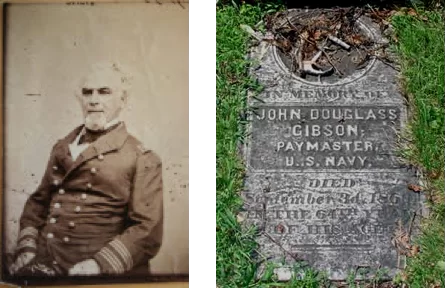
GIBSON, ROBERT (1847-1895) Musician, 79th New York Infantry, Company C. A native of New York State, he enlisted at New York City on May 13, 1861, as a musician, and mustered into the 79th New York on May 28. He was discharged for disability on March 26, 1863, at Annapolis, Maryland. As per the census of 1880, he was a skate manufacturer. He joined G.A.R. Post #170, the Addison Farnsworth Post, on September 2, 1892. His last address was in Yonkers, New York. His death was attributed to miliary tuberculosis. Section 52, lot 4344, grave 3.
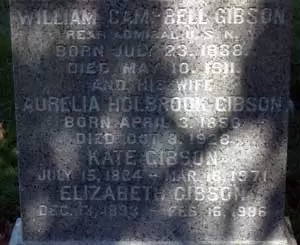
GIBSON, WILLIAM CAMPBELL (1838-1911). Rear admiral, United States Navy. Born in Albany, New York, he entered volunteer service in the Navy on December 15, 1862, and rose through the ranks. During the Civil War, he served in the Potomac flotilla and in the North and South Atlantic Blockading Squadrons. After the War, he was promoted to ensign on March 12, 1868, to master on December 18, 1868, to lieutenant on March 21, 1870, and to lieutenant commander on July 13, 1884. As per his obituary in the New York Herald, he had the distinction of taking the USS Monongahela from San Francisco to New York in 106 days in 1890. Gibson was promoted to commander on July 4, 1893. He was stationed at the Portsmouth Navy Yard in New Hampshire, then was commanding officer of the training ship Adams in the Pacific. In 1898, during the Spanish-American War, he was detailed to the City of Peking which brought men to Manila in the Philippines. From October 1898 to February 1890, he was senior member of the board of inspection at the Brooklyn Navy Yard.
Gibson rose to captain on February 18, 1900, then commanded the USS Texas in the waters off Bermuda. The Utica Herald-Dispatch of May 23, 1900, reported that an incident aboard the Texas, first thought to be a mutiny, occurred when enlisted men, somewhat drunk after returning from shore leave, were given rum to mix with varnish in order to shellac the decks. Allegedly, lemon juice and sugar were added to the concoction which was then drunk. A crazed melee ensued, marines were called in to quell the disturbance, and the participants were put in chains. Captain Gibson denied the mutiny rumors and court-martials were expected when the ship docked in New York; the results of the court-martial are not known. Gibson retired on July 23, 1900, with the rank of rear admiral. He last lived at 1412 Pacific Street in Brooklyn. Section 200, lot 24115, grave 5.
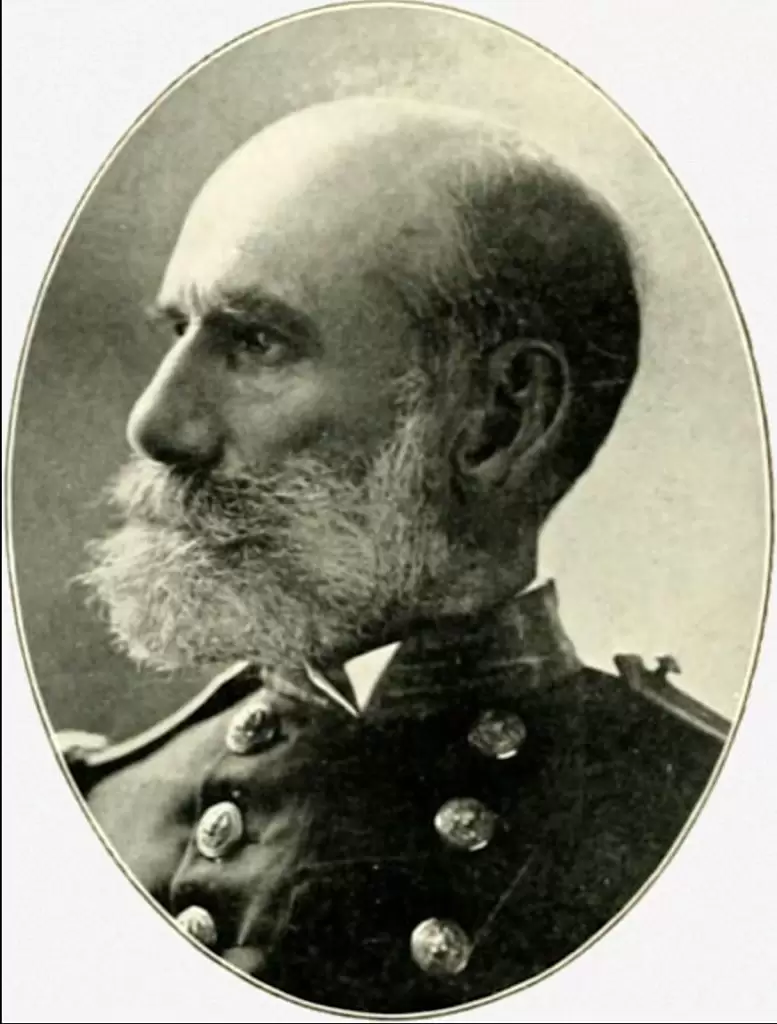
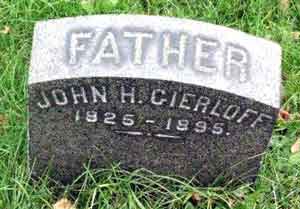
GIERLOFF, JOHN H. (1825-1895). Seaman, United States Navy. Of German birth, Gierloff enlisted on June 30, 1861, at the Brooklyn Navy Yard. He served on the USS North Carolina from September through October 12, 1861; the USS Niagara to November 15, 1861; the USS Massachusetts to January 1, 1862; and the USS Colorado from which he was discharged on June 30, 1862. His pension application was granted under certificate 10,523.
Gierloff became a naturalized citizen on October 17, 1876. As per the New York City Directory of 1877, he was a watchman. He last lived at 192 4th Street in Jersey City, New Jersey. A military stone was requested in 1895 and ordered from the Vermont Marble Company. His widow, Catherine Gierloff, who is interred with him, received a pension from the Navy shortly after his death from cardiac rheumatism in 1895, certificate 14,949. Section 135, lot 27263, grave 691.
GIFFIN (or GRIFFIN), HENRY C. (1845-1892). Private, 83rd New York Infantry, Company H. Giffin was born in New York. As per the 1860 census, he was a gas fitter apprentice. During the Civil War, Giffin enlisted as a private at New York City on May 27, 1861, mustered into the 83rd New York that same day, and deserted on December 13, 1862, at Fredericksburg, Virginia.
The 1875 New York City Directory reports that he was a police officer living at 228 West 16th Street in New York City. The 1880 census and the 1886 New York City Directory report that he was a gas fitter; he was living at 458 West 29th Street in New York City in 1886. He last lived at 452 West 31st Street in Manhattan. He died from phthisis (tuberculosis). Although Lillie Giffin applied for a widow’s pension, application 801,402, there is no certificate number. Section 135, lot 27263, grave 2142.
GIFFORD, SAMUEL E. (1842-1904). Sergeant, 173rd New York Infantry, Company A. Born in Brooklyn, he enlisted there as a private on September 5, 1862, and mustered into the 173rd New York on October 30. As per his muster roll, he was a carpenter by trade who was 5′ 6¼” tall with green eyes, black hair and a dark complexion. He was promoted to sergeant on August 10, 1864, and mustered out on October 18, 1865, at Savannah, Georgia. The census of 1880 and the Brooklyn Directory for 1889 list him as a house carpenter. His last address was 99 12th Street in Brooklyn. Gifford died of pneumonia. Section 85, lot 1595, grave 112.
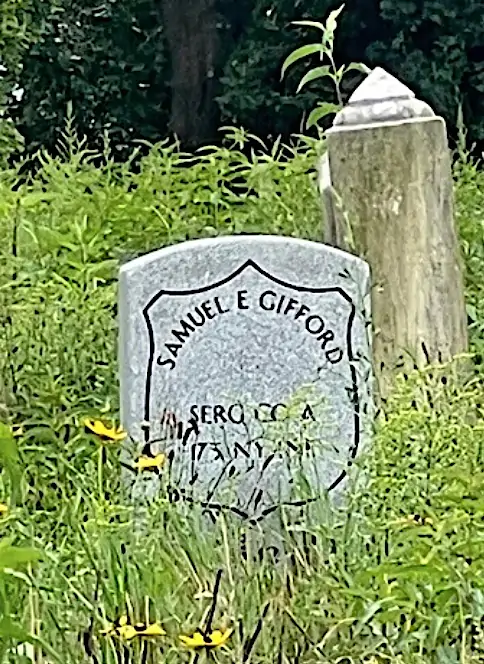
GILBERT, ARTHUR WASHINGTON (1839-1916). Private, 24th Wisconsin Infantry, Company B. A resident of Milwaukee, Wisconsin, Gilbert enlisted on August 21, 1862, mustered into Company B of the 24th Wisconsin Infantry that same day, and was discharged for disability on December 17, 1862. The Brooklyn Directory for 1874 reports that Gilbert was a bookkeeper who lived at 92 Ryerson Street; the 1897 Brooklyn Directory reports that he was a superintendent who lived at 64 Downing Street. In 1901, his application for an invalid pension was approved, certificate 1,033,792. The 1890 Veterans Census and his obituary in The New York Times confirm his service in the Civil War. He last lived at 271 9th Street in Brooklyn. Section 116, lot 4073.
GILBERT, CLINTON (1846-1871). Unknown rank, United States Navy. Gilbert was born in Brooklyn. At the time of the 1860 census, he was a 14-year-old living there with his parents. During the Civil War, he enlisted in the United States Navy at New York City on August 27, 1864. His enlistment record (which incorrectly indicates that he was born in Ireland) states that he was 5′ 6¾” tall with hazel eyes, light hair and a light complexion. As per an article about his death in the Brooklyn Daily Eagle on July 18, 1871, he served under Admiral David G. Farragut on the USS Hartford in the Gulf Squadron and participated in the campaigns at Mobile Bay, Alabama, and New Orleans, Louisiana. He was discharged at New York City on September 1, 1865. After the War, he took a clerkship at a grain house, then entered a banking firm on Wall Street. Two days before his death, he became a gauger for the Office of Internal Revenue of the U.S. Department of the Treasury.
As per a memorial biography, Gilbert was shot while he was part of a team of about 40 deputy revenue collectors and deputy United States marshals raiding several stills near the Brooklyn Navy Yard on July 14, 1871. These distilleries manufactured spirits in violation of the revenue laws. The raiding force assembled at the U.S. Marshal’s Office on Montague Street in Brooklyn at 2 a.m., heavily armed with revolvers and clubs; the Marine Corps provided assistance at the Navy Yard. The Treasury officers were fired upon by about 20 “toughs” who were hiding on Hudson Avenue. Gilbert was shot in the lower back and the bullet passed through his abdomen. He died two days later at the Marine Hospital in Brooklyn. Two other agents were injured in the raid. Though the bricks of the distillery were still warm when the raiders got inside, the still was gone.
On July 20, 1871, an article about Gilbert’s funeral, which took place at the Washington Avenue Baptist Church, appeared in The New York Times. That article reported that the offices of the Revenue Department closed at noon and that 60 employees were present at the church along with a detachment of the 14th Regiment who served as a guard of honor, and a large delegation from the War Veterans’ Union Club, of which Gilbert was a member. Gilbert was lauded as one who fell “in the path of duty” and the band played the Dead March from “Saul” as his coffin was carried to the flag-draped hearse. General James Jourdan (see), the United States Assessor and Gilbert’s superior, was one of the pallbearers.
The Internal Revenue Record and Customs Journal, in it issue of July 22, 1871, noted Gilbert’s death and stated: “These attacks upon the bold violators of the revenue laws, located in Irishtown, as it is called, endangers the lives and limbs of those who participate in them, as is proven by the fact that one of the attacking party in this instance, Mr. Clinton Gilbert, a United States gauger, was killed while in the faithful exchange of his duty as an officer of the government.” That publication, which confirms Gilbert’s Civil War service, concluded, in a letter to Assessor Jourdan, a plea to Congress: “In may not be improper to inform your whole force that in view of the growing perils of the civil service, it is my intention to recommend to Congress, through the proper channels, that pensions shall hereafter be granted to those disabled, and to the families of those slain in the internal revenue service, who merit the same consideration as the sailor and soldier maimed or killed on the battlefield.” An article about the inquest related to Gilbert’s death appeared in The New York Times on July 22, 1871. General James Jourdan testified as did several other agents who were at the scene. The inquest jurors determined that Gilbert died in the line of duty and recommended that the civil authorities in Brooklyn offer a reward for the apprehension and conviction of the person responsible for wounding Gilbert. He was a member of Wadsworth Post #4 of the G.A.R. and the War Veterans’ Union of New York City. His office, which after his death was draped in the colors of mourning, issued resolutions attesting to his fine character, integrity, and intelligence. The Brooklyn Daily Eagle reported later that month that the Treasury Department of the Office of Internal Revenue in Washington, D.C., posted the following message promising a large reward of $5,000 for information leading to the arrest of Gilbert’s assassin. His death was considered “a painful memory with his friends and a sorrow to all law-abiding citizens.” The notice read:
By and with the advice and consent of the Secretary of the Treasury, I do hereby offer, for information that shall lead to the arrest and conviction of the person or persons who, on the 14th inst., at the City of Brooklyn, in the State of New York, mortally wounded Clinton Gilbert, officer of Internal Revenue, then engaged in the discharge of his duty-five thousand dollars. A Pleasonton, Comptroller, Internal Revenue. July 26, 1871
Section 93, lot 2531.
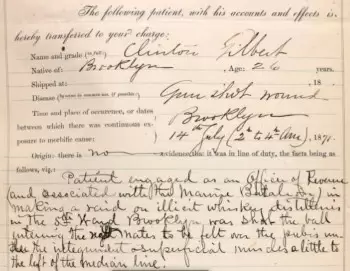
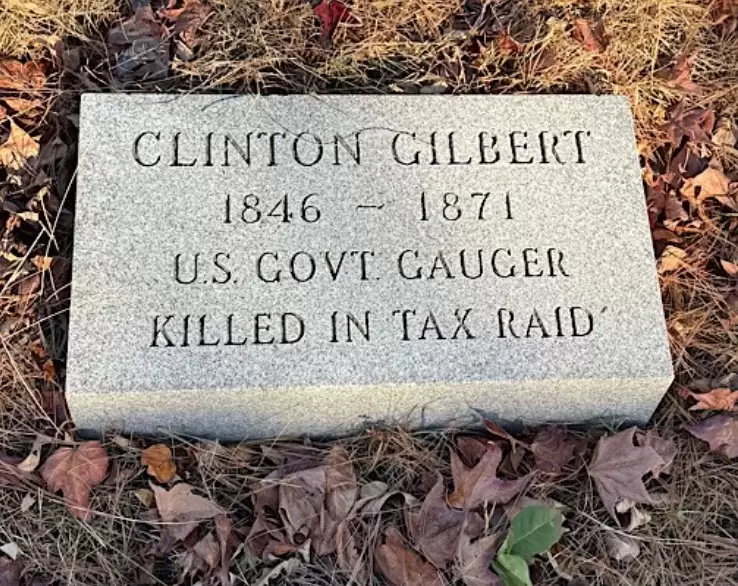
GILBERT, FREDERICK (1836-1897). Private, 71st Regiment, New York State Militia, Company G. Born in New York, Gilbert enlisted in 1861, and served for three months with the 71st Regiment. At the time of the 1863 Draft Registration and the 1870 census, he was working as a policeman. The 1880 census indicates that he was a government contractor, and, according to the 1892 New York State census, he was a bank officer. In 1892, his application for an invalid pension was approved, certificate 859,801. He last lived at 392 10th Street in Brooklyn. Alice Gilbert, who is interred with him, applied for and was awarded a widow’s pension in 1897, certificate 461,483. Section 115, lot 20934, grave 5.
GILBRAITH, JAMES H. (1845-1934). Private, 37th Regiment, New York State National Guard, Company G; United States Navy. A machinist by trade, Gilbraith enlisted for 30 days on June 18, 1863, at New York City, and mustered out of the 37th New York on July 22. He then enlisted in the Navy at Philadelphia, Pennsylvania, in December 1863 and served for one year on the warship State of Georgia until his discharge at the Brooklyn Navy Yard in November 1864. He re-enlisted for another year, served as a coal passer, and was made chief engineer. His pension index card indicates that he also served on the USS Princeton and the USS Vermont.
According to the 1888 New York City Directory, he was a conductor; the 1900 census lists him as a dispatcher. The 1915 and 1925 New York State censuses report that he was a railroad dispatcher. Gilbraith received a pension from the Navy, certificate 41,178. His family later used the spelling “Galbraith.” Section 7, lot 9326, grave M.
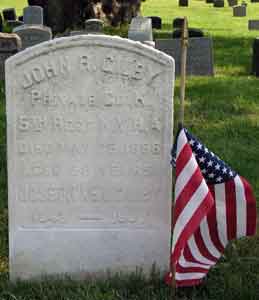
GILBY, JOHN R. (1838-1896). Private, 5th New York Heavy Artillery, Company K. A native of Queens, New York, Gilby enlisted at New York City on March 23, 1864, and mustered into the 5th New York on that date. As per his muster roll, he was a boat builder who was 5′ 9″ tall with blue eyes, light hair and a fair complexion. He mustered out at Harpers Ferry, West Virginia, on July 19, 1865. The 1880 census states that he was employed as a ship carpenter.
Articles in the Brooklyn Standard Union on May 20 and June 9, 1885, report that Gilby was brought before a judge and charged with insanity. Apparently, this was not the first time that he behaved in an unsound manner although Gilby testified that he worked at the Brooklyn Navy Yard for 20 years and had never been arrested. He was charged with assaulting his married daughter who lived with him. Gilby’s wife testified that her husband had been acting strangely and talking incoherently for two years but had taken a turn for the worse and was violent. The Charities Commission was set to determine his sanity.
A subsequent article in the New York Tribune on May 21, 1886, reports that Gilby was declared insane and committed to an asylum after taking his wife for a carriage ride during which he lashed at the horse with such fury that it ran away three times causing Mrs. Gilby to suffer from fright. However, he appears to have recovered; he was a member of the Stephen Thatford Post #3 of the G.A.R. and was elected its chaplain for 1892. In 1892, his application for an invalid pension was approved, certificate 838,635. Gilby last lived at 15 Webster Place in Brooklyn. He succumbed to heart disease. Josephine Gilby, who is interred with him, applied for and received a widow’s pension in 1896, certificate 437,906. Section 135, lot 14964, grave 588.
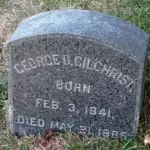
GILCHRIST, GEORGE D. (1841-1885). Private, 2nd Florida Cavalry, Company K, Confederate States of America. A New Yorker by birth, he enlisted at Callahan in East Florida on May 16, 1862, and mustered immediately into the 2nd Florida Cavalry. As per his muster roll on that date, his horse was valued at $150 and the equipment at $15; his muster roll for March-April 1863 showed that the horse was valued at $350. In 1870, he was living in Jacksonville, Florida; that is also where he last lived. His death was caused by a hemorrhage. Section 35, lot 3049.
GILCHRIST, JOHN (1840-1883). Private, 13th Regiment, New York State National Guard, Company A. Originally from Canada, Gilchrist enlisted at Brooklyn on May 28, 1862, as a private. He mustered immediately into the 13th Regiment and mustered out at Brooklyn after three months on September 12. According to the 1880 Brooklyn Directory, he was a carpenter. His last residence was 701 Third Avenue in Brooklyn. He died of phthisis. In 1891, Emma Gilchrist’s application for a widow’s pension was granted, certificate 357,825. Section 15, lot 17263, grave 833.
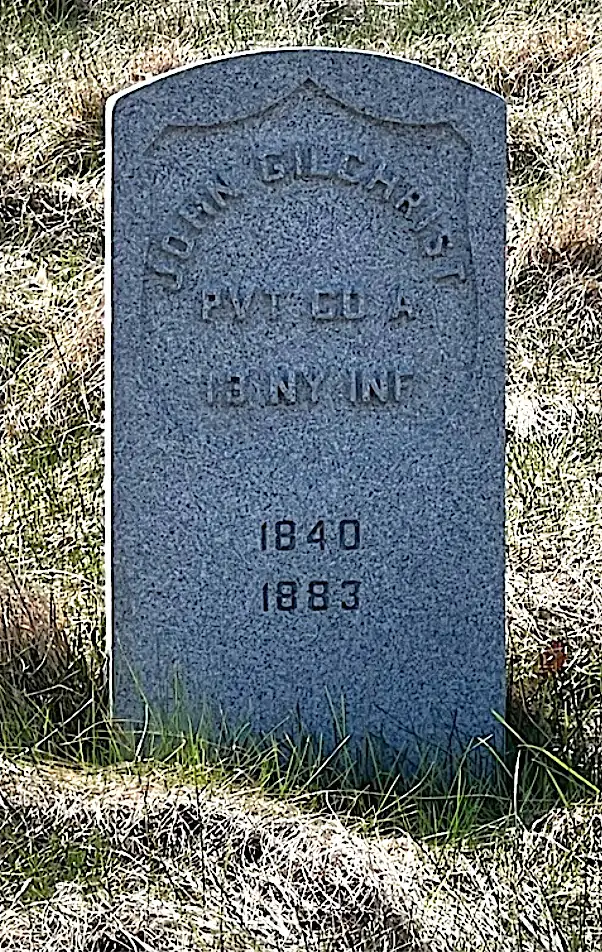
GILCHRIST, JR., ROBERT (1825-1888). Captain, 2nd New Jersey Infantry, Company F. A Jersey City, New Jersey, native, his father, Robert Gilchrist was clerk of Hudson County from 1840 through 1865 and mayor of Jersey City from 1850-1852. Robert jr. was educated in the private schools, studied law, and was admitted to the New Jersey Bar in 1847; his first work was as an assistant in his father’s office. The 1850 census reports that he lived in Jersey City with his parents and siblings and was a lawyer. In 1859, Gilchrist served in the New Jersey General Assembly.
As per his soldier record, Gilchrist enlisted as a captain early in the Civil War, on May 20, 1861, and was immediately commissioned into Company F of the 2nd New Jersey Infantry. He mustered out on July 31, 1861, at Trenton, New Jersey. Another biography and his obituary note that he served throughout the Civil War—that is apparently incorrect.
Remaining active in politics, he made an unsuccessful bid as a Democrat for the House of Representatives in 1866. As per his biography in Appletons’ Cyclopedia of American Biography, which reports his Civil War service throughout the conflict, he had been a Republican but became a Democrat during Reconstruction. Gilchrist was the attorney general of Jersey City from 1870 through 1875; during that time, he was appointed to a commission to revise the New Jersey State Constitution. Appletons’ Cyclopedia of American Biography notes that his specialty was constitutional law and his interpretation of the 15th Amendment secured suffrage for African-American men in New Jersey. Gilchrist was also instrumental in maintaining funds for public education in his home state. The 1880 census reports that Gilchrist was married with children, lived at 289 Barron Street in Jersey City, and worked as a lawyer.
His obituary in The New York Times notes his gifts as a lawyer, his commanding presence and his powerful voice. That obituary indicates that he was the special counsel for the Matthiessen & Weichers Sugar Company and the Lehigh Valley Railroad, among other corporations, and that he commanded the largest legal income in New Jersey. One of his most famous cases was that of uncovering a conspiracy of forgers, including a fake widow, which attempted to defraud an elderly miser, Joseph L. Lewis, of his millions; Gilchrist was paid $150,000 for his services and more than $600,000 was paid to the National Treasury to reduce the national debt. He last lived at 65 Mercer Street in Jersey City. His death was attributed to heart failure. After his death on July 6, 1888, he was interred at the Bergen Church Vaults; his body was removed and he was interred at Green-Wood on December 31, 1888. His biography in Appletons’ Cyclopedia of American Biography reported that his large law library, with his annotated books, was sold at auction six months after his death. His wife, Fredericka Raymond Beardsley, wrote The True Story of Hamlet and Ophelia (1889). Section 120, lot 17805.
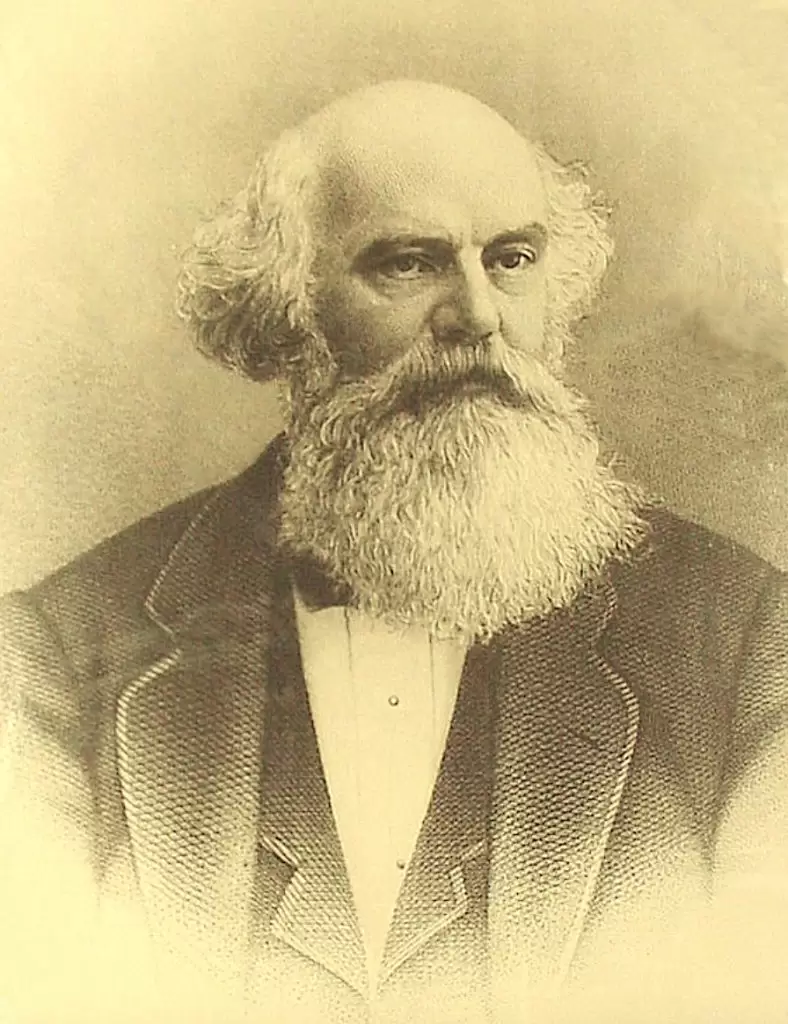
GILDERSLEEVE, BENJAMIN F. (1835-1878). Acting third assistant engineer, United States Navy. A native of New York, he was a clerk as per the census of 1860. Gildersleeve began service in the Navy as an acting third assistant engineer on December 28, 1861, and resigned on June 24, 1862. The 1872 New York City Directory reports that he worked as a clerk. His last residence was 9 West Houston Street in Manhattan. He died of Bright’s disease. Section 168, lot 16378.
GILDERSLEEVE, WILLIAM (1843-1926). Private, 13th New York Heavy Artillery, Company I. A New York native, Gildersleeve’s Draft Registration of July 1, 1863, noted that he was single and lived in Northport, New York. He enlisted as a private at Jamaica, New York, on September 27, 1864, and mustered that day into the 13th New York Heavy Artillery. As per his muster roll, he was a cab driver who was 5′ 7¾” tall with brown eyes, light hair and a light complexion. He mustered out with his company on June 28, 1865, at Norfolk, Virginia.
The 1870 and 1880 censuses report that Gildersleeve was living with his parents in New York City. In 1896, his application for an invalid pension was approved, certificate 1,100,559. The New York State census for 1925 notes that he was living in Brooklyn with his daughter and her husband. He last lived at 665 East 21st Street in Brooklyn. His death was attributed to prostatic hypertrophy. Section 181, lot 11046.
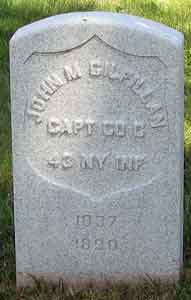
GILFILLAN, JOHN MATHEWS (1835-1890). Captain, 43rd New York Infantry, Companies G and C; 39th New York Infantry, Company I; corporal, 52nd New York Infantry, Company F. Gilfillan was born in New York City in 1835; his soldier record incorrectly indicates that he was 24 when he entered service, suggesting a birth year of 1837. In 1860, he worked as a clerk for the New York City Charity and Small Pox Hospital and Fever Tents. During the Civil War, he enlisted as a first lieutenant at Schenectady, New York, August 29, 1861, and was commissioned into Company G of the 43rd New York on September 16. He was promoted to captain on January 25, 1862, and was transferred to Company C on July 18, 1862. He served with his brother William (see) in the 43rd and is mentioned several times in William’s letters to his mother, Mary Mathews Gilfillan, many of which are in the possession of Daniel Armstrong, direct descendant of Sam Gilfillan, William and John’s brother.
The 43rd New York first arrived at Washington, D.C., then headed to Alexandria, Virginia, where they joined the Army of the Potomac. Among the engagements of the 43rd New York were these in Virginia: Siege of Yorktown and the Battles of Lee’s Mills, Williamsburg, Garnett’s and Golding’s Farm, Savage Station, White Oak Swamp, and Malvern Hill. As of August 15, 1862, the regiment, now consolidated into five companies, fought in Maryland at the Battles of Compton’s Creek, Sugar Loaf Mountain, Crampton Pass and Antietam. As per his brother’s letter home, he submitted his resignation on September 5, ostensibly hoping for a promotion in a new regiment. That resignation was accepted on September 19, 1862.
He was listed as a surveyor on the 1863 New York Draft Registration. As per the research of Daniel Armstrong, Gilfillan re-enlisted as a private on August 24, 1863, and mustered into Company F of the 52nd New York, perhaps awaiting a new commission. He was promoted to corporal on November 1, 1863. The regiment fought in Virginia during that five month period at the Battles of Auburn, Bristoe Station, Mitchell’s Ford, Robertson’s Tavern and the Mine Run Campaign. Although his service is noted on regimental rosters, it is not part of his pension files.
After his brief service with the 52nd Regiment, Gilfillan re-enlisted as a captain at the 14th Congressional District, New York, on January 18, 1864, and was commissioned into Company I of the 39th New York on February 12. On May 12, 1864, while serving in command of Company K of the 39th New York, he was wounded through the left shoulder at the battle of Spotsylvania Court House, Virginia, while leading a charge on the enemy. As a result of his injury, he was hospitalized and then was discharged for disability on September 12, 1864. Re-commissioned as captain of Company I on October 11 of that year, he fought at the Battle of Hatcher’s Run, Virginia, on December 8, 1864, at which time his wound reopened. After an arrest for an unknown reason on December 23, 1864, he was released two days later, and on December 30 was granted a leave of absence for 30 days. The request noted, “This officer has behaved with great gallantry during the campaign and exposed to the storms at Hatcher’s Run for 36 hours on picket duty.”
On March 7, 1865, he tendered his resignation with an accompanying surgeon’s note attesting that his shoulder injury made him unfit for duty. A day before his discharge, Gilfillan was charged with “conduct unbecoming an officer and gentleman” for his actions on March 14, 1865, including using abusive language against an officer, being intoxicated, wounding an officer while in a drunken frolic and denying that action, attempting to incite officers and enlisted men to mutiny, and refusing arrest. Despite his record of numerous arrests, Gilfillan was honorably discharged on March 15, 1865, at Petersburg, Virginia.
Apparently a rather unruly soldier and a more colorful character than his brother William, John Gilfillan’s military file contains stories of pub fights, courts-martial, and the like, predating the incidents enumerated above. In one of his brother William’s letters, dated June 19, 1862, he says, “John is getting along finely and I think is changing for the better in his conversation he doesn’t curse so much as he used to.” How much he changed for the better is uncertain, however, because his file indicates that in February 1864, “Captain Gilfillan was put under arrest for drunkenness and absence from dress, parade, and confined to the limits of regimental camp.” The next month, on March 22, he and a second lieutenant were both found intoxicated, after celebrating Gilfillan’s apparent transfer to the Navy. After insulting and using disrespectful language against a lieutenant, the two men were arrested and charged with drunkenness and conduct unbecoming an officer and a gentleman; the two were ordered to report to the adjutant of the Guard. The examining board did not appoint Gilfillan for a transfer to the Navy and he was released from arrest on March 25. In addition, he was arrested for unspecified infractions in April 1864, released and restored to duty on May 6.
He applied for and received an invalid pension on May 15, 1865, certificate 50,407. In 1867, Gilfillan married Sarah Shipp in Corona, Queens; at that time, he worked as a clerk for the New York City Alms House at Blackwell’s Island. In 1874, he was employed by the New York City Fire Department as a painter and tower watchman. At the time of the 1880 census, he was living in Newtown, Queens, with his wife and son and working as a painter. He last resided in Corona, Queens, where he was a member of the 17th Separate Company, a National Guard Company that drilled at a nearby armory. His wife, Sarah Gilfillan, applied for and received a widow’s pension in 1890, certificate number 299,908. Section 162, lot 14181.
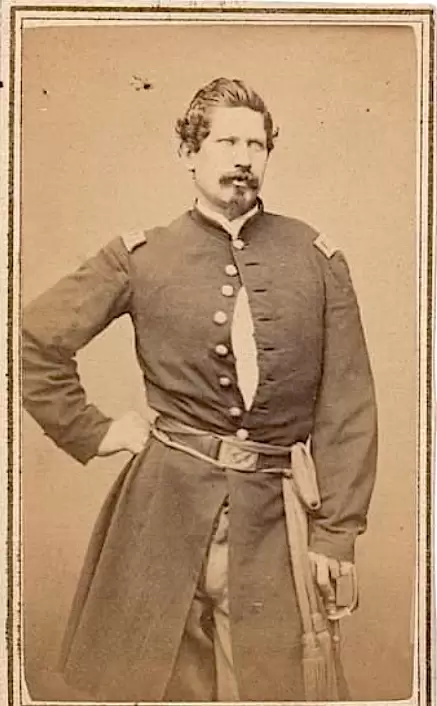
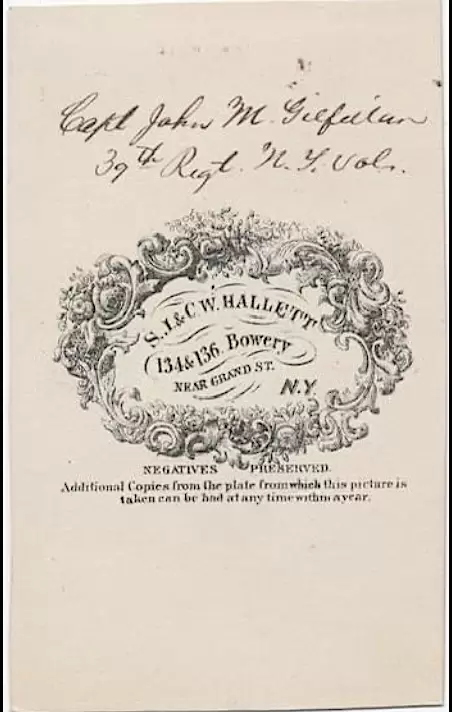
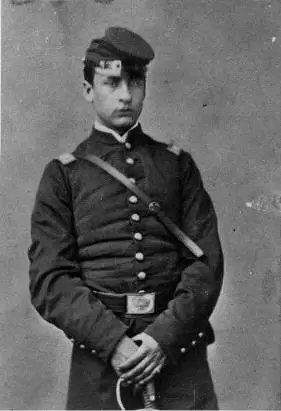
GILFILLAN, WILLIAM H. (1842-1863). Captain, 43rd New York Infantry, Companies G, C, and A. Gilfillan, a native New Yorker and resident of 134 East Broadway in Manhattan, came from a large family of seven children. In September,1853, his father abandoned the family, leaving his mother dependent on financial support from her children. He enlisted as a private on August 14, 1861, at New York City, mustered into Company G of the 43rd New York on September 16, and became a second lieutenant on January 24, 1862. Francis L. Vinton, the colonel and commanding officer of the 43rd Regiment, praised Gilfillan’s conduct in describing the action at Garnett’s Farm, Virginia, on July 10, 1862, when the soldiers, on picket, were under heavy fire at sunset for 45 minutes and 42 men were killed or wounded during the barrage. On July 18, 1862, he was transferred into Company C, was promoted to first lieutenant on September 19, 1862, and then to captain on June 2, 1863, effective upon his transfer to Company A. He was killed in battle at Gettysburg, Pennsylvania, on July 3, 1863, on the slope of Wolf’s Hill, the very end of the Union line, while leading Company A in flushing out snipers from the 2nd Virginia who were positioned in the woods there.
Many of Gilfillan’s Civil War letters survive, copies of which have been provided by Dan Armstrong, a direct descendant of Sam, William’s brother, and they provide a rare first-hand account of life on and off the battlefield. The letters show a man whose family was never far from his thoughts, even as he confronted the reality of war. He frequently speaks of his love for his family and his special affection for his mother and worries about her well-being. He often asks for news from and about them and tells of his happiness at receiving letters from home. Almost all of William Gilfillan’s correspondence is addressed to his mother Mary, who lived on East Broadway in New York City, and many conclude with “from your ever loving son.” Only two in the collection of letters are to others: one to his brother Sam, the other to his sister. The excerpts and letters below are in the original words.
Gilfillan’s letters from 1861 describe his thoughts early in the War. Writing from home to his brother Sam on July 26, 1861, he confides that he has to “keep the papers from her [our mother] that have any news” about the fighting, but reports that “Joseph Perly and Jack where [sic] both in the action at Bulls Run but both came out safe.” He adds that “Jack will go out as 1 Lieut of a volunteer Co. under Capt. Bill Mathews who you know is a military man having served under Walker in Nicaragua.” In a letter dated September 13, 1861, Gilfillan writes to his mother from Washington about his mustering: “we started from New York Friday night at 12 oc’lk and did not get into Phil. until 12 o’clock Saturday when we got dinner and then started for Washington passing through Baltimore….We expect to be here about a week before we cross the Potomac.” In this letter, as in many others, he adds that “John [see] is well.”
In the following letter to his mother from Camp Graham in October 1861, he lets his mother know about his life as a soldier:
Dear Mother,
I am well and hope this finds you the same. I am getting along finely as a soldier. My health was never better. We have had 3 days wet weather but my tent is as dry as my old room and I have 2 blankets and plenty of straw to sleep on. I have got acquainted with the surgeon of our regiment doing a little writing for him. He has taken a great fancy to me. I caught cold when we were crossing over the Chain Bridge as we had to stand in the wet about 4 hours and I took some syrup he gave me which cured it__. You can tell Sarah that I have plenty of clothing and that we are to get a new suit in two weeks. But I must close as this paper is a little damp I am afraid you won’t understand what I have wrote. Give my love to Aunt Sally and all kind friends not forgetting yourself. Tell Miss Blakely that I wish I had some of her books here as books are a luxury here. Tell Lizzie she must write to me.
From your loving son,
William
PS I am getting so selfish that I forgot to mention John in either of my letters. He is well and is getting along finely.
Making sure his mother has enough money to live on is a constant concern that he reveals in several of his letters. Writing from Washington on November 7, 1861, he says that he has deposited $15 for her at the Adams Express Company and that “I would like to have send [sic] more but I only receive $17 per month and Government would not pay me for more than 1 month and 3 days which was about $18.” He continues, “Capt. Mathews arrived here with 20 Recruits on Monday.” On November 22, he admonishes his mother not to save for him the money he sent her: “You have always supported me and now that I am of an age able to work and able to send a little money to you I want you to use it.” He boasts of “the cosy [sic] little tent I have with a stove built in the ground” and the bed and mattress that he has constructed.”
It would be several months before he left his camp near Washington, Camp Griffin. “We are still encamped at the same place [Camp Griffin] and I think we will be here for some time,” he writes on December 8, 1861. This letter is also noteworthy for containing a sketch of his uniform stripes. On December 16, Gilfillan tells his mother that the regiment has “been pretty busy building log houses for the winter,” and reports some trouble with the regiment’s sutler who “has been in the habit of charging double prices for everything he sold.”
In a letter dated mid-March 1862, from Flint Hill, near Fairfax Court House, Virginia, he writes his mother that his regiment has finally left Camp Griffin “to meet the enemy but they had left Manassas and retreated. 2 Regs of Cavalry now occupy the Battle ground (Bull Run). We expect to move tomorrow morning.” He also mentions that he has “just been officially notified of my appointment as 2nd Lieut.”
Writing from a camp near Alexandria, Virginia, on March 16, 1862, he remarks to his mother about the “Pretty sight” of the soldiers marching by:
Dear Mother,
I have at last a chance to write to you. We left Camp Griffin last Monday morning and have been strolling through Virginia ever since. The first night we camped near a place called Flint Hill about 1 and a half miles from Fairfax Courthouse. We then shifted about 4 miles the other side of Fairfax and yesterday morning we passed back through Fairfax to here on our way. As we suppose to take transports to go and join Burnside. Our camp is right on the side of a road and it is really a pretty sight to see the soldiers pass by us there must have been 6,000 of them, some going to the same place as we are and some going to take the places we had left in the Army of the Potomac. There is several New York reg[imen]ts going with us among them the 14th of Brooklyn who we cheered as they passed by. Answer this is All perhaps I may wish from you is a pair of military boots and a sash but don’t buy them until I write to you again. John is well and in good spirits.
I must close as mail is waiting.
From your ever loving son,
William PS We have not got paid yet. I have just heard from John that we are to lay here 3 or 4 days and if you answer this as soon as you receive it I may get it. The reason we wait is there is not enough coal for transports.
Gilfillan expresses confidence about impending action in a letter from Camp No. 21 in the field, June 19, 1862: “We have not made any move yet against the enemy but I think we will in a few days. The Enemys [sic] are in greater force than we are and may defeat us though we have all confidence in Gen. McClellan.” In a revealing comment about his brother, he also reports that “John is getting along finely and I think is changing for the better in his conversation he doesn’t curse so much as he used to.”
Writing from a camp near Harrison Landing, Virginia on July 14, 1862, he expresses his concern for his mother’s well-being, makes requests for some personal wants and notes changes in the regiment:
Dear Mother:
The paymaster paid us today for 2 months. I send by Express $150.00 for you. You can use it for what you want it. Uncle Sam still owes me 2 months pay which we expect to be paid in the course of a week and then I will be able to send you $50 more and 100 to put in the bank. Now mother you must stop slaving and more. I have got a chance to do something for you Mother and you must have a servant. I received a letter from Sarah this morning the first one in some time and I was very glad to hear from home and sorry to her that you still fretted about us and that Lizzie’s cough was still bad. I wished I was in a position to render you independent for life. I will try at any rate.
John is well and so am I. He would send you something too but has got to get a new uniform and other things now but will send something the next payday. Enclosed you will find $10 which I wish you would get me a pair of military shoes high uppers size 7 and 2 fine summer Cambric shirts (color red) and also a box of Pomatum [hair grease]. John also want some shirts the same as mine about 3 for him and he will send the amount you pay for them. 11 Officers have resigned but I do not know whether there (sic) resignations will be accepted. They have different ideas about it. Some resign on account of Cannon Fever, some sick of this service, and some to get positions in the new new regt now forming in New York. If they are accepted, it will leave John Senior Captain with the first chance for Major. I perhaps will get the position of Adjutant or Quartermaster. Write on receipt of this and let me know how you are getting along and whether you have let the house (upper part). Inform Aunt Sally that I shall write a letter to her in a day or two and thank her for those papers she sent me. I don’t think we will leave here for a month or two. We are camped right on the bank of the James River. I send the money by Adams Express to you at 134 East Broadway. Remember me to Sam, Lizzie, Aunt Sally and Stewart and all the folks. Hoping to hear from you soon.
I am your baby boy,
Billy
In a letter dated August 1862, from the same camp near Harrison Landing, he mixes small talk about home with war-related news. Captain Mathews, mentioned a few times in earlier letters, appears again here: “I heard that Capt. Mathews is getting up another company in Schenectady. I think he had better stay out of the Service before he becomes disgraced.” In the same letter, Gilfillan expresses the opinion that “I don’t suppose that we will move from here in some time not until the new men called for come here anyhow which will take at least 3 or 4 months.” And he informs his mother that “some of our men who where [sic] taken prisoners have joined us again haveing [sic] been exchanged” and that “our company has been consolidated with Company C.”
Apparently, Gilfillan’s prediction about his stay at Harrison Landing proved incorrect, for he writes again from a camp near Alexandria, Virginia, on September 5, 1862. In this important letter, he tells his mother about the Battle of Second Bull Run:
our Regiment lay near Alexandria, Va. about 2 days when we where [sic] ordered up the road to a place nearer Fairfax Court House where we remained a day and a half while the fighting was going on at Manassas….we where [sic] ordered to the Battle but did not get there before 7 oclk when the fighting was decided and we could do nothing but [illegible] the rear we understood at the time that Stonewall Jackson was surrounded but that McDowell gave way on the left and then the Rebels came in on our Side however the Soldiers have got a Bad Idea of McDowell.
William Gilfillan expresses his opinion about what John, who had recently tendered his resignation, should do, in a letter from a camp near Sharpsburg, Maryland, written September 7, 1862: “John I suppose has got home by this time. I think if he would apply he could get the majorship of this Regiment. I wish he would try and get it.” And once again he looks to the future: “The General of our Brigade thinks that if we move from here we will go to Hagerstown about 10 miles from here where we will winter for the rest of the cold days.” Additional news about the war comes in a letter from a camp near Harpers Ferry, Virginia, on September 16, 1862:
We have not been engaged with the Enemy yet though the Division next to us had a brush yesterday morning and the night before and took about 1000 prisoners. We are [illegible] in a beautiful Valley in the Blue Ridge Mountains (a Place called Pleasant Vale) about 6 miles from Harpers Ferry which we have just heard has surrendered to Stonewall Jackson. Gen. Burnside though who is on our Right has counteracted this and has taken 15000 prisoners. I do not suppose we will be engaged. We are acting as the Reserve Corps and don’t get a shot at the Rebs.
However, two days later, on September 18th, he writes from the battlefield:
our Regiment supported a Battery all day yesterday but we had no body hurt though the enemy hurled grape and canister at us but we lay down and it whent [sic] over us. We beat the Rebels badly killing Gen. Early and several other Rebel Generals the field in front of us is covered with their dead and wounded.
In the last letter in the collection from William, he writes his sister from Fairfax Court House, Virginia, on June 19, 1863. The subsequent letters are from comrades. “We left Fredericksburg Saturday Eve 13 inst and commenced the pursuit of Gen. Lee who we understand has marched into Pennsylvania we have had some severe marching 2 nights and a day without rest as we had to keep up to the wagons. We feel satisfied that Gen. Lee will have some trouble in getting out of Maryland and Pennsylvania.” The next letter, dated July 28, 1863, from a camp near Warrenton, Virginia, was written by a comrade and describes Gilfillan’s death at the Battle of Gettysburg:
I would like to have you know all his movements and will begin at the 1st of July the date of his last letter. On that day we went on picket between Manchester and Westminster about noon – at nine oclock p.m. we moved back and marched from there until about five p.m. July 2 when we reached the battle field of Gettysburg a distance of thirty seven miles. We were all very tired but as the battle was raging we did not get any rest ‘til darkness put a stop to the fighting….I had only lain a few moments when we got the order to fall in…we moved off to the right of our army to drive back the enemy’s skirmishers and establish a picket line. As soon as we approached the place where the enemy were supposed to be the right (Co. A. Billy’s) and left companies were ordered forward…they had only started when the firing commenced and the balls went over our heads as we advanced…. (the left company) had to advance through an open field and though the balls flew thickly past them none were hit. William’s Co. moved forward through a woods the enemy was nearer than they expected and in strong force concealed behind rocks and trees. To enable you to form an idea of how the Regt. was posted I will make this [here the letter writer sketches the battlefield]. You will see that my Co. is some distance from Co. A….William and one man in his company were killed almost immediately….William was struck below the Stomach the ball passing out of his back. He did not suffer much pain I’m sure from his appearance.
His mother applied for a pension in September, 1863, number 32,032. The men of the 43rd felt close to their captain and, when they visited the boulder where Gilfillan was propped against as he lay dying, the veterans placed shards of granite as a memorial to their fallen leader. His name appears on a monument to soldiers and officers from New York who fell at the Battle of Gettysburg. Section 162, lot 14181.
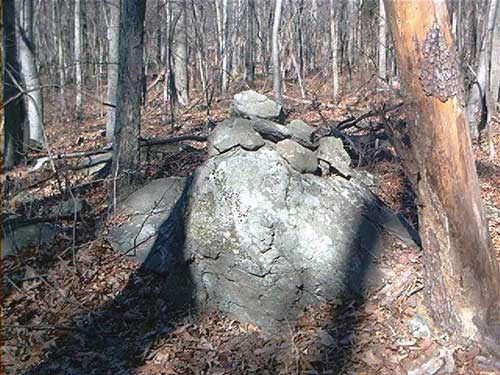
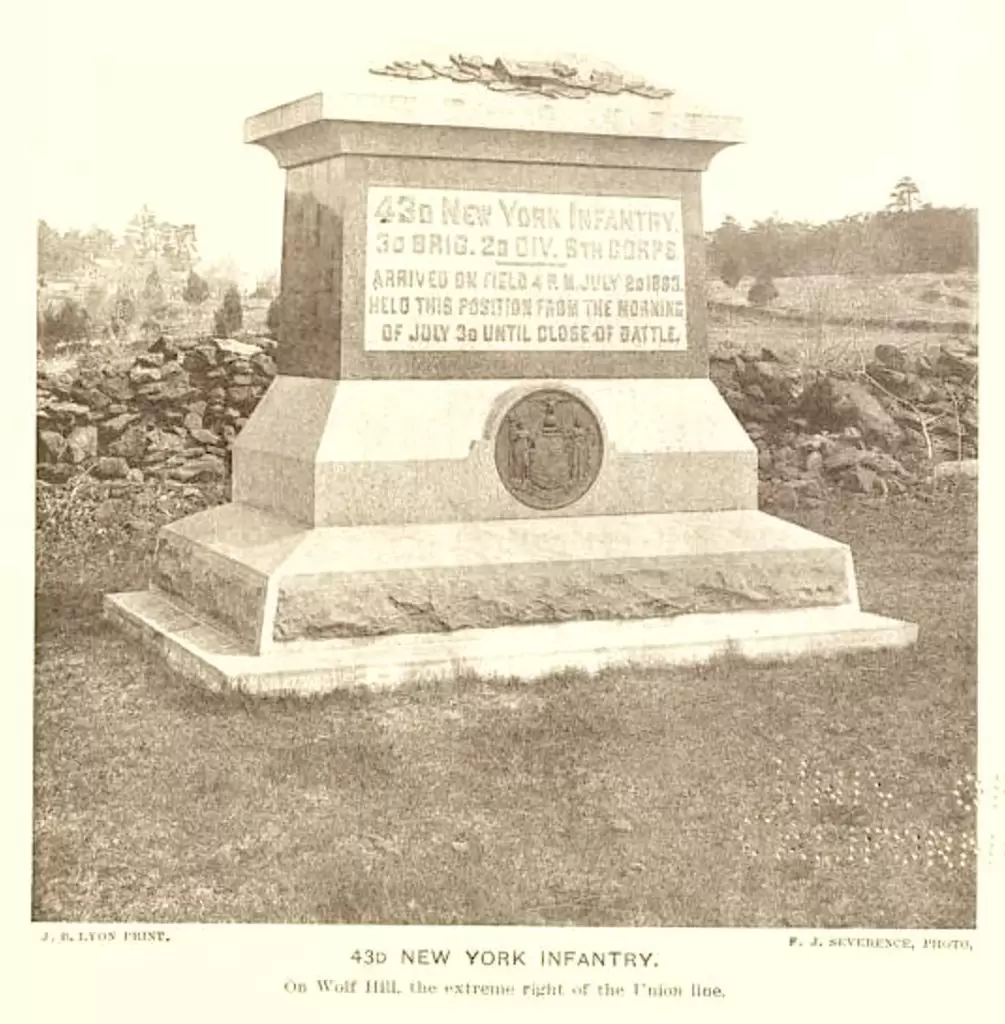
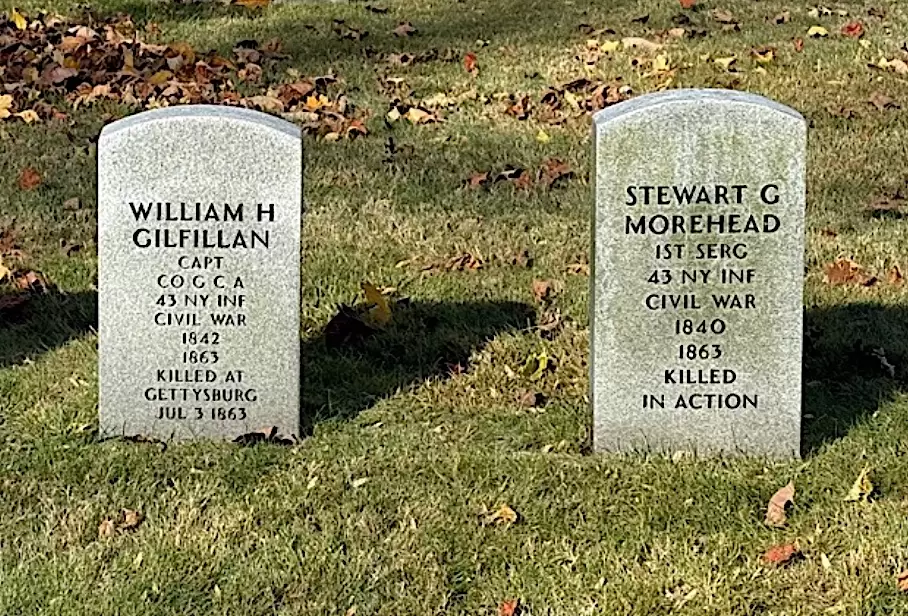
GILFILLAN, WILLIAM J. (1839-1906). Acting assistant surgeon, United States Navy. According to his written answers to Navy Examination Board questions, dated March 27, 1863, he was born in Londonderry, Ireland, and studied “Mathematics, English Grammer, Geography, and a little philosophy . . . and studied Latin and some Greek.” He reported that he had graduated from Queen’s College there, immigrated to Brooklyn in 1855, studied medicine under Dr. Alexander Cochran, then entered the College of Physicians and Surgeons at Columbia, graduating in 1860. He also wrote to the Examining Board that “I have had one year’s experience, as resident Surgeon in the Brooklyn City Hospital.” In response to a question on the exam about the classification of wounds, he wrote: “Wounds are divided into Incised, Lacerated, Punctured & Poisoned some add Gun shot wounds.”
After he successfully completed his written Naval examination, he served as an acting assistant surgeon in the Navy, aboard the USS Nipsic, from April 17, 1863, through December 27, 1864. After the war, he worked as a doctor at Brooklyn City Hospital, entered Columbia Law School in 1867, and graduated in 1869, but did not practice law. At the time of his death, which was caused by nephritis, he lived at 1905 86th Street in Brooklyn. Section 21, lot 10487.
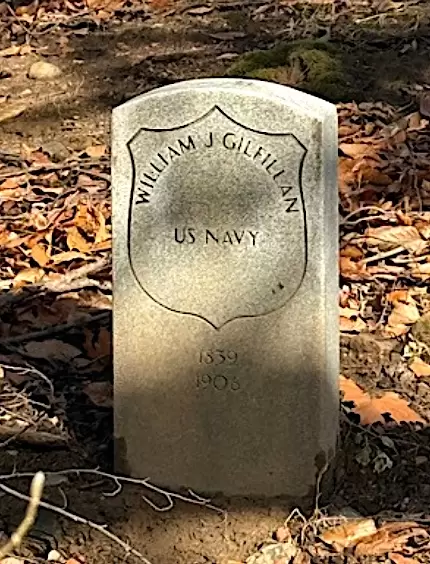
GILL, ROBERT (1826-1906). Second lieutenant, 6th New York Infantry, Companies C and K. A New Yorker by birth, he served in the Mexican War. The census of 1860 states that he was a machinist. At the start of the Civil War, he enlisted as a sergeant at New York City on April 25, 1861, and mustered into Company C of the 6th New York five days later. He was transferred to Company K, rose through the ranks becoming a sergeant major on May 25, 1861, and transferred into the Field and Staff that day. On August 15, he transferred back into Company C and was promoted to second lieutenant. His commanding officer, Colonel William Wilson, recognized him and two others in his field report from Camp Brown, Florida, on October 14, 1861, noting “…the valuable assistance they rendered me in keeping my men in order, and their good behavior while under fire of the enemy.” Gill applied for and was granted an invalid pension in 1894, certificate 931,204. As per the census of 1900, he was working as a machinist. He last resided at 117 Longwood Avenue in the Bronx. His death was attributed to “old age.” Section 61, lot 3665.
GILLESPIE, BENJAMIN P. (1844-1902). Private, 149th New York Infantry, Company C; 102nd New York Infantry, Company E. Gillespie was born in New York City. After enlisting as a private at Fishkill, New York, on February 8, 1865, he immediately mustered into the 149th New York. As per his muster roll, he was a clerk who was 5′ 6″ tall with hazel eyes, brown hair and a fair complexion. Gillespie transferred into the 102nd New York on June 10, 1865. He mustered out on July 21, 1865, at Alexandria, Virginia. The 1877 New York City Directory and the censuses of 1880 and 1900 indicate that he was in the hardware business. His last address was 2322 Eighth Avenue in Manhattan. Gillespie died of pneumonia. Section 192, lot 27557, grave 3.
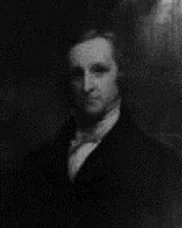
GILLETTE (or GILLET, GILLETT), AVRAM DUNN (1807-1882). Reverend and consoler to Lewis Powell, co-conspirator of John Wilkes Booth in the assassination of John Wilkes Booth. The Reverend Dr. Avram Dunn Gillette, who was born in Washington County, New York, was drawn to religion as a teenager and baptized in May 1827. He pursued his higher education at Madison College in Hamilton, New York. From 1831 to 1835, he was pastor of the First Baptist Church in Schenectady, New York, increasing the worshipers from 60 to 600. He then led Baptist congregations in Philadelphia until 1858 where he edited notes about Baptist history in Philadelphia from 1707 through 1807. He relocated to New York City until 1864.
During the Civil War, his sons, Walter (see) William (see), fought for the Union. Reverend Gillette moved to Washington, D.C., in January 1964. On April 25, 1865, his sermon in Washington, D.C., noted the feelings of all people around the world about President Abraham Lincoln’s death. He began:
When the Executive head of a great nation falls, all nations become mourners; for they know that the ruler they look to, to carry them on in improvements and give them desirable perpetuity and stability upon the earth, is also a man, and must ere long die, and may be called to his dread account in a moment least expected, and when they seemed most to need his guiding hand in the affairs which so vitally concern their common and individual good.
Gillette, however, is best known for his spiritual connection to Lewis Powell, one of the co-conspirators of John Wilkes Booth, the assassin of President Abraham Lincoln. Powell’s lawyer, William E. Doster, testified that his client, “at the time had no will of his own, but had surrendered his will completely to Booth.” Powell was found guilty of conspiracy and attempted murder for the knife attack on Secretary of State William Seward and sentenced to hang. Powell first met Gillette, the local Baptist minister, after receiving his sentence and the night before his execution by hanging. The two prayed together and Powell supposedly told Gillette that he had worked with the Confederate secret service in the months before the assassination. Powell reportedly confided to Gillette that his favorite hymn was “The Convert’s Farewell.”
As per “A Knock on Rev. A.D. Gillette’s Front Door” in Alias “Paine” by Betsey Ownsbey, Gillette received a knock on his door on July 6, 1865, by Assistant Secretary of War Thomas T. Eckert with a request for Gillette to visit the arsenal where Powell was being held. The following exchange occurred:
Upon reaching the Arsenal, the perplexed but willing and kindly minister was conducted at once to Powell’s cell. The good clergyman knew nothing of the condemned man and was “much concerned to learn why he had chosen him, a loyalist, in preference to other clergymen of his own faith who were in admitted sympathy with the Southern Cause.”
Powell explained that he had heard him preach not long before:“Do you remember a bitter, sleety Sunday last February, when you preached in the Reverend Dr. Fuller’s church in Baltimore? It was then I heard you. I sat with two ladies in one of the end pews to the right of the pulpit. There were scarcely more than a score of people in the church as the walking was so icy and dangerous. My companions and myself were the only occupants of the end pews on either side of the chancel. I had hoped that perhaps you might remember the circumstances, as you frequently turned towards us as if addressing us.” (According to the “Local Matters” section of the Baltimore Sun for February 13, 1865, this would be Sunday, February 12.)
Powell related to Dr. Gillette that he was the son of a Baptist minister and in conversation pertaining to his mother and family, broke down in tears, weeping bitterly for the first time since his sentence had been pronounced.
In conversation with Powell, Dr. Gillette claimed that the prisoner told him that:“he thought he was doing the right thing in attempting to kill Secretary Seward, as he still claimed to be a Confederate soldier; aside from that, he admitted that he believed it would give peace to the South. He thinks now that it was all wrong, and blames the Rebel leaders for his death, though he did not fear to die. Several times he expressed his thanks for the kind treatment which he received from officers while in the prison. He stated that he was led into the conspiracy by Booth and John Surratt.
Powell continued to agonize over Mrs. Surratt, telling the Reverend Dr. Gillette: “She at least, does not deserve to die with us. If I had no other reason, Doctor – she is a woman, and men do not make war on women.”
Dr. Gillette was impressed with Powell’s intelligence in direct contrast with the newspaper accounts that portrayed him as a coldblooded killer with a moronic mentality. Lewis requested the clergyman to write his parents and tell them he had repented and had his hope of heavenly – if not earthly – pardon. Throughout the long night, the prisoner took special advantage of Dr. Gillette’s ministrations, alternately praying and weeping. His last prayer was, as suggested by his friend, Dr. Gillette, “Lord Jesus, receive my spirit.” Finally towards dawn, emotionally drained, Powell was able to get about three hours of sleep.
Although Gillette never discussed his conversations with the convicted man, his son wrote that Powell’s death had a profound effect upon his father. Rev. Gillette left Washington, D.C., in 1869, traveled abroad for a year, and settled in Brooklyn in 1870. He later served the Baptist church in Sing Sing, New York, and took sick in 1880. The census of 1880 indicates that Gillette was a “minister of the gospel” in Washington County, New York. He died in Lake George, New York. Section 45, lot 11380.
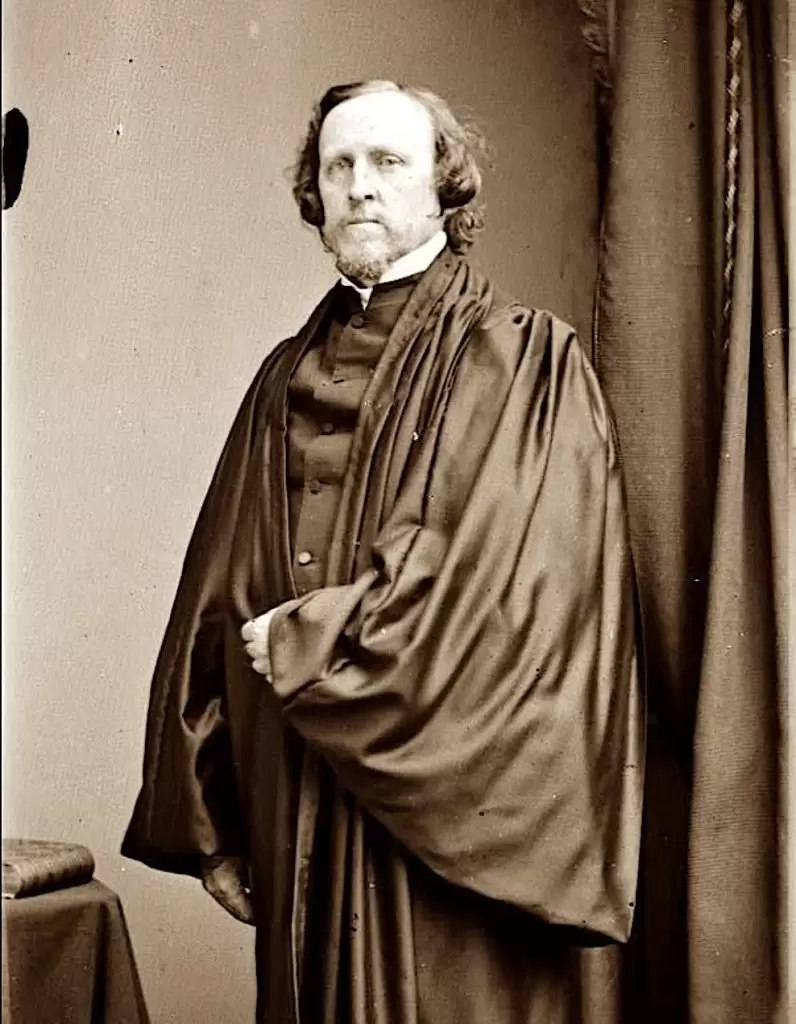
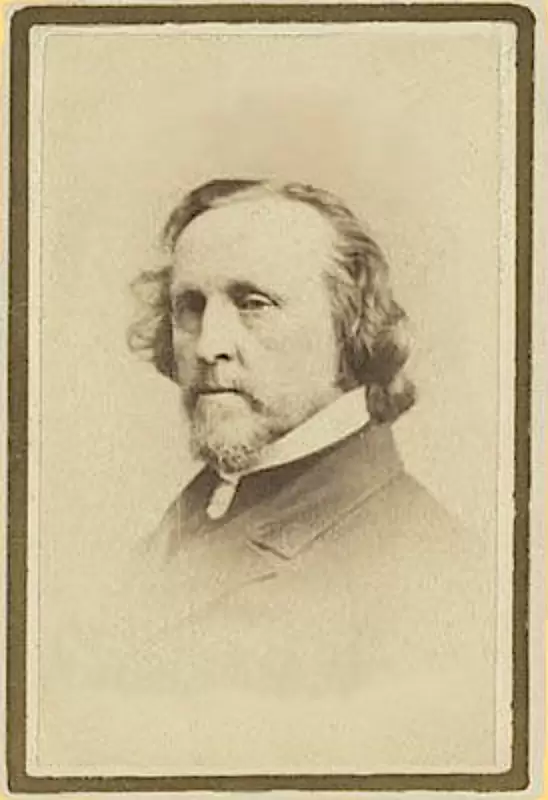
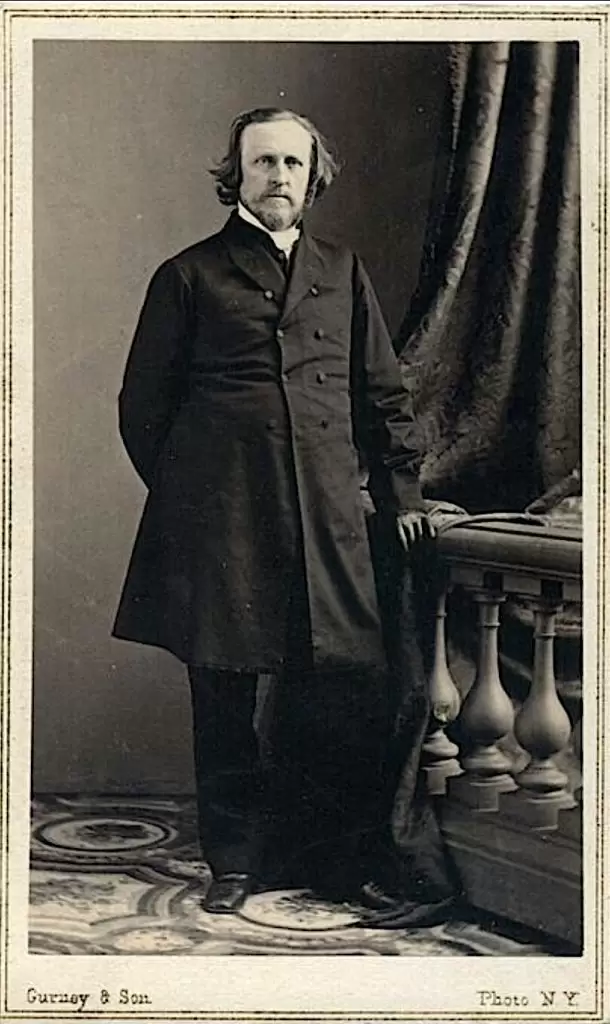
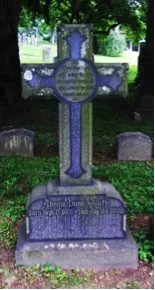
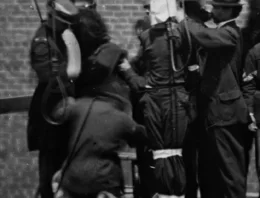
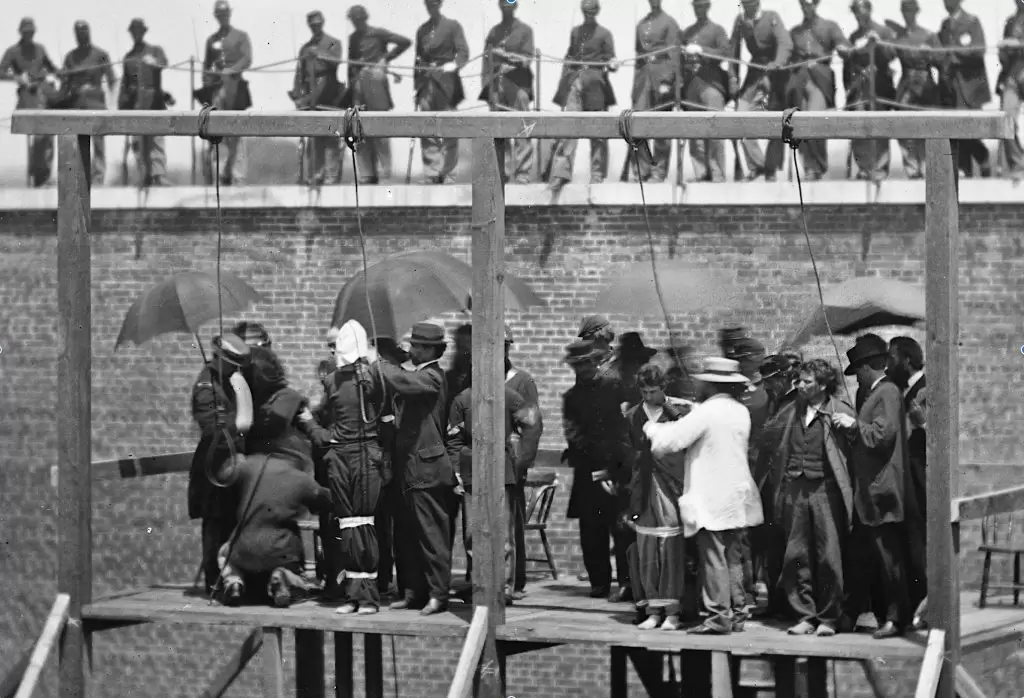
GILLETTE, WALTER ROBARTS (1841-1908). Surgeon, United States Army. Originally from Philadelphia, Pennsylvania, where he attended medical college, his father was the Rev. Dr. Avram Gillette (see). According to his wife’s obituary in The New York Times, he served as a surgeon during the Civil War. After enlisting in 1861 as a surgeon at Philadelphia, he served the Union Army until his discharge in 1865.
After the War, he worked as vice president of the Mutual Life Insurance Company and was a consulting physician at Bellevue, St. Francis, and the Maternity Hospitals. His last residence was 24 West 40th Street in Manhattan. He died of cancer. He was the brother of William P. Gillette (see). Section 45, lot 11380.
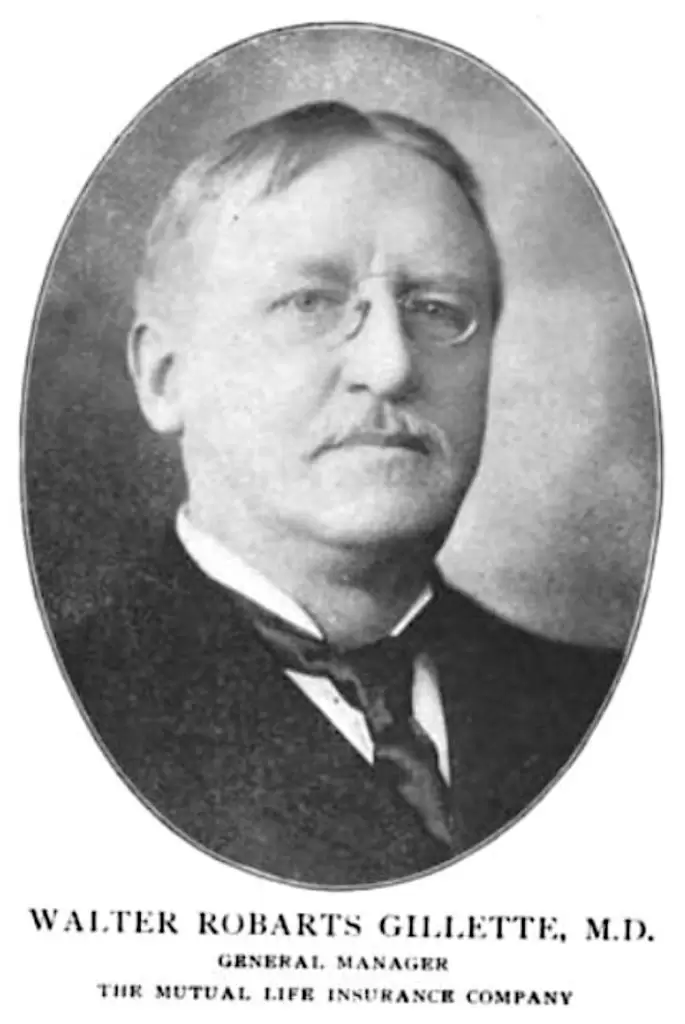
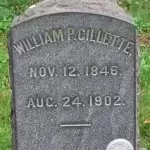
GILLETTE, WILLIAM POST (1846-1902). Rank unknown, United States Volunteers, Commissary Department. Born in Philadelphia, Pennsylvania, his father was Rev. Dr. Avram D. Gillette (see). William Gillette was educated in New York City. During the Civil War, he entered the Commissary Department, and later took part in Sherman’s March to the Sea.
In civilian life, Gillette worked for the federal government in Washington, D.C., the Post Office, and then was the manager of the brokerage firm of L. W. Minford & Co. on Wall Street. The 1900 census reports that he was a stock broker. According to his obituaries in The New York Times and the New York Herald, which confirm his Civil War service and note that he was present at many of the great battles of the War, he was a member of the Colonial Club and the New York Athletic Club. According to family history, two of Gillette’s brothers were held in Confederate prisons. His brother, Walter Gillette (see) was a Civil War veteran. He last lived at 240 West 72nd Street in Manhattan. He died of typhoid fever. Section 45, lot 11380, grave 14.
GILLIES, WILLIAM (1834-1916). Private, 20th Infantry, United States Colored Troops, Company G. Gillies, an African-American born in Norfolk, Virginia, was 5′ 8″ with a dark complexion, and black hair and eyes. A farmer by trade, he enlisted at New York City as a private on December 23, 1863, and mustered into the 20th United States Colored Troops (USCT). He was discharged on March 5, 1864, by order of Major General Dix without pay or allowances based on a surgeon’s certificate of disability and disease contracted before entering the service. His name is displayed on the African American Civil War Memorial in Washington, D.C., plaque B-37. He last lived on Avenue L in Brooklyn. The cause of his death was Bright’s disease. Section 181, lot 10214.
GILMAN, GEORGE (1832-1901). Private, 170th New York Infantry, Company C. Born in New York City, Gilman enlisted there on September 12, 1862, mustered into the 170th New York on October 7, and was absent and listed as sick when his company mustered out of service at Washington, D.C., on an unknown date. His last residence was 447 Pacific Street in Brooklyn. Gilman died of Bright’s disease. Section 136, lot 28307, grave 108.
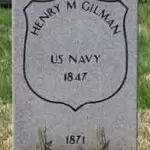
GILMAN, HENRY M. (1847-1871). Mate, United States Navy. Gilman entered the Navy as a mate on June 22, 1863, and resigned three months later, on September 30. He was living at 315 Franklin Avenue in Brooklyn when he died of consumption. Section 81, lot 3228.
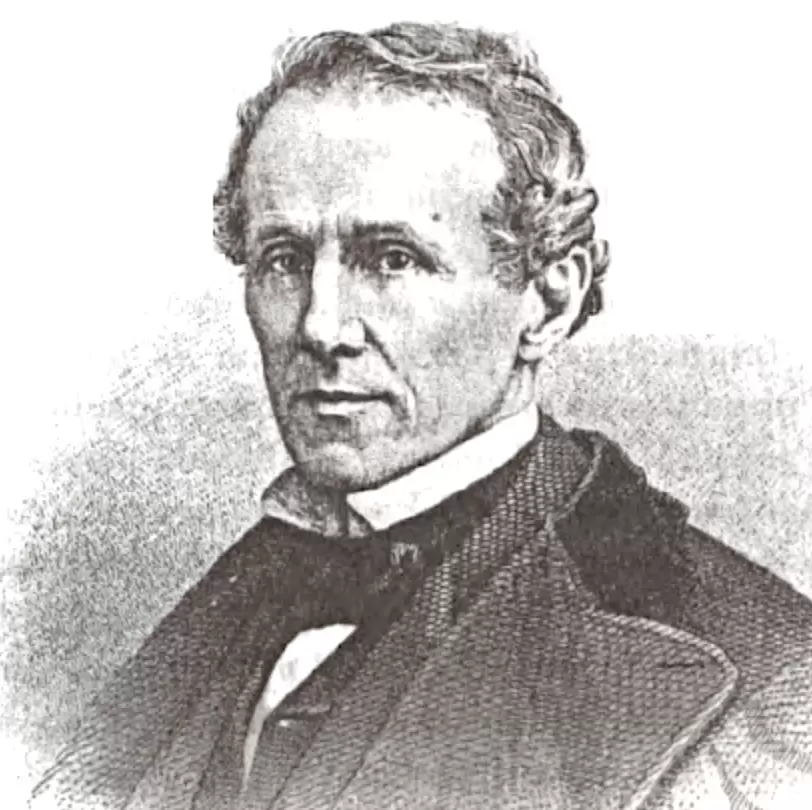
GILMAN, WINTHROP SARGENT (1808-1884). Abolitionist. Born in Marietta, Ohio, his paternal ancestry could be traced to Exeter, New Hampshire, where his father graduated first in his class at the renowned Phillip’s Exeter Academy. According to his obituary in The New York Times, he was educated in New York City and Philadelphia, Pennsylvania, and returned to the West in 1830, opening a wholesale grocery business in St. Louis, Missouri. He was known as an “original abolitionist,” but was not an outspoken one. In 1837, Gilman allowed the abolitionist newspaperman Elijah Parish Lovejoy to hide his printing press in one of Gilman’s warehouses in Alton, Illinois. A mob soon burned the building and killed Lovejoy. Gilman wrote a letter to Henry Tanner, a leading abolitionist in Alton, describing that event:
It is well known that in 1836, the abolition of slavery in the Southern States became a subject of intense feeling. As the eyes of the Northern people opened to see the evils of slavery they began to discuss the subject and form Abolition societies. This provoked the hostility of the South, and the right of discussion, the right of petition on the subject, and the right to send Abolitionist publications through the mails were denied….
After noting that Lovejoy lost two presses and calling him a conscientious Christian, able writer, and a moderate by abolitionist standards, Gilman had agreed to let him store his press in Alton:
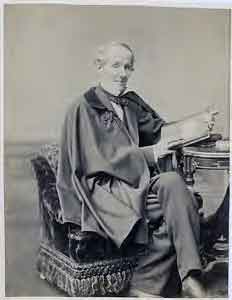
I resided at Alton at that time, though I was a not a member of an abolition society. I knew nothing of this fourth press until after it was shipped, but opened our warehouse at midnight, November 6, 1837, and had it snugly packed away in our third story, guarded by volunteer citizens with their guns. All arrangements were made with the Mayor’s sanction. He told us he would make us special constables and would order us to fire on the mob if we were assailed. The result is a matter of history.
Gilman refused to give up the press, and said it was a mob with “arms and hootings, with tin horns blowing, and plenty of liquor flowing among them.” After Lovejoy was killed, the press was surrendered, and those who guarded it escaped. Following these riots, Gilman moved to New York City where he entered his family’s banking business, Gilman and Sons at 47 Exchange Street (later moving to 62 Cedar Street) in Manhattan. That firm dealt in many real estate and other ventures across the country.
In private life, he loved science and built an observatory at his home in Palisades, New York, where he studied meteors. His family had numerous connections to education, associating with the Browns in Rhode Island who were the founders of Brown University there. Winthrop Gilman’s son, Arthur, was a founder of Radcliffe College in Cambridge, Massachusetts. He died of meningitis. His widow, Abia Swift Lippincott Gilman, narrowly escaped burning to death in 1900 from a gas-light torch in front of the Scribner mansion on East 38th Street. Section 118, lot 11666.
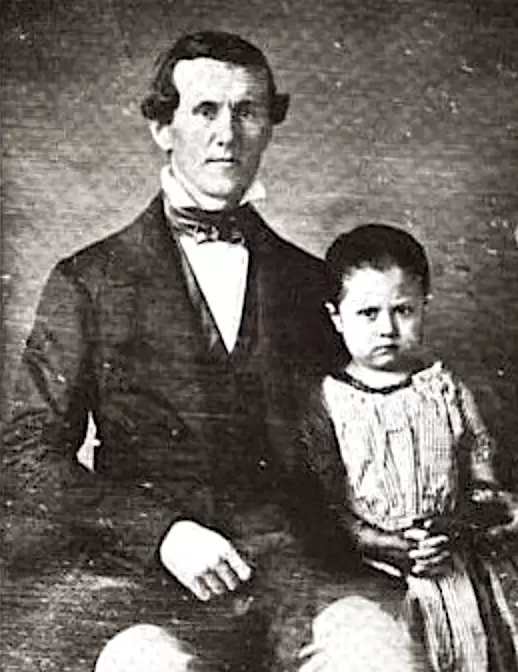
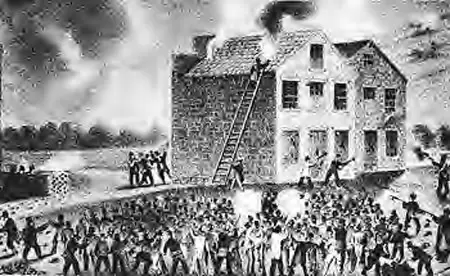
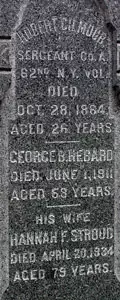
GILMORE, ROBERT (1838-1864). Sergeant, 62nd New York Infantry, Company A. Born in New York City, he was a carpenter by trade. He enlisted as a private on February 1, 1862, and mustered into the 62nd on February 14. According to his muster roll, he was 5′ 5″ tall with blue eyes, sandy hair and a light complexion. He re-enlisted on February 19, 1864, was wounded on May 6, 1864, at Wilderness, Virginia, and had an intra-regimental transfer to the Field and Staff on August 20, 1864, at which time he was promoted to sergeant. Wounded in battle by a gunshot to the right hip at Cedar Creek, Virginia, on October 19, 1864, he died nine days later, and was interred on November 15, 1864. Section 206, Lot 31234, grave 10.
GILMOUR, JAMES (1836-1915). First lieutenant and adjutant, 79th New York Infantry, Companies C and I. A native of Scotland, he came to the United States as a youth. After enlisting as a private on January 19, 1862, he mustered into Company C of the 79th New York, also known as the Highlanders. He was promoted to first lieutenant on May 12, 1862, effective upon his transfer that day to Company I, was praised for his actions at Bull Run, Virginia, and received a promotion to adjutant on October 16, 1862, at which time he transferred into the Field and Staff. Gilmour was captured on July 10, 1863, at Jackson, Mississippi, and then incarcerated at Macon, Georgia, and Columbia, South Carolina, from which he escaped on November 15, 1864, and where, according to his soldier record, he signed a petition complaining about conditions at Camp Sorghum. The history of the Highlanders recounts the exchange that occurred when Gilmour was first captured, at which time his horse and pistol were taken, but not his watch, $30, or his boots. He was the last Union survivor who dug his way out of the infamous Libby Prison in Richmond, Virginia, on December 8, 1864. As per his obituary in the New York Herald, he was among a group of prisoners who dug a tunnel under the prison walls as a pathway to escape. That same obituary notes that he was at Libby Prison for 18 months. On December 24, 1864, he mustered out.
A member of the Caledonian Club, Gilmour was the son-in-law of General David Morrison (see) and also was his associate in a plumbing supply business. In 1882, his application for an invalid pension was approved, certificate 303,897. He last lived at 164 West 120th Street in Manhattan. His death was attributed to acute gastritis. According to his obituary, Colonel Baird, Captain Garr, and Captain Stewart, and other veterans of the Highlanders attended his funeral. In 1915, Mary Gilmour, who is interred with him, applied for and received a widow’s pension under certificate 804,450. Section 153, lot 20179.
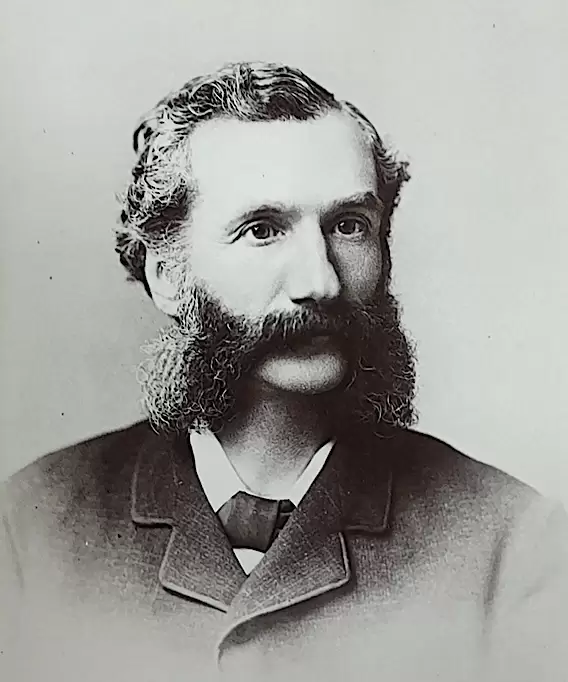
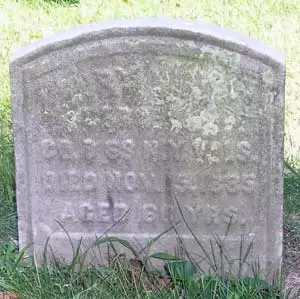
GIMPEL, HENRY (1824-1885). Private, 8th New York Infantry, Company H; New York Independent Battery; 68th New York Infantry, Company B. Born in Germany, he was listed as a tailor on the census of 1855. During the Civil War, he enlisted on August 15, 1862, at New York City, and mustered into the 8th New York. As per his muster roll, he was a tailor by trade who was 5′ 4″ tall with gray eyes, dark hair and a dark complexion. He was transferred to the New York Independent Battery on April 23, 1863. On April 5, 1864, he was transferred to the 68th New York.
According to the census of 1870, Gimpel worked as a saloon-keeper; the New York City Directory for 1876 reports that he was in the beer business. At the time of the census of 1880, he was a clerk in his son’s trimmings business. He was the father of Henry Gimpel (see) who was a drummer boy. His application for an invalid pension was approved in 1885, certificate 371,939. His death was caused by pleuritis. As per his obituary in the New York Herald, family and friends were invited to meet the body at the gates of Green-Wood Cemetery for his burial. Hermine Gimpel, who is interred with him, applied for and received a widow’s pension in 1886, certificate 236,558. Section 187, lot 31682, grave 10.
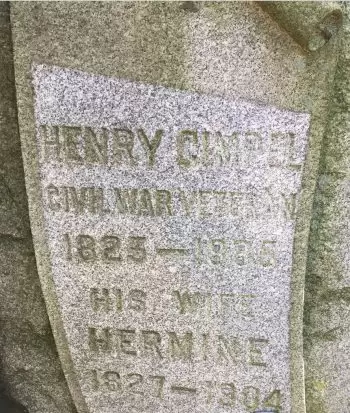
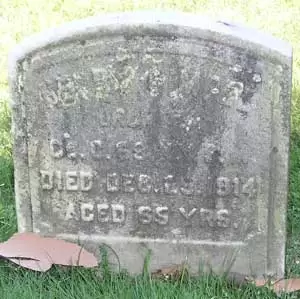
GIMPEL, HENRY (1849-1914). Drummer boy, 69th New York Infantry. Originally from Cassel, Germany, the family immigrated to the United States when Henry was an infant and he was educated in the New York City schools. His father, also Henry Gimpel (see), served in the Civil War. During the Civil War, young Henry was a drummer boy for the 69th New York from July 6 until October 6, 1864. After the War, he retained his interest in military affairs and was a member of the 5th Regiment, New York State National Guard, rising through the ranks until he achieved the rank of lieutenant colonel as of December 4, 1877; he was known for his skill as a tactician.
In civilian life, the census of 1870 notes that Gimpel was a tassel-maker; the New York City Directory for 1876 indicates that he was in the silk trimmings business with a factory and show-room located at 403 Broadway. His obituary in the Brooklyn Daily Eagle, which confirms the Civil War service of both father and son, indicates that he was long associated with P. K. Wilson & Company, importers of hand-made lace. Gimpel’s braid-work, known as passementerie, involves silk braid or gold or silver cord embellished with beads and then applied to fabric. At the time of the 1880 census, he was a fringe manufacturer.
Gimpel was a member of the Steinwehr Post #192 of the G.A.R.; subsequently, he joined the Ulysses S. Grant Post #327. His obituary states that he donated a glass dome and wall decoration for the assembly hall of the Grant Post. He also belonged to the 5th Veterans Association and to German singing and cultural societies, including the Beethoven Maennerchor and the New York Turn Verein. In 1912, he applied for and was granted an invalid pension, certificate 1,168,067. At the time of his death, he resided at 934 President Street in Brooklyn. Members of the Grant Post gathered at his late residence with uniforms and gloves but without side-arms for his funeral. Julia A. Gimpel applied for and received a widow’s pension in 1915, certificate 788,505. Section 187, lot 31682, grave 9.
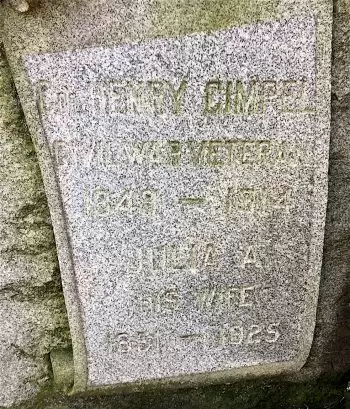
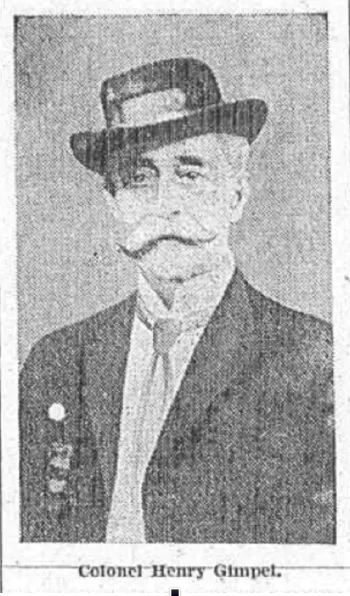
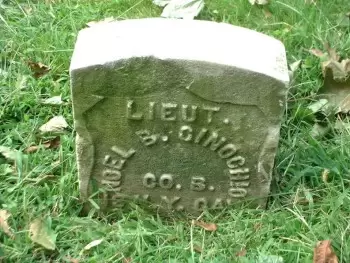
GINOCHIO, NOEL B. (1846-1915). First lieutenant, 25th New York Cavalry; second lieutenant, 13th New York Cavalry, Company B. Ginochio’s father, John, was a soldier in the army of Napoleon Bonaparte and a watchmaker and jeweler in New York City. A student before the Civil War, Noel Ginochio was 5′ 9″tall, 275 lbs. with blue eyes. He first served as a private. On March 22, 1863, he enlisted as a second lieutenant at New York City, was commissioned into the 13th on May 27, 1863, and was discharged for disability on November 25, 1863. He also mustered into the 25th New York Cavalry as a first lieutenant, but his muster-in was revoked by the War Department on May 12, 1864, and he was not commissioned.
The 1880 census lists Ginochio as a chemist but he was also an inventor. In 1890, he received a patent for a magneto-generator, a device that was intended to improve telephone communications. Through the use of magnets and pole-pieces, a continuous ringing of bells would be achieved. Ginochio also patented a telephone. In 1905, the New York State census listed him as a chemist. In 1907, he applied for and received a pension, certificate 1,144,524. On November 27, 1912, he was admitted to the Manhattan State Hospital for the insane. He last lived at 309 West 11th Street in Manhattan. Louise Ginochio applied for a widow’s pension shortly after his death from arteriosclerosis; it was granted under certificate 800,827. Section 99, lot 11650.
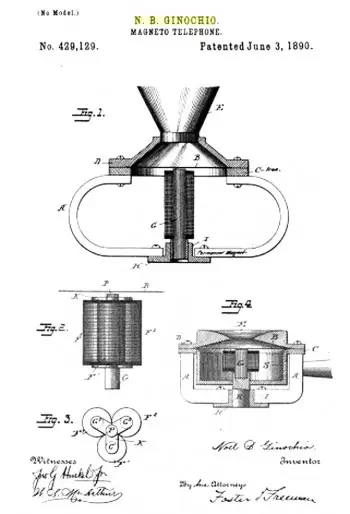
GIRAUD, PIERRE (1833-1875). Lieutenant commander, United States Navy. As per his obituary in The New York Times, Giraud, a New Yorker by birth, was educated in Poughkeepsie and chose to pursue a sea-faring life at the age of sixteen when he entered the mercantile marine service. By 1860, he was captain of the merchant steamer Saratoga. At the outbreak of the Civil War, he was appointed acting master of the iron-clad USS Montauk under Captain C. M. Worden. As per James W. Milgram and Gary McQuarries in their article “Acting Master Pierre Giraud: Passing the Confederate Forts Below New Orleans” in Civil War Navy (Spring 2022), he was appointed acting master and executive officer of the armed sailing ship USS Morning Light in November 1861. That vessel was initially oder to cruise the lower East Coast in search of Confederate privateers and blockade runners before it became part of the West Gulf Blockading Squadron in the early months of 1862. He was present at the engagement with the Confederate privateer Nashville when that vessel was blown up. Giraud was lauded for bravery at Fort McAllister and promoted to lieutenant commander. He was transferred to the USS Oneida in March 1862 andwas present at the attacks on Forts Jackson and Phillip and at the Battle of Vicksburg, Mississippi.
The Civil War Navy article includes an extensive letter that Giraud wrote to his parents from the Oneida on April 30, 1862, describing the aforementioned attacks on the forts. In his letter, with spelling as in the orginal, he wrote about the planned attack on the morning of April 24 that began at 2:00 a.m. :
…All was still and quiet. I had the charge of the forecastle & 3 forward guns, the most exposed position in the ship. I shall never forget the hour occupied in gowing from our anchorage to the rafts, when the forts opened fire on us. I felt that I should not live to see daylight. But at the same time, I was determined to fight to the last. At 3:20 the “Verona” and “Oneida” passed the rafts and were discovered at the same time both forts opened fire on us. We received 5 shot in our hull and strange to say, without injuring any one. A hundred pound rifled shot entered our port side and penetrated the opposite side. At 4:20 the “Verona” and ourselves passed ahead of all the fleet and received the fire of both forts fireing our broad sides in return, all that saved the “Oneida” was our passing about 200 feet from Fort St. Philip the shot from which passed over us. The two forts mounted 185 guns of the largest caliber the report of which no thunder storm could equal. I was so much taken up with my gun that I had no time to realize the danger. The smoke by this time became so dense that we could see but a few yards ahead of us. God was with us and we passed in safety.
At 4:30 we met and engaged the rebel flotilla 17 in number and then commenced the work of death and destruction, the “Manassas” ram started for us but mist [missed] his aim and passed about 30 feet ahead of us then came the gunboat “Star” we struck her going full speed striking her at aft the wheel house cutting her nearly in two, as she drifted by our XI in shell went through her boiler blowing her up, above the din of battle we could hear her crew cry for help, but nothing could save them. At that moment I discovered a large walker beam engine boat on our port fireing into us, one of my rifled guns was the only one I could bring to bear on her. I pointed and fired 8 rifled shells into her at pistol shot distance, every shot went through her killing and wounding a large number. Capt. [Samuel Phillips] Lee was the forecastle coning the ship at the time, called to me and said, well done Giraud give it to them.” I had my coat off and my face & hands covered with powder. At this time two of my men run from the gun, one of the steamers grape shot struck the foremast penetrating it 4 or 5 inches it must have passed very near me, after the 8 shots she took fire and drifted astern….
Then, Giraud was ordered to board the “Guv Moore” which had been grounded. He held a pistol to the Confederate captain who threw his pistols and sword overboard before surrendering and setting fire to the ship. Giraud wrote that the deck looked like a slaughterhouse with dismembered bodies. He was only able to take two of the wounded off the vessel before it blew up. Thirty-eight were killed or wounded on that ship. Giraud then told his parents that the USS Verona, his companion ship, had sunk with crew having abandoned the ship and cheering him and his men as they approached. All told, 25 were killed and 80 Union men were wounded in that battle which he called a “most glorious victory” for the Navy. He concluded his letter by relating that later that day, his ship sailed for New Orleans where Union forces took possession of that city and destroyed 10,000 bales of cotton at the shore and more than that on ships at or near that port.
The magazine article goes on to say that the Oneida destroyed obstructions above Carrollton, Mississippi, on April 27, 1862, in preparation for the Vicksburg campaign. In November 1862, he was transferred to the USS Montauk, an ironclad, and was aboard her when she destroyed the Nashville, a Confederate cruiser; he sailed under Lieutenant John L. Worden, whom he respected but told his parents that he was “excitable.” Worden praised Giraud for his bravery and efficiency during the naval attacks at Fort McAllister, Georgia. By April 1863, the Montauk was at Charleston, South Carolina, and Giraud was promoted to acting volunteer lieutenant on August 5, 1863, for bravery and conduct.
By November 1863, he was aboard the USS Tennessee attached to Admiral David Farragut in Mobile Bay, Alabama. Henry, one of his three brothers, served under him as an acting master mate on the USS Tennessee from November 17, 1873 until October 1864. In August 1864, when his vessel was unable to enter the harbor, Giraud volunteered to take command of the USS Ossipee, a wooden sloop-of-war, and captured the Confederate iron-clad Tennessee. That action earned him Farragut’s recognition; Farragut appointed him temporary commander of the USS Tennessee for the attack on Fort Morgan, and he was deputized to retrieve the sword of Admiral Franklin Buchanan, the wounded commander of the Confederate fleet. In other accounts of the latter incident, Giraud explained to Buchanan that Farragut was not aware that Buchanan was injured; an aide was summoned to bring the “surrender” sword. In addition, Giraud oversaw the transfer of the Confederate prisoners of war to the USS Tennessee (renamed the USS Mobile) and then to New Orleans, Louisiana.
The USS Mobile returned to the Gulf Squadron in September 1864 cruising for blockade runners but after damage by a gale in October, she was in poor condition. Farragut wrote a letter of praise to Secretary of the Navy Gideon Welles commending Giraud “as an excellent officer” who had “always acquitted himself well under my command.” On December 9, 1864, Giraud was promoted to acting volunteer lieutenant-commander and took the helm of the USS Huntsville. He was subsequently given command of the Lady Sterling, a captured blockade runner which was renamed the USS Hornet on June 17, 1865.
At the close of the Civil War, Giraud was appointed lieutenant commander on the USS Onward on its cruising voyage to Japan. He was honorably discharge from the Navy on January 15, 1869. As of 1870, he was appointed commander of the school-ship Mercury, a position that he held for four years. He last lived at 432 West 23rd Street in New York City. His death was attributed to enlargement of the heart. Section 72, lot 4259.
GISBURNE (or GISBURNES), THEODORE JAMES (1843-1917). Private, 8th Regiment, New York State National Guard, Company C. Originally from St. Ives in Cambridgeshire, England, Gisburnes served as a private in the 8th Regiment for 30 days in 1863–from June 17, when it was mustered into United States service and left New York City for Harrisburg, Pennsylvania, served in that area, then mustered out at New York City on July 23. Gisburne’s obituaries in the New York Sun and the Brooklyn Standard Union highlight his Civil War service reporting that he went to the front as captain of Company C of the 8th New York Infantry.
Gisburne was living in Brooklyn at the time of the 1870 census. As per the 1876 Brooklyn Directory, he worked as a ruler (a craftsman who ruled paper, etc.); the 1901 Brooklyn Directory indicates that he was a manufacturer of blank books. His book manufacturing business was on Vesey Street in Manhattan. He died at the home of his son at 90 71st Street in Brooklyn. Section 130, lot 34754.
GIVEN (or GRIFFIN, GIFFEN, GRIFFITH), CHARLES (1839-1875). Private, 2nd Connecticut Heavy Artillery, Company E. Given was born in Cullybackey in County Antrim, Ireland. After immigrating to the United States, he settled in North Tarrytown, New York. As a resident of Montville, Connecticut, he enlisted as a private on September 3, 1864, and was immediately mustered into the 2nd Connecticut Heavy Artillery. His name on the muster rolls was incorrectly listed as Griffin or Griffith. His descendants note that he actually enrolled as a substitute for Daniel Lathrop of Montville. Given was captured on October 19, 1864, at Cedar Creek, Virginia, when he was part of a group from his company that was detached from picket duty. After being imprisoned at Richmond, Virginia, for a brief period, he was paroled on February 28, 1865, hospitalized at Camp Parole in Annapolis, Maryland, and subsequently transferred to a hospital in New York before his discharge on June 13, 1865. He last lived in North Tarrytown, New York. He died of consumption. Section 15, lot 17263, grave 1242.
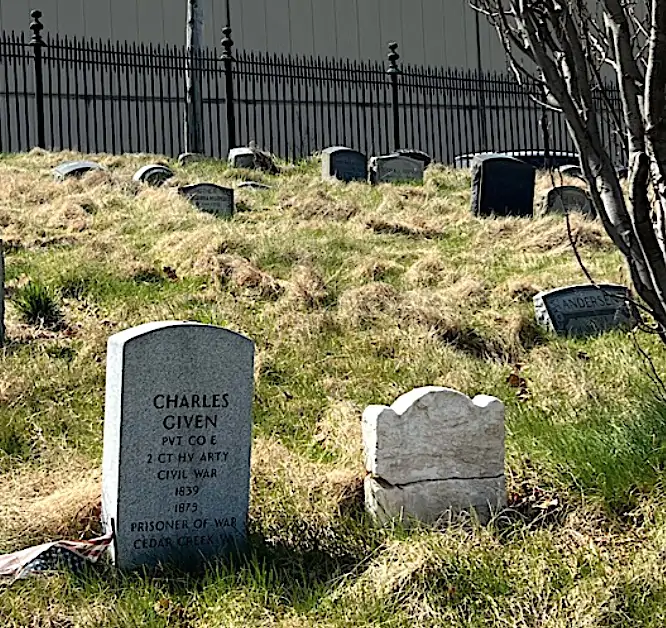
GLASBY, BENJAMIN (1827-1866). Corporal, 5th Rhode Island Heavy Artillery, Company E. Born in Providence, Rhode Island, he enlisted as a corporal on October 16, 1861, and mustered into the 5th Rhode Island Heavy Artillery two months later on December 16. He was wounded in New Berne, North Carolina, and discharged for disability on January 30, 1863. A skilled printer and compositor who learned his craft in Providence, he came to New York City where he was among those who set the type for the first volume of The New York Times. Glasby, a resident of Chatham Street, Manhattan, succumbed to the wounds he suffered in the War. Section 122, lot 8100, grave 1011.
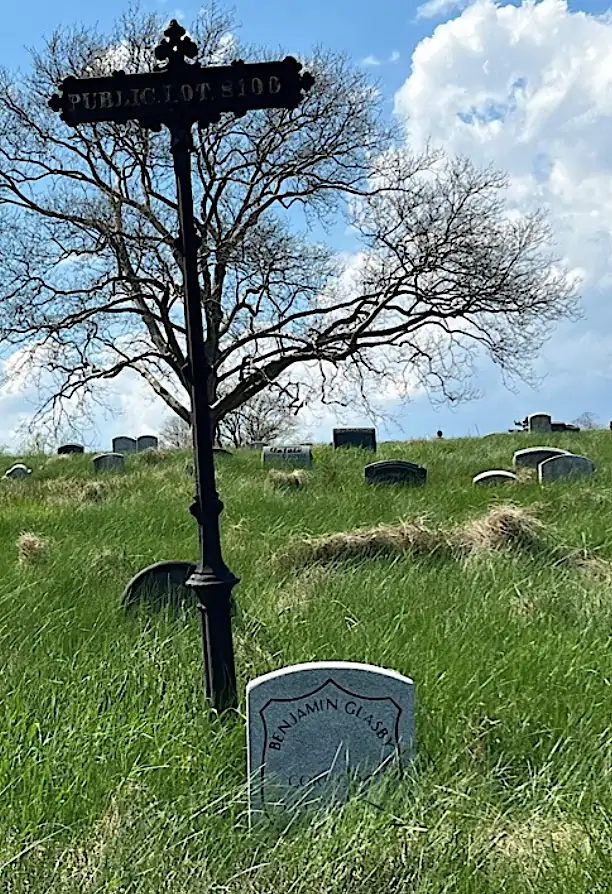
GLASS, ANDREW (1815-1896). Private, 4th New York Infantry, Company D; 5th New York Artillery, Company A. Originally from Bavaria, Germany, Glass was listed as a porter on the census of 1850. During the Civil War, he enlisted as a private at New York City on September 10, 1861, and mustered into the 4th New York that same day. He mustered out on May 25, 1863, at New York City. He re-enlisted as a private at Brooklyn on January 16, 1864, and mustered into the 5th New York Artillery eleven days later. His muster roll indicates that he was a cooper (barrel maker) by trade who was 5′ 6″ tall with blue eyes, black hair and a dark complexion. As per his muster roll, he was hospitalized and sick in October 1864 and hospitalized at the Ladies’ Home Hospital in New York City in January 1865. He mustered out on July 19, 1865, at Harper’s Ferry, West Virginia.
In 1872, Glass’s application for an invalid pension was approved, certificate 513,697. The 1880 census indicates that he was employed as a cooper. He and his son, Jacob Glass (see), were at the Home for Disabled Soldiers at Hampton Roads, Virginia, at the same time. His death was attributed to pneumonia and pericarditis. In 1896, Elizabeth Glass, who is interred with him, applied for and received a widow’s pension, certificate 542,420. Section 63, lot 23097.
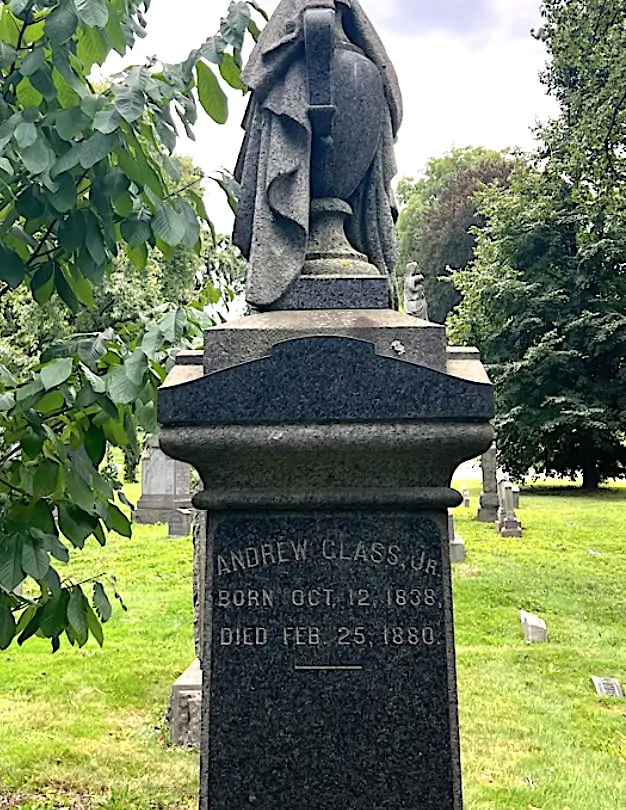
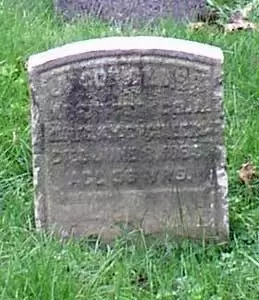
GLASS, JACOB (1841-1899). Private, 15th New York Engineers. A New York City native, he enlisted there on August 20, 1862, and mustered into Company E the next day. As per his muster roll, he was a cooper (barrel maker) by trade who was 5′ 7″ tall with brown hair and eyes and a florid complexion. He transferred to Company A on June 18, 1863, and mustered out at Washington, D.C., on July 2, 1865.
Glass is listed in the 1877 Brooklyn Directory and on the 1880 census as a baker. In 1890, his application for an invalid pension was approved, certificate 684,054. His Civil War service is confirmed by the 1890 Veterans Schedule. The 1892 New York State census indicates that he was employed as a baker. In 1898, he was admitted to the Home for Disabled Soldiers in Hampton Roads, Virginia. At the time of his admission, his occupation was reported as laborer. He and his father, Andrew Glass (see), were at the Home for Disabled Soldiers at Hampton Roads, Virginia, at the same time. He last lived at 343 Smith Street in Brooklyn. Shortly after his death from asthma, Mary Glass applied for and received a widow’s pension, certificate 483,101. Section 63, lot 23097.
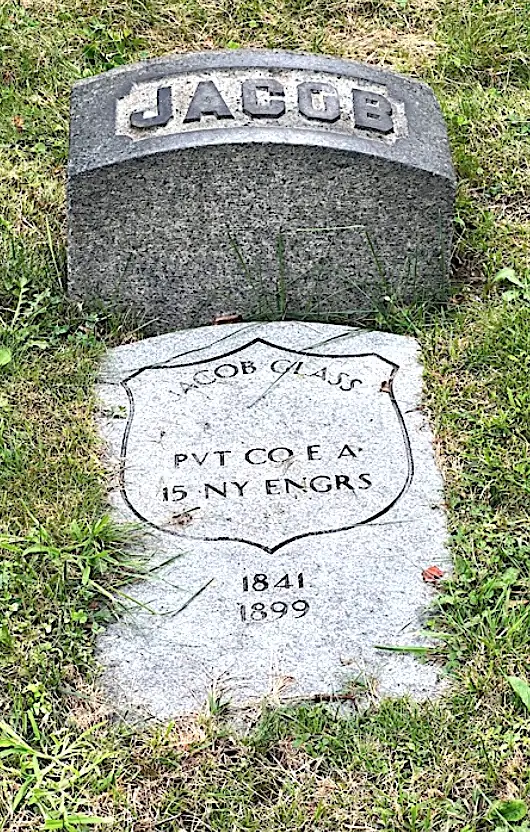
GLASS, JOHN J. (1830-1862). First lieutenant, 73rd New York Infantry, Company B. A native of New York, he enlisted at New York City as a first lieutenant on May 3, 1861, was commissioned into the 73rd on August 20, and was killed in battle at Williamsburg, Virginia, on May 5, 1862. He was interred at Green-Wood on May 25, 1862. Section 115, lot 8999, grave 1042.
GLASS, ROBERT (1843-1874). Private, 1st New York Infantry, Company C; 15th New York Heavy Artillery. Born in Ireland, he enlisted on April 22, 1861, at New York City, and mustered into the 1st New York the next day. According to his muster roll, he was a laborer who was 5′ 6″ tall with blue eyes, brown hair and a light complexion. He mustered out on May 25, 1863, at New York City. He re-enlisted as a private at New York City on June 1, 1863, and mustered into the 15th New York Heavy Artillery on June 9 without being assigned to a company. The 1870 census indicates that he was employed as an expressman. His obituary in the New York Herald read, “Robert Glass, after a long and painful illness , which he bore with Christian fortitude….” The death was caused by phthisis. His last residence was 734 First Avenue in Manhattan. Section 72, lot 5073.
GLASSEY, WILLIAM (1834-1870). Artificer, 15th New York Engineers, Company D. Originally from Ireland, Glassey enlisted on September 21, 1863, at New York City, as a private. On October 3, he mustered into the 15th Engineers, was promoted to artificer on November 15 of that year, and mustered out on July 2, 1865, at Washington, D.C. He last lived at 302 West 42nd Street in Manhattan. He succumbed to tuberculosis. Section 59, lot 15563, grave 74.
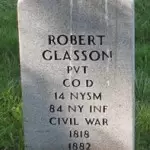
GLASSON, ROBERT (1818-1882). Private, 84th New York (14th Brooklyn) Infantry, Company D. Of English origin, Glasson arrived in the United States in 1855 at which time an ad in the New York Sun indicated that he was seeking employment as a dyer in a New England factory. During the Civil War, he enlisted at Brooklyn on August 27, 1862, and mustered into the 14th Brooklyn the next day. As per his muster roll, he was a dyer by trade who was 5′ 8½” tall with blue eyes, black hair and a dark complexion. He was discharged for disability on November 25 at New York City.
The censuses of 1875 and 1880 report that he was employed as a dyer. As per his obituary in the Brooklyn Daily Eagle, he was a member of the 14th Regiment’s War Veterans Association. In 1888, Susanna Glasson, who is interred with him, applied for and received a widow’s pension, certificate 275,566. Section 2, lot 5499.
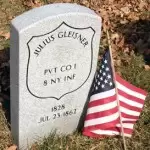
GLEISNER (or GLEISSNER), JULIUS (1828-1862). Private, 8th New York Infantry, Company I. A native of Germany, he enlisted and mustered into the 8th New York on November 1, 1861, at New York City. On July 7, 1862, he was discharged for disability at Philadelphia, Pennsylvania, and died of ulceration of the larynx on July 23. His last residence was on Atlantic Avenue in Brooklyn. Section 115, lot 13536 (Soldiers’ Lot), grave 35.
GLIMM, JOHN (1840-1918). Private, 5th New York Infantry, Company F. Glimm, a native of New York City and a resident of 159 West Street there, was 5′ 10½” with blue eyes and brown hair. A clerk at the start of the Civil War, he enlisted on July 13, 1861, and mustered in three days later. After being hospitalized in Philadelphia, Pennsylvania, on August 30, 1862, he was discharged for disability due to a pre-existing heart condition on February 6, 1863, at Convalescent Camp, Virginia. He joined the 5th New York Veterans Association after the hostilities.
In 1884, his application for an invalid pension was approved, certificate 493,088. The 1884 New York City Directory states that he was employed in provisions; the 1900 census reports that he was a shipping clerk and the 1910 census indicates that he was a provisions salesman. His last residence was 5 Bank Street in Manhattan. His death was attributed to nephritis. Shortly after his death in 1918, Mary Glimm, who is interred with him, applied for and received a widow’s pension, certificate 852,544. Section 67, lot 1930.
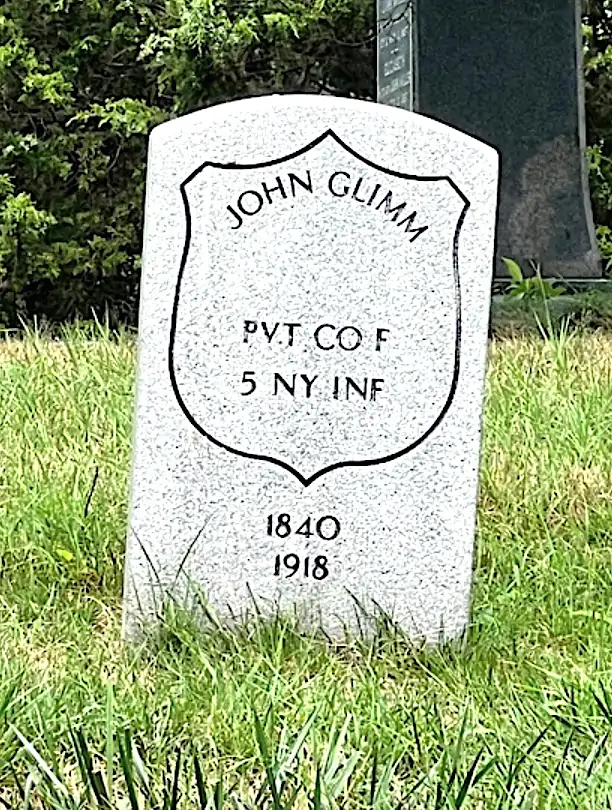
GLOUCESTER, ELIZABETH AMELIA (1817-1883). Abolitionist, philanthropist and businesswoman. Born to freed blacks in Richmond, Virginia, in an age of slavery, Elizabeth Parkhill moved to Philadelphia, Pennsylvania, when she was six, and lived with a Quaker family; her mother had died when she was young. Her obituary in The New York Times, published on September 23, 2019, as part of its series, “Overlooked,” notes that her mother may have served as a cook and that little is known about her father. However, that obituary indicates that census data listed her as a “mulatto,” hinting that she had some white ancestry. The Brooklyn Daily Eagle reports that she then lived with the family of John Gloucester, the founder of the first Black Presbyterian Church in the United States.
In 1836, she married James Gloucester, John’s youngest son and also a Presbyterian minister. The couple moved to Brooklyn in the late 1840s where James Gloucester became the founding pastor of the Siloam Presbyterian Church. Elizabeth sold second-hand clothing, then ran a furniture store on West Broadway; the couple eventually had eight children, two of whom died before reaching adulthood. The church had an Underground Railroad fund and hosted speakers, both black and white, who supported efforts to end slavery. The abolitionists Frederick Douglass and John Brown, were among the speakers who became friends with the Gloucesters; John Brown was invited to stay with them whenever he was in town. Elizabeth was active in fund-raising for her husband’s church and for the Colored Orphan Asylum in New York. In 1858, when John Brown came to New York to raise money for ammunition to end slavery, the Gloucester’s gave Brown $25 with a note telling him to “do battle with that ugly foe, slavery.” In a letter to Brown dated August 18, 1859, Gloucester enclosed $10 and wrote:
Esteemed Friend,
I gladly avail myself of the opportunity offered by our friend Mr. F. Douglass, who has just called upon us previous to his visit to you, to enclose to you for the good cause in which you are such a zealous laborer, a small amount which please accept with my most ardent wishes for its and your benefit. The visit of our mutual Friend Douglass has somewhat revived my rather drooping spirits in the cause, but seeing such ambition & enterprise in him I am again encouraged with best wishes for your welfare and prosperity & the good of your cause. I subscribe myself your sincere friend.
Mrs. E. A. Gloucester
Please write to me and with best respects to your Son.
In her obituary in the Brooklyn Daily Eagle, her husband related the ties between John Brown and Elizabeth. He remembered that Brown once said to her, “I wish you were a man for I’d like to have you invade the South with my little band.” Mr. Gloucester also recalled the last conversation between Elizabeth Gloucester and John Brown before he left for Harpers Ferry, Virginia:
Brown said, “‘Goodbye, Sister Gloucester. I’ve only sixteen men, but I’m to conquer.’ Mrs. Gloucester said to him, ‘Perhaps you will lose your life.’ ‘Well, my life,’ he replied, ‘is not worth much. I’m an old man. In Kansas, the balls flew around my head as thick as hail. I’ll never be killed by a ball. If I fall, I’ll open a ball in this country that will never stop until every slave is free.’”
As per The New York Times, Gloucester’s letter to John Brown was among those found in his carpetbag after his failed raid; those named in the letters feared prosecution or worse but no harm came to the Gloucesters. During the Civil War and Reconstruction, she led fund-raising efforts for educating freedmen and for Union soldiers through her involvement with the Ladies National Union Fair and the American Freedman’s Friend Society. Sadly, the Colored Children’s Orphan Asylum, for which she had raised funds through an elaborate fair in 1860, was set on fire during the New York City Draft Riots in July 1863; the children escaped without injury during the fire.
In addition to her abolitionist activities, she was a businesswoman who owned rental properties in Brooklyn and invested in real estate in Brooklyn and Manhattan. Her most valuable property was the former Hamilton Club on the corner of Remsen and Clinton Streets. She turned that property into the family’s home and the upscale boarding establishment called Remsen House which hosted meetings of community groups. The Remsen House was also the scene of a love triangle in 1883 among wealthy boarders there; Gloucester, who was then sick with congested lungs, was caught in the middle when asked to divulge what she knew about the romance. (Eventually, the Hamilton Club bought back the property and kept it until the 1940s when it was demolished and replaced with an apartment house.)
Three of her daughters graduated from Oberlin College in Ohio. As per her obituary in the Brooklyn Daily Eagle, “A Thrifty Colored Woman,” she was the wealthiest black woman in the United States and acquired all of her wealth on her own. She was reported to have been worth anywhere from $200,000 to $500,000. (The New York Times noted that she left about $300,000, the equivalent of about $7 million in 2019.) The obituaries considered it remarkable that she achieved so much for a woman, let alone a woman of color.
The Brooklyn Daily Eagle reported on her funeral on August 11, 1883. That article described her flower-filled elegant residence with a silver mounted casket holding the remains of Mrs. Gloucester. Well-dressed and prominent white and men and women were in attendance. In his eulogy, Reverend R. N. Freeman, pastor of the Siloam Presbyterian Church, noted that Mrs. Gloucester worked to better the lives of her people in both the North and South, instilled moral values in her large family, and grasped the “larger workings of world affairs.” The Brooklyn Daily Eagle noted, “She came to be known to every one in Brooklyn, New York, the State, and in fact throughout a great part of the country.” She left the Colored Orphan Asylum of New York a bequest of $1,100. The article also noted that she was a frequent attendee of the Plymouth Church led by the Reverend Henry Ward Beecher (see).
After her death, her husband became a physician and moved to Long Island. The New York Times noted that Elizabeth Gloucester’s name came up three years after her death when the Park Theater in Brooklyn was criticized for having a “color line.” The Times cited an article in the Brooklyn Daily Eagle in which Colonel William E. Sinn, the theater’s owner, recalled confronting Gloucester when she arrived at the theater with two orchestra tickets, letting her know that “many of my patrons objected to sitting in that part of the house with colored people.” Although Gloucester was at first indignant, she agreed to a refund of her money when she agreed that she would not have a black couple “sit at the table with her white boarders.” Sinn attributed the settlement to a “matter of business.” Section 31, lot 9817.
GOCK, JOHN F. (1839-1917). Color corporal, 22nd Regiment, New York State National Guard, Company E. Gock, who was born in New York City, worked as a clerk in his father’s grocery store as per the census of 1860. He was listed as a grocer on the 1863 Draft Registration. During the Civil War, he served in the 22nd as a color corporal for 30 days in 1863. The 1905 census reports that was working as a janitor. He last resided at 656 Macdonough Street in Brooklyn. He died of pneumonia. Section 180, lot 13340.
GODDARD, JOSEPH WARREN (1829-1890). Dry goods merchant. He was born in New York City and went into business there. In 1848 he founded J.W. Goddard & Sons, which became one of the largest dry goods houses in the country, specializing in linings, silks, and mohairs. He was vice president of the Greenwich Savings Bank, a trustee of the Woman’s Hospital, and was on the executive committee of the Union League Club. When during the Civil War rumors spread that the first Black regiment from New York City would be attacked on New York’s streets as they marched off to serve, he was one of the forty members of the Union League Club who marched down Broadway with those troops. Section 79, lot 4320.
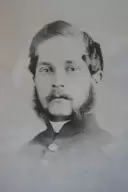
GODINE, FRANK (1838-1903). Captain, 32nd New York Infantry, Companies H, E, and B. A native New Yorker, who previously served in the 71st New York National Guard, he enlisted as a second lieutenant on August 9, 1861, at New York City, where he was commissioned into Company H of the 32nd New York. On May 7, 1862, he was transferred to Company E, and promoted to first lieutenant. He rose to captain on November 7, 1862, and the next month, on December 6, was transferred to Company B. As per his obituary in the Brooklyn Standard Union, which confirms his Civil War service, he was present at many battles including Antietam, Maryland, and Fredericksburg, Virginia. Godine mustered out at New York City on June 9, 1863.
The 1870 census and the 1878 New York City Directory note that Godine was a merchant. At the time of his passport application in 1879, he was 5′ 10½” tall with dark grey eyes, a straight nose, small mouth, dark brown hair, high forehead, light complexion and long face. Subsequently, he was in the shipping business as a member of the firm of Dorale & Company in Manhattan. He applied for an invalid pension in 1902, and received it under certificate 1,047,070. Godine’s obituary reports that he was a member of the Brooklyn Young Republican Club and the Grand Army of the Potomac. An article in the Amsterdam Evening Recorder on September 1, 1903, indicates that Godine, the commandant of the 32nd veterans, donated books that contained the muster rolls and records of the regiment during the Civil War to the public library. His father-in-law was General Jesse E. Smith (see). He last lived at 424 Halsey Street in Brooklyn. His death was attributed to apoplexy. Section 76, lot 1079.
GOELLER, AUGUSTUS C. (1845-1916). Private, 20th Michigan Infantry, Company I. Originally from St. Goarshausen on the Rhine, Germany, Goeller’s family immigrated to New York when he was a young boy. Orphaned at age 14, he moved to Michigan. He was seventeen and a resident of Marengo, Michigan, when he enlisted as a private on August 1, 1862, at Marshall, Michigan. Goeller mustered into the 20th Michigan on August 19. On June 2, 1864, he was wounded at the Battle of Cold Harbor, Virginia. A month later, on July 4, he was wounded in action at the Battle of Petersburg, Virginia. He was wounded a third time on December 27, 1864, place unknown. As per his obituary in the Brooklyn Daily Eagle, which confirms his Civil War service, he was wounded at the Battles of the Wilderness and Chancellorsville in Virginia. He mustered out on May 30, 1865, at Delaney House, Washington, D.C.
Goeller settled in New York City after the War and worked for the men’s clothier, Rogers Peet & Co., the first haberdasher that affixed price tags to garments, for more than thirty-five years. In 1889, Goeller applied for and received an invalid pension, certificate 444,949. The Veterans Census of 1890 indicates that he sustained a bullet wound to the left shoulder during the Civil War. According to the censuses of 1900 and 1910, he was a clothing cutter. A Freemason, he was also a member of the Ulysses S. Grant Post #327 of the G.A.R. His obituary notes that he was a Brooklyn resident for forty years, last residing at 365 76th Street. He succumbed to influenza. Most likely, Thomas Goeller (see) was his brother. In 1916, his widow, Lydia Goeller, who is interred with him, received a pension, certificate 817,874. Section 2, lot 5499, grave 1674.
GOELLER (or GELLER, GALER), THOMAS (1834-1907). Sergeant, 45th New York Infantry, Company A. Originally from Baden, Germany, Goeller immigrated to the United States in 1850 and became a naturalized citizen on September 17, 1860; at that time, he lived at 103 3rd Street in New York City. The 1860 census, which listed him as Thomas Geller, reports that he was married, worked as a painter and had a personal estate valued at $200. He enlisted as a private at New York City on September 19, 1861, and mustered into the 45th New York that same day with a simultaneous promotion to corporal. Goeller became a sergeant on July 1, 1862, and deserted at New York City while home on furlough on February 24, 1863.
As per the 1865 New York State census, Goeller was living in Brooklyn with his wife and two young children and working as a painter. At the time of the 1870 census, which listed him as Thomas Galer, he lived in Brooklyn with his wife and children and still worked as a house painter; the Goellers ultimately had 10 children, born between 1860 and 1878. The 1880 census reports that he lived at 355 18th Street with his wife, Katharina (née Schneider), and children and worked as a policeman. An article in the Brooklyn Daily Eagle on January 24, 1883, noted that Goeller, a policeman of the Tenth Precinct, was fined ten days’ pay and an additional day’s pay after being found by the drill captain in a gateman’s house on Atlantic Avenue and Cumberland Street after coming out of the hallway of a liquor store. That article concluded, “Goeller has had his last chance.”
Goeller was a widower at the time of the 1900 census, lived at 344 19th Street in Brooklyn with his son’s family and worked as a house painter. The 1905 New York State census reports that he lived with his son’s family in Brooklyn. He was likely the brother of Augustus Goeller (see). He last lived with his son at 377 13th Street in Brooklyn; his death was attributed to gas. Section 2, lot 5499, grave 1650.
GOERCK, CORNELIUS R. (1836-1868). Quartermaster sergeant, 6th New York Infantry, Company C. A native New Yorker, Goerck enlisted as a corporal in 1861 (date unknown) and mustered into Company C of the 6th New York. He was discharged on June 26, 1863, with the rank of quartermaster sergeant. He last lived at 64 East 53rd Street in Manhattan. Goerck died from consumption. His remains were moved to their present location on September 24, 1872. In 1925, his wife applied for and received a widow’s pension, certificate 962,121. Lot 20607.
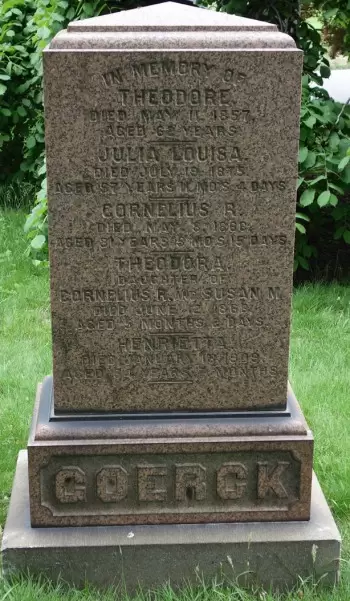
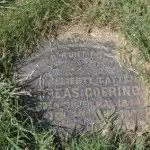
GOERING (or GOHRING), ANDREAS (1844-1882). Private, 15th New York Heavy Artillery, Company I. Originally from Germany, Goering enlisted and mustered into the 15th Heavy Artillery at New York City on August 10, 1863. As per his muster roll, he was an upholsterer by trade who was 5′ 3″ tall with brown eyes, black hair and a dark complexion. He mustered out at Washington, D.C., on August 22, 1865. According to an inscription on his gravestone, he was a member of the Grand Army of the Republic. His last residence was 109 Essex Street in Manhattan. He died of phthisis. Eliza (or Elizabeth) Goering applied for and was granted a widow’s pension, certificate 265,209. Section 2, lot 5499, grave 1582.
GOETZ, JOHN (1829-1908). Private, 132nd New York Infantry, Company A. A native of Germany, Goetz enlisted at Brooklyn on August 20, 1862, and mustered into the 132nd New York on October 4. As per his muster roll, he was a mason by trade who was 5′ 4″ tall with blue eyes, brown hair and a dark complexion. He mustered out on June 5, 1865, at Trenton, New Jersey.
His obituary in the Brooklyn Daily Eagle reports that he was a Freemason and member of the Independent Order of Odd Fellows. The censuses of 1880, 1900, and the 1906 Brooklyn Directory state that he was in the hay and feed business. He last lived at 181 Dean Street in Brooklyn. Nephritis was the cause of his death. Section 131, lot 32712, grave 3.
GOLDE (or GOLDER), GUSTAV (or GUSTAVE) (1842-1883). Private, 95th New York Infantry, Companies E and D. Of German origin, Golde enlisted as a private at Tarrytown, New York, on September 19, 1864, and mustered into Company E of the 95th New York the same day. A substitute who was borne on the rolls as Golder, he was a goldsmith by trade who was 5′ 4½” tall with hazel eyes, brown hair and a dark complexion. On March 1, 1865, he was transferred intra-regimentally to Company D and mustered out on May 31 of that same year at Washington, D.C.
The 1870 census, which also lists his name as Golder, indicates that was employed as a jeweler. The 1880 census reports that he was a saloon-keeper; the 1881 Brooklyn Directory states that he was in the liquor business. As per his obituary in the Brooklyn Daily Eagle, he belonged to Devin Post #148 of the G.A.R.; comrades were invited to attend his funeral. He last resided at 523 Atlantic Avenue, Brooklyn, where he had a liquor business. He died of apoplexy. Louise Kelling, who is interred with him, applied for a widow’s pension in 1890, application 454,690, but there is no certificate number. His remains were moved to the current location on March 21, 1893. Section 196, lot 28295, grave 2.
GOLDEN, CYRUS W. (1844-1882). Private, 65th New York Infantry, Companies B and A. Originally from South Hadley, Massachusetts, he enlisted as a private at New York City on August 3, 1861, and mustered immediately into the 65th New York. He transferred intra-regimentally to Company A on September 1 of that year and mustered out on September 12, 1864, at New York City.
The census of 1870 indicates that he was living in Greenburgh, New York, and was working as a gardener. He advertised for a position as a gardener and “useful man” in the New York Daily Tribune on May 27, 1875; he was listed as a gardener in the 1876 New York City Directory. By 1878, Golden was an expressman as per the New York City Directory. The census of 1880 reports that he was living in New Haven, Connecticut, and working as a laborer.
On August 4, 1881, an article in the Brooklyn Union-Argus reported that Golden’s sons, Wilson and William, were arrested for stealing clothing from S. Mansfield at 375 Fifth Avenue and a twenty-foot row boat from West 58th Street in Manhattan. When the boys were apprehended near the Gowanus Canal, they were painting the row boat a different color. Sadly, the New York Herald reported on November 22, 1881, that 15-year-old Wilson Golden was killed instantly when he attempted to jump on a freight train of the Hudson River Railroad at 51st Street in Manhattan. He was crushed to death by the wheels of the railroad car.
The 1882 Brooklyn Directory lists Golden as a painter living at 588 Sixth Avenue in Brooklyn. Golden died of nephritis at Bellevue Hospital in Manhattan. In 1893, Elizabeth Cantwell, his widow who had remarried, applied as a guardian for a minor’s pension, certificate 392,069. Ms. Cantwell applied for a widow’s pension in 1903, after her second husband died, application 793,673, but she did not receive one. Section 2, lot 5499, grave 877.
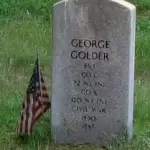
GOLDER, GEORGE W. (1830-1867). Private, 72nd New York Infantry, Company C; 120th New York Infantry, Company K. Golder enlisted at New York City on August 4, 1862, and mustered into the 72nd on August 21. He transferred into the 120th New York on July 23, 1864, and was discharged on April 28, 1865. That unit consolidated into the 145th Company, 2nd Battalion, Veteran Reserve Corps. He last lived at 277 3rd Street in Brooklyn. As per his obituary in the New York Herald, he died from heart disease. In March 1868, Lucy Golder applied for and received a widow’s pension, certificate 143,593. A minor child received a pension in 1871, certificate 155,023. Section 11, lot 8795.
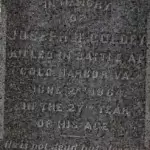
GOLDEY (or GOLDY), JOSEPH H. (1837-1864). Private, 84th New York (14th Brooklyn) Infantry, Company A; 5th New York Veteran Infantry, Company A. Goldey is not buried at Green-Wood; the cenotaph in his family’s lot honors his memory. The New York State census of 1855 notes that he worked as a gas fitter. After enlisting as a private at Brooklyn on April 18, 1861, he mustered into the 14th Brooklyn on May 23. Goldey transferred into the 5th Veterans on June 2, 1864, the same day that he was killed at the Battle of Cold Harbor, Virginia. His death at Cold Harbor “while in the discharge of his duty” was reported in the Brooklyn Daily Eagle. His memorial at Green-Wood is inscribed, “In Memory of Joseph H. Goldey, Killed in Battle at Cold Harbor, Va., June 2nd 1864 in the 27th year of his age. He is not dead but sleeping.” Section 183, lot 20011.
GOLDING, GILBERT G. (1842-1903). Second class fireman, United States Navy. A Brooklyn native, Golding enlisted in the United States Navy at Hampton Roads, Virginia, on December 16, 1861, for three years. At the time of his enlistment, he was employed as a gauger, was 5′ 10″ tall with blue eyes, light hair, light complexion and had no distinguishing marks or scars. He served on the USS Brandywine and the USS Henry Brinker as a coal-heaver and second class fireman. On February 3, 1865, he was discharged at Hampton Roads.
According to the census of 1880, he was a gauger in the Custom House. The 1890 Veterans Schedule confirms his service in the Navy. He received a pension from the Navy, certificate 26,082. As per his obituary in the Brooklyn Daily Eagle, he was a government gauger for forty years. A member of the Coeur de Lion Encampment of the Knights of St. John and Malta, his obituary noted that he died after an operation performed at his home. His last residence was 636A Monroe Street in Brooklyn. Rosa Golding applied for and was awarded a widow’s pension under certificate 16,291. Section 174, lot 18382, grave 1.
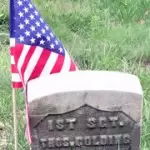
GOLDING, THOMAS (1837-1905). First lieutenant, 131st New York Infantry, Company I. Although his soldier record indicates that he was a native New Yorker, his obituary in the Brooklyn Citizen reports that he was born in County Westmeath, Ireland, and came to New York as a young man. During the Civil War, he enlisted at New York City as a private on August 31, 1862, and mustered into the 131st New York on September 6. He rose through the ranks, promoted to corporal on September 10, 1862, sergeant on December 20, 1862, first sergeant on February 16, 1864, and to second lieutenant on February 2, 1865. As per his obituary, Golding served in the months-long Gulf Campaign and while stationed at Fort Hudson, he only slept under cover for ten nights. The obituary notes that he mustered out with the rank of first lieutenant.He mustered out on July 26, 1865, at Savannah, Georgia.
In civilian life, he was a plumber. In 1884, he applied for and was granted an invalid pension, certificate 338,974. Among the many organizations to which he belonged were the William D. Kennedy Post #42 of the G.A.R., the Continental Guards, St. Ann’s Protestant Episcopal Church and the Home Circle of the church. He was survived by two sons and two daughters. His last address was 376 Sackett Street in Brooklyn. Section 115, lot 11193, grave 286.
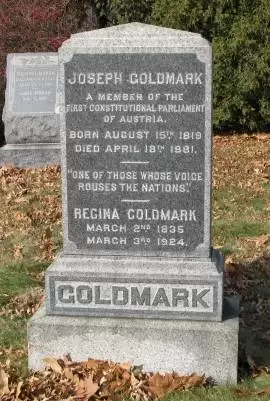
GOLDMARK, JOSEPH (1819-1881). Arms manufacturer. Born in Warsaw, Poland, his mother died when he was two, and his father left for Hungary to earn a living, leaving Joseph to be raised by his grandparents. He studied medicine, then practiced in Vienna, Austria. Soon his interests turned to chemistry, which he taught at the Vienna Polytechnic Institute. He demonstrated in 1847 that yellow phosphorus, a deadly poison then widely used in making safety matches, but which was causing many deaths, could be transformed into harmless yellow phosphorus by exposure to light. In 1848, when revolution swept Austria, Goldmark captained the Academic Legion, a group formed at the University to seek the establishment of a constitutional monarchy. He was a member of the first constitutional assembly in Austria, and was on its Constitution Committee.
However, the revolution soon collapsed, and Goldmark fled Austria for New York City with other intellectuals such as Louis Kossuth. (Six years later he was tried in absentia for murder, convicted, and sentenced to death. It was not until his return to Austria in 1868, and his subsequent trial and acquittal, that he was exonerated.) He quickly established himself in Brooklyn as a doctor, specializing in skin diseases. By 1853 he had gone into the percussion cap business, and it was there that he earned his fortune. In 1859, he set up his factory in South Brooklyn, just east of the Gowanus Canal fronting on First and Carroll Streets. His business grew dramatically during the Civil War, and it was probably the largest private maker of percussion caps for Union troops. In 1864, he built a factory in Greenville, New Jersey, which allowed him to become a major manufacturer of cartridges. By this time he was a wealthy man, with extensive real estate holdings in Brooklyn, and was also president of a gold mine in Nova Scotia, Canada.
After the Civil War, Goldmark continued in these same businesses, and used his skill as a chemist to obtain several patents for improved products. At the Centennial Exposition of 1876 in Philadelphia his businesses had two exhibits: one of cartridges, blasting detonators, and “burglar alarm exploders,” the other of safety elevators. Goldmark was a leader of the Jewish intellectual community in New York, a founder of the King’s County Republican Club, a charter member of both the Chemical Society and the Society of German-American Physicians, and at the time of his death was one of the largest landholders in South Brooklyn. He was also the father-in-law of Supreme Court Justice Louis Brandeis. The inscription on his tombstone includes his membership in the Austria’s First Constitutional Parliament and this quote, “One of those whose voice rouses the nations.” A Jew, he may have been the first Jew buried at Green-Wood. He last lived at 112 2nd Place in Brooklyn. His death was caused by an abscess of the lungs. Section 184, lot 22576.
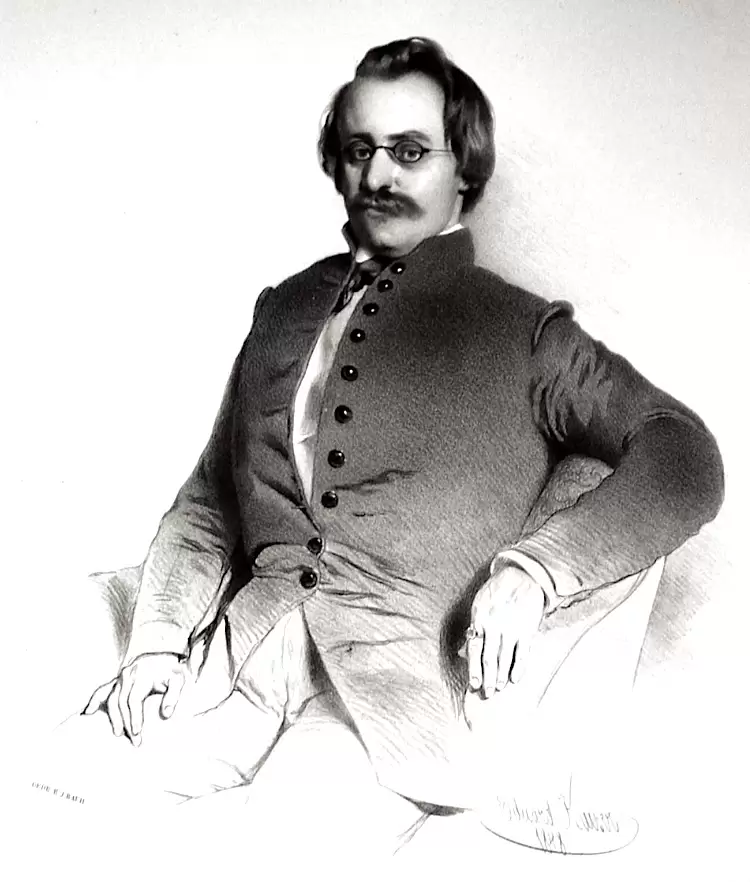
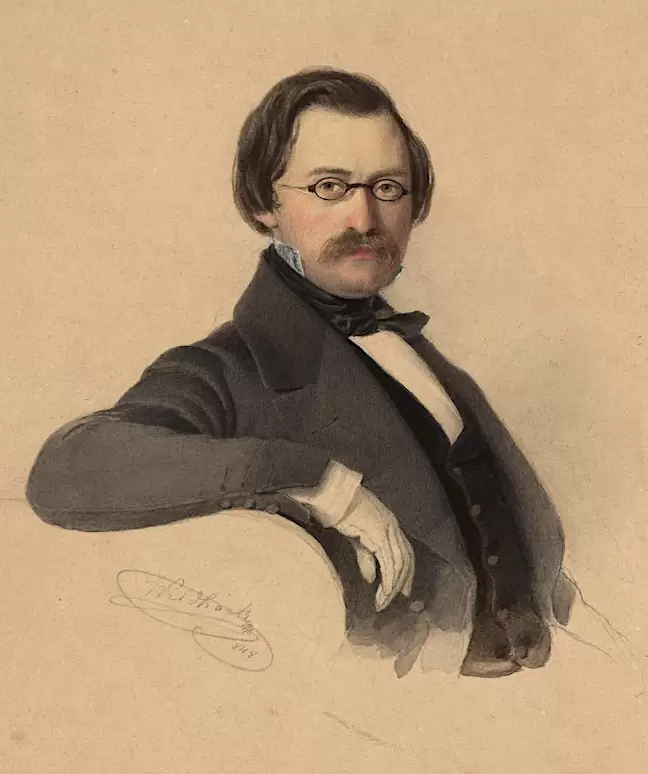
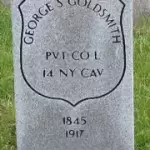
GOLDSMITH, GEORGE S. (1845-1917). Private, 14th New York Cavalry, Company L. A Long Island native, Goldsmith enlisted as a private and mustered into the 14th New York Cavalry on September 23, 1864. He served with his company until he mustered out on June 2, 1865, at New Orleans. His father-in-law, John M. Moffitt, who died in 1887, was the sculptor who created the relief sculptures on the main gates at Green-Wood Cemetery as well as the “Ages of Man” on the Fort Hamilton Parkway Visitors’ Lounge, and the Anderson, Durant, and Steinway mausolea at Green-Wood. As per the 1915 New York City Directory, he was an optometrist and secretary-treasurer at A. Becthold, Inc. His last residence was 324 West 22nd Street in Manhattan. He died of arteriosclerosis. Section 69, lot 19094.
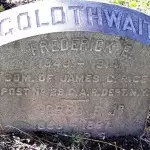
GOLDTHWAIT, FREDERICK (or FREDERIC) E. (1848-1914). Fifer, 8th United States Infantry, Company A. A native of New York, Goldthwait enlisted as a fifer on August 16, 1861, and joined Company A of the 8th U.S. Infantry. At only thirteen years of age, he listed his occupation as a laborer. He was 5′ 4½’ tall with brown eyes, brown hair and a fair complexion. He mustered out at General Hospital on August 16, 1864, at the expiration of his term.
The 1880 census and 1884 New York City Directory report that he was a clerk in a factory. In 1890, his application for an invalid pension was granted, certificate 572,767. The 1890 Veterans Schedule confirms his Civil War service. As per his obituary in The New York Times, he last worked as an assistant storekeeper on Blackwell’s Island. That obituary, which reports that he entered the Army at the age of ten as a drummer boy, notes that he was the commander of the James Rice Post #29 of the G.A.R. for ten years; comrades were invited to attend his funeral. He last lived at 317 West 19th Street in Manhattan. Shortly after his death from endocarditis in 1914, Josephine Goldthwait, who is interred with him, applied for and received a widow’s pension, certificate 792,475. Section 4, lot 21072, grave 26.
GOODLIFF (or GOODLIFFE), JOSEPH P. (1840-1884). Second lieutenant, 22nd Regiment, New York State National Guard, Company I. A Native New Yorker, Goodliff enlisted as a private at New York City on May 31, 1862, and mustered into the 22nd Regiment on that date. After being promoted to corporal on July 16, 1862, he mustered out on September 5, 1862, at New York City. When his regiment was reactivated the next year for 30 days, he received a promotion to first sergeant on June 18, 1863, and mustered into Company I that day. Six days later, he was promoted to second lieutenant and mustered out at New York City when his enlistment ended on July 24.
The 1870 census indicates that he was a silver-plater with a personal estate of $500. He is listed on the 1878 New York City Directory as a plater; the 1880 census reports that he was a gas collector. He last lived at 4 East 133rd Street in Manhattan. He died of phthisis. In 1890, Olive Goodliff, who is interred with him, applied for and received a widow’s pension, certificate 323,358. Section 61, lot 13805.
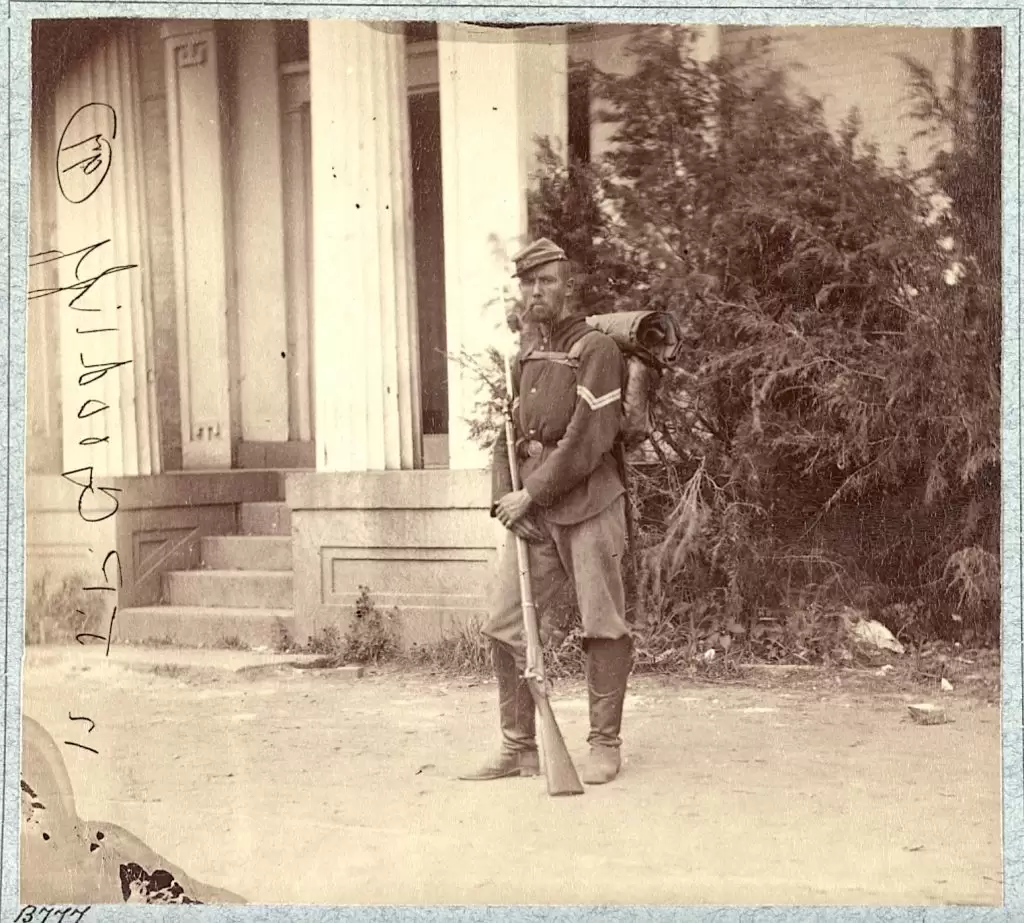
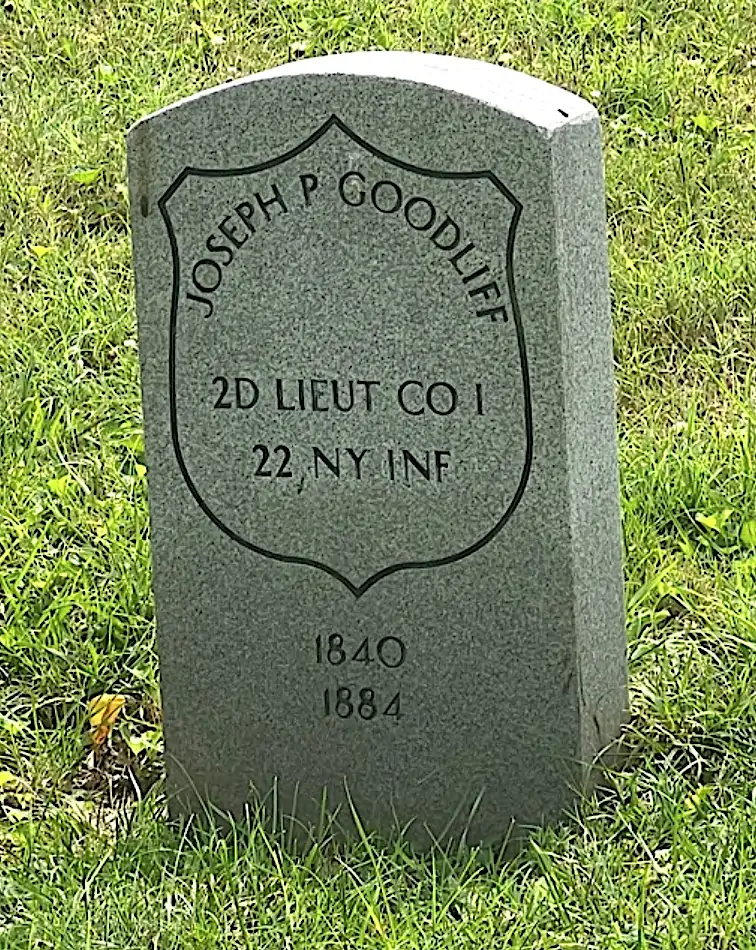
GOODMANSON, JOHN P. (1810-1864). Acting master, United States Navy. Born in Baltimore, Maryland, he was a ship master as per the census of 1850. During the Civil War, Goodmanson began serving in the United States Navy as an acting master on August 26, 1861. He was the acting master on the USS Release, a storeship that left Boston, Massachusetts, on December 23, 1861, bound for Port Royal, South Carolina. He was dismissed on January 20, 1863, for drunkenness. His application for a pension was approved, certificate 19,318. He died of “stricture” in Point Lookout, Virginia. Mary Goodmanson, who is interred with him, applied for and received a widow’s pension, certificate 881,244. Section 52, lot 5873.
GOODNOW, WILLIAM EDWARD (1839-1865). Sergeant, New York Marine Light Artillery, Company E. Originally from Massachusetts, he was living there in Worchester as per the 1860 census. At that time, his personal estate was valued at $300. During the Civil War, Goodnow enlisted as a sergeant at New York City on January 14, 1862, and mustered into his company the same day. He was discharged for disability on January 14, 1863, at New Berne, North Carolina. His last residence was 4 Sidney Place in Brooklyn. Section 180, lot 15898.
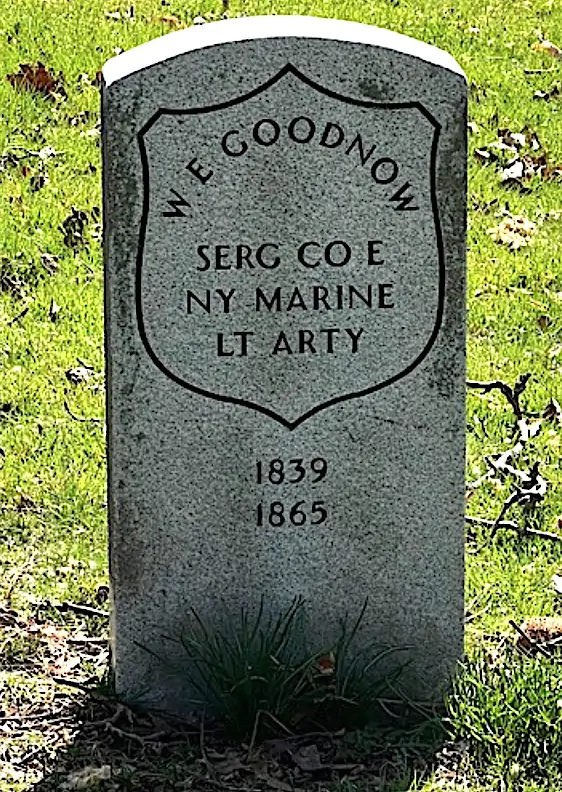
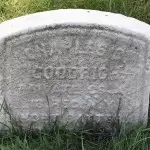
GOODRICH, CHARLES G. (or CHARLES THOMAS) (1848-1898). Private, 13th Independent Battery, Massachusetts Light Artillery. Born in New York, he was a teamster and resident of Boston, Massachusetts, when he enlisted as a private on January 10, 1863, the same date that he mustered into the 13th Massachusetts Light Artillery. At that time, he used the alias “Charles Thomas.” He mustered out at Boston on July 28, 1865. In 1890, his application for an invalid pension was approved, certificate 912,394.
As per his obituary in the Brooklyn Daily Eagle, he was a member of several lodges of the Independent Order of Odd Fellows including the Excelsior Encampment; the local lodge held a tribute to him after his death from cancer. His last residence was at 1180 5th Avenue, Brooklyn. Shortly after his death in 1898, Abby Goodrich, who is interred with him, applied for and received a widow’s pension under certificate 475,551. His government-issued gravestone inscription, circa 1900, is etched with an inscription stating that he served in the 13th New York Independent Battery, but that is an error; rather, he served in the 13th Independent Battery of the Massachusetts Light Artillery. Section 127, lot 3611, grave 240.
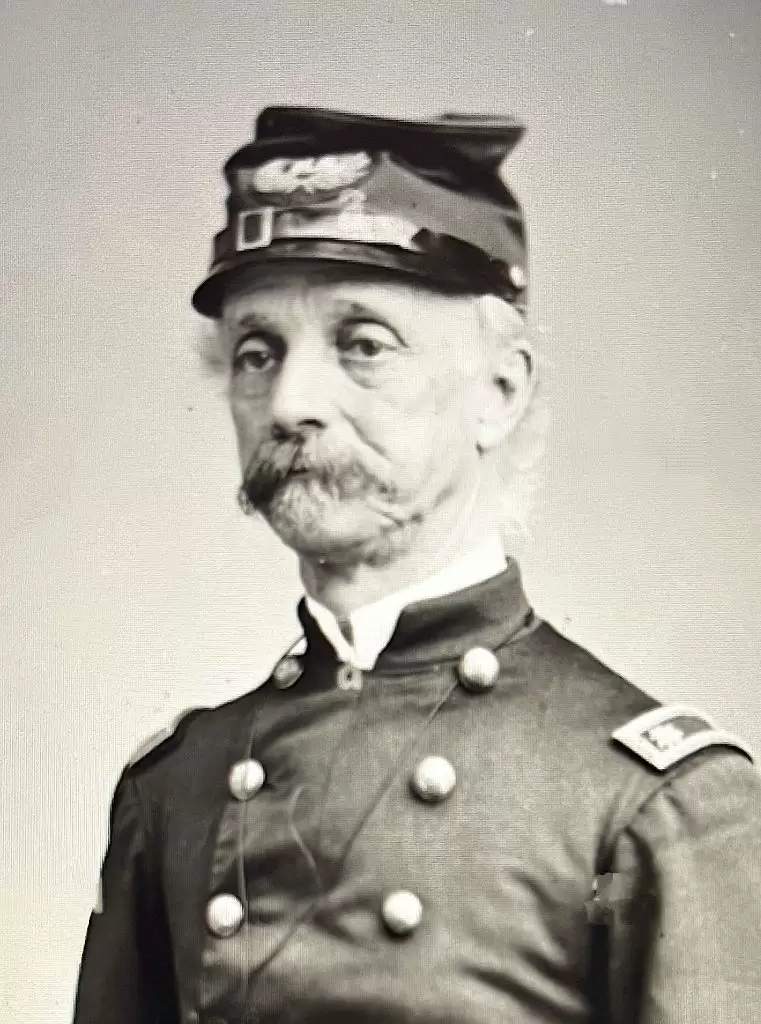
GOODRICH, CHARLES S. J. (1803-1883). Surgeon, 102nd New York Infantry. Goodrich was born in Pittsfield, Massachusetts, where his ancestors were the first white settlers. He was a graduate of Pittsfield Medical College, class of 1827. He settled in Troy, New York, where he was appointed Health Officer of that city in 1832, and served during the cholera epidemic there. Goodrich relocated to Brooklyn in 1845 where he had a distinguished record of public service. In 1848, he was appointed the first Health Officer of Brooklyn; and in 1852 was appointed United States Consul to Lyons, France, by President Millard Fillmore.
On December 12, 1861, he enlisted as a surgeon and was commissioned into the Field and Staff of the 102nd New York that day under the command of Colonel Wadsworth. Dr. Goodrich was discharged on May 1, 1862, and, according to his obituary in The New York Times, spent most of his time attending to his profession. He died of “old age” at the Homeopathic Hospital on Cumberland Street in Brooklyn. Section 34, lot 8596.
GOODRICH, ISAIAH W. (1844-1871). Acting ensign, United States Navy. Born in Maine, Goodrich entered the Navy as a mate on March 11, 1863, and resigned due to sickness on November 12 of that year. He returned to service as an acting ensign on December 1, 1864, and was honorably discharged on September 16, 1865. He last lived in Feltville, New Jersey, where he died of phthisis on January 11, 1871. His remains were moved to their present location on June 2 of that year. Section 187, lot 19977.
GOODRICH, WILLIAM BINGHAM (1821-1862). Colonel, 60th New York Infantry, Company A. A native of Wilna, New York, William Goodrich served as a private in the Mexican War, in Easton’s Battalion of the Missouri Infantry, then went to California during the Gold Rush where he lived for a year. A graduate of Wesleyan Seminary in Gouverneur, New York, he attended law school at Ballston Spa, New York. A part owner of the St. Lawrence Plaindealer newspaper in Canton, New York, he practiced law in Madrid, New York, in addition to being a journalist. He mustered in at Canton as a captain of Company A of the 60th New York Infantry, a regiment that he helped organize, on September 11, 1861. Promoted to lieutenant colonel on October 8, 1861, and then colonel on May 1, 1862, Goodrich commanded the 3rd Brigade of the 2nd Division of 12th Corps, Army of the Potomac, in September 1862. Killed in action, he was shot in the chest at the Battle of Antietam, Maryland, on September 17, 1862.
Eulogized after his body and the tattered American flag that he carried to battle were returned to Canton, it was remembered that he, “accepted the banner in behalf of his company, not because of the attractiveness of its beauty, but because it represented a principle and was emblematic of the sentiments he and his companions went forth to sustain. In leading his company forth to the fray he expected the eyes of this people would be upon them, and if they did not return—and they should not without honor—they left behind them the memory of their good intentions.” He was initially interred in Canton, then removed to Green-Wood and re-interred on May 7, 1901. A street in Canton is named in his memory. A large pink granite obelisk on his gravesite is engraved with the name of the regiment. Section 165, lot 30802.
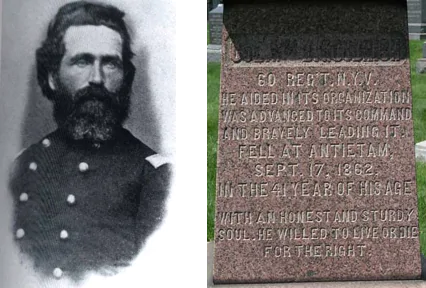
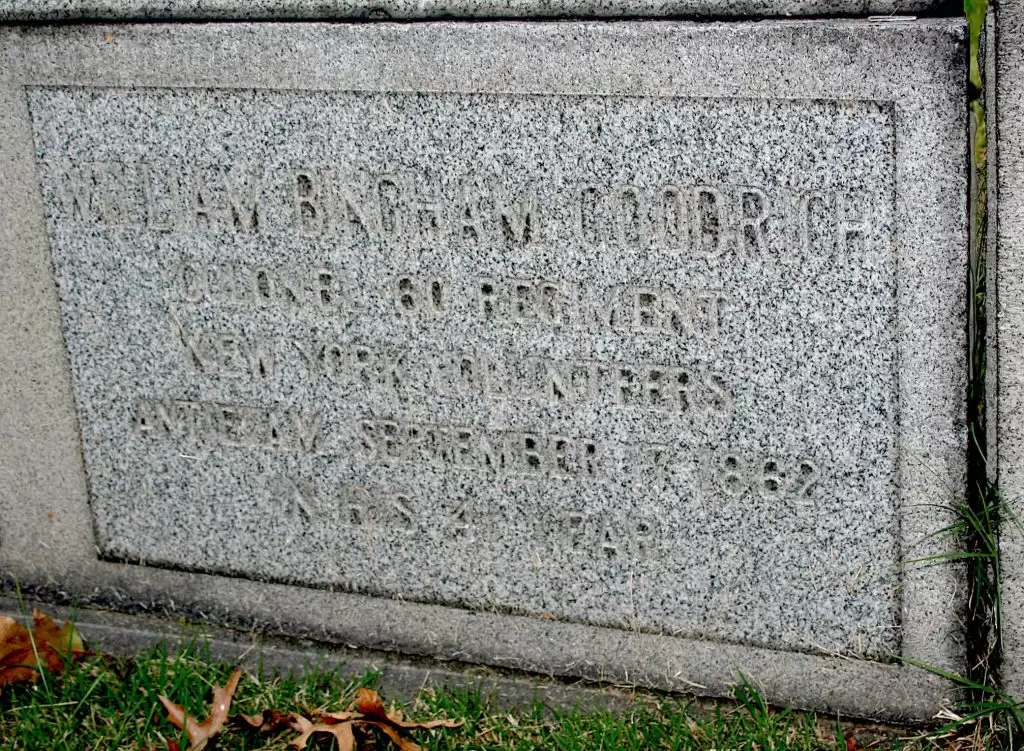
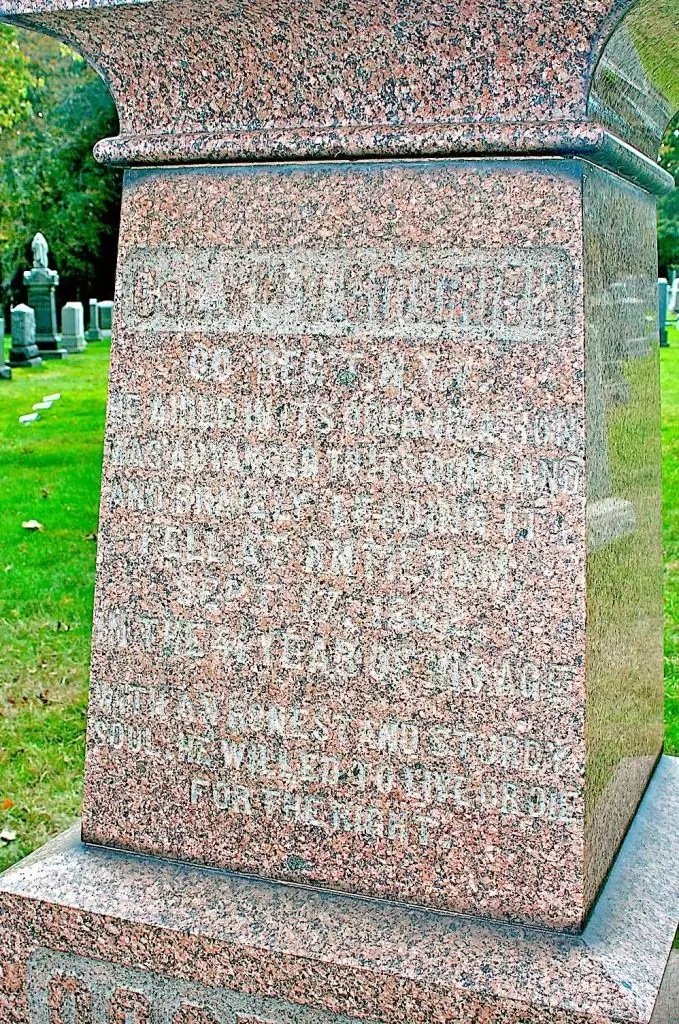
GOODRIDGE, LEONARD ORMOND (1829-1911). Captain, 51st New York Infantry, Company H; private, 7th Regiment, New York State Militia, Company I. Born in Moravia, New York, his obituary in the Brooklyn Daily Eagle reports that he was one of the “Argonauts” who went to California in the 1849 Gold Rush. He was listed as living in Oneida County, New York, and working as a laborer on the census of 1850. At the onset of the Civil War, he enlisted as a private at New York City on April 19, 1861, mustered into the 7th Regiment on April 26, and mustered out with the company on June 3 at New York City. On August 30, 1861, he re-enlisted as a second lieutenant and mustered into the 51st New York on October 29. He was promoted to first lieutenant on March 19, 1862. On July 1, 1862, he suffered a shell wound to the right leg, as per the 1890 Veterans Schedule. Goodridge was promoted to captain on November 17, 1862, and discharged on January 17, 1863. His obituary states that he was the staff quartermaster to General Ambrose Burnside and served under him during his North Carolina campaign, during which he was wounded at Roanoke, North Carolina.
Goodridge returned to Cayuga County after the War where he took up agriculture. In the 1881 Brooklyn Directory, he was listed as a merchant; in the 1884 New York City Directory, he was in the produce business. On April 20, 1888, he mustered into the G.A.R. He applied for and was granted an invalid pension in 1900, certificate 1,021,057. The census of 1900 reports that Goodridge was a retired merchant. On May 24, 1900, an article in the Brooklyn Standard Union, notes that the Goodridges, a wealthy couple, adopted a twenty-year old woman, Eva Jones, whose parents were dead. Ms. Jones had met the Goodridges in California and had been living with them in Brooklyn. His last residence was on Westminster Road in Brooklyn. Goodridge died of pneumonia. In 1911, his widow, Frances Goodridge, applied for and received a pension, certificate 737,510. Section 183, lot 22198.
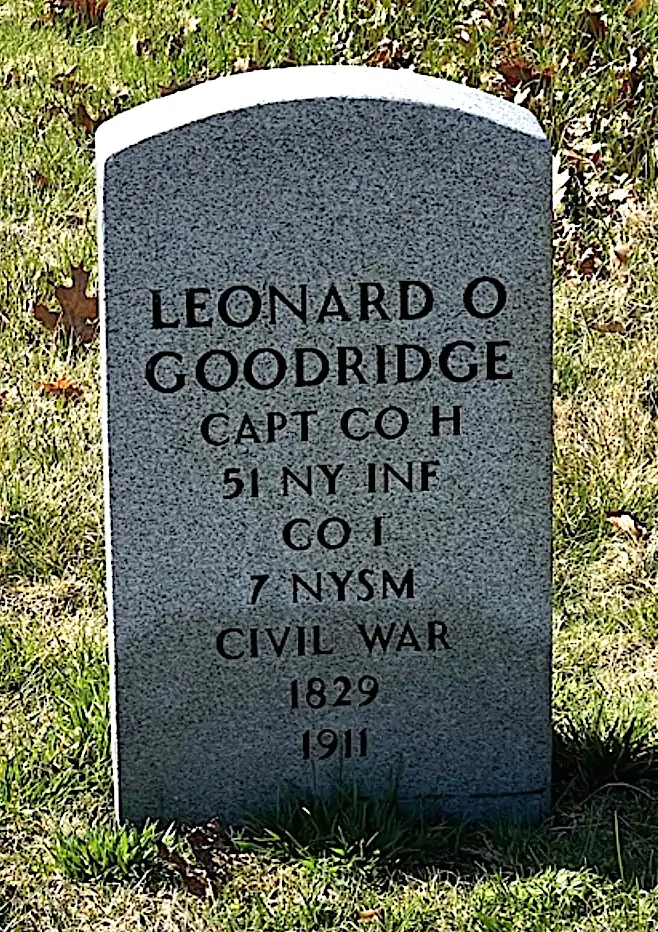
GOODWIN, EDWARD W. (1835-1910). Private, 133rd New York Infantry, Company I. A native of New York City, Goodwin enlisted at Brooklyn as a private on August 22, 1862, and mustered into the 133rd Infantry on September 24. A pocket book maker as per his muster roll, he was 5′ 4½” tall with brown eyes, brown hair and a dark complexion. He mustered out with his company on June 6, 1865, at Washington, D.C. His application for an invalid pension was granted in 1879, certificate 197,511. The censuses of 1870, 1880, 1900 and the Brooklyn Directories of 1877 and 1887 all state that he was a pocket book maker. He last resided at 344 Sixth Avenue in Brooklyn. Pneumonia was the cause of his death. Section 151, lot 17328, grave 1.
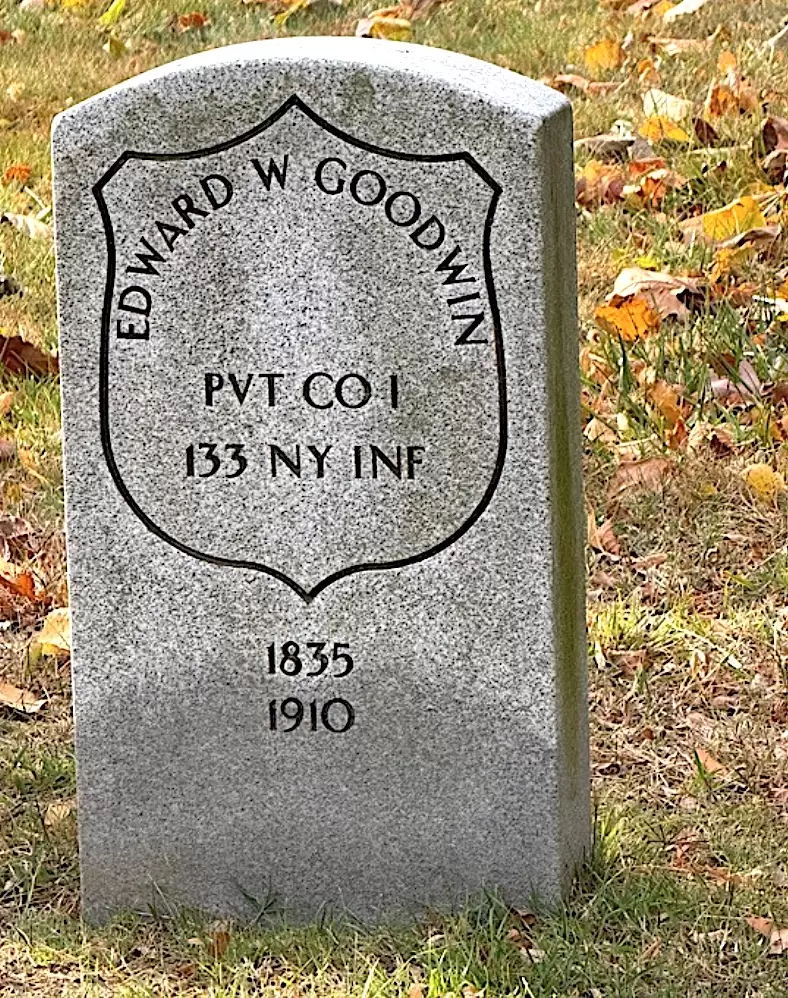
GOODWIN, ROBERT NICHOLS (1835-1892). Captain, 52nd Regiment, New York State National Guard, Company K; private, 13th New York State Militia, Company G. Born in Philadelphia, Pennsylvania, his grandfather, Robert Nichols, was a prominent merchant and president of Brooklyn Gas & Light from 1851-1853. Nichols was also known for his involvement in the New York State Militia, where he rose to brigadier general in 1827, and for his commitment to the advancement of such causes as public education and libraries, health care for the poor, temperance, and banking for laborers, etc. Nichols wrote a letter in 1853 recommending Goodwin for the United States Military Academy at West Point though it is not clear if Goodwin was accepted and he is not listed in Cullum’s Register as a graduate of the Academy. In that letter, he wrote that Robert “…is five feet nine & a half inches in height-free from any deformity, disease, or infirmity-of strict moral integrity-good mental abilities-and having the educational acquirements necessary for his examination-….” As per the New York State census of 1855, Robert Goodwin was living in Brooklyn and working as a clerk.
In 1861, Goodwin served in the 13th New York State Militia, Company G, for three months as a private. He re-enlisted as a captain at Brooklyn on June 19, 1863, was commissioned into the 52nd on that date, and mustered out after 30 days on July 25. As per the New York City Draft Registration of 1863, Goodwin was an iron merchant. According to an article in the Brooklyn Daily Union on September 14, 1863, it was difficult to meet the quota for recruits because many men made pleas for exemptions; Goodwin was drafted and held for duty on September 8 but there is no further record of his service.
The 1870 and 1880 censuses and the 1877 and 1891 Brooklyn Directories all indicate that he was an iron merchant. The Veterans Census of 1890 confirms his service in the Civil War. He last lived at 367 Cumberland Street in Brooklyn. Goodwin died of phthisis. Section 132, lot 34026.
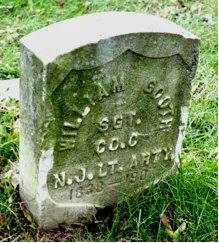
GOOTH (or GUTH), WILLIAM (1838-1907). Sergeant, New Jersey Light Artillery, Company C; private, 20th New York Infantry, Company E. Originally from Germany, he immigrated to the United States in 1856. During the Civil War, he first served in the 20th New York where he was borne on the rolls as William Guth. He enlisted at New York City on May 3, 1861, and mustered into the 20th New York three days later. On September 17, 1862, he was shot in the hip at the Battle of Antietam, Maryland, and hospitalized until November of that year. He mustered out on June 1, 1863, at New York City; the 20th disbanded in July of that year. Shortly thereafter, he re-enlisted as a private on August 9, 1863, and mustered into Battery C of the New Jersey Light Artillery on September 11. He was promoted to corporal on December 11, 1863, and to sergeant on July 4, 1864, before mustering out on June 19, 1865, at Trenton, New Jersey.
At the time of his marriage in 1869, he was a machinist in New York. The 1877 Brooklyn Direction and the 1892 New York State census report that Gooth was an engineer. In 1884, his application for an invalid pension was granted, certificate 333,651. The 1890 Veterans Schedule, which confirms his Civil War service, notes his hip injury and status as a re-enlisted veteran. The census of 1900 notes that he was a machinist; the New York State census of 1903 indicates that he was an engineer. As per his obituary in the Brooklyn Standard Union, he was a member of the Barbara Frietchie Post #11 of the G.A.R. Gooth last lived in Greenpoint, Brooklyn, where he made his home for forty years. Gooth’s death was caused by a carcinoma. In 1907, Rosalia Gooth, who is interred with him, applied for and received a widow’s pension, certificate 674,974. His son, also William Gooth, was an engineer and active member of Sons of Union Veterans serving as commander of Mansfield Camp No. 28. Gooth’s gravestone, ordered on June 2, 1936, for the “unmarked grave of a veteran,” indicates his service in the New Jersey Light Artillery. Section 116, lot 12499.
GORDON, HENRY (1836-1892). Landsman, United States Navy. A native of New York, Gordon was 5’7″ with a mulatto complexion. A laborer and cook by trade, he enlisted for one year of service with the Navy at New York City on August 11, 1863. He began serving aboard the Octorara on January 1, 1864, and mustered there again on March 31, June 30, and September 30 of that year. He last lived in New York City. His death was attributed to phthisis. Section 182, lot 16000.
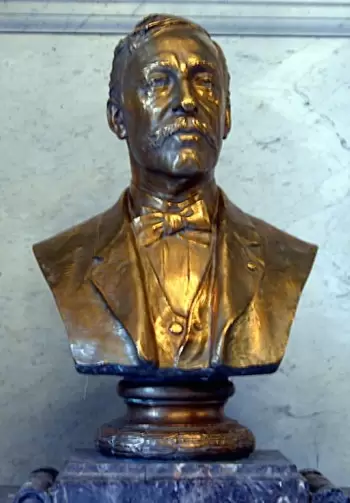
GORDON, LEONARD J. (1844-1905). Adjutant, 6th New Jersey Infantry. Gordon, a native of New Jersey, was a student at New York University in 1860. During the Civil War, he enlisted as an adjutant on September 16, 1861, and was commissioned into the Field and Staff of the 6th New Jersey the same day. He resigned his commission on January 27, 1862.
His obituary in The New York Times, which confirms his Civil War service, states that he was in business in New York for ten years before he entered medical school in 1870. In 1873, he received his M.D. degree from Bellevue Hospital, then practiced medicine for two years in Jersey City, New Jersey. He then worked as a chemist for the Lorillard Tobacco Company until 1894 when that business was absorbed by the American Tobacco Company. He is listed as a physician on the census of 1880.
However, Gordon achieved his greatest fame throughout New Jersey for his community efforts. As per his obituary in the Trenton Evening Times, he helped established the Jersey City Free Public Library in 1889, and was foreman of a grand jury on a case that indicted ballot stuffers in 1890; his refusal to reconsider that indictment in spite of gestures by people in influential positions incurred enmity from some fellow Democrats but in the end, Dr. Gordon considered his immutable decision to be of lasting benefit to citizens of his city. The Veterans Schedule of 1890 confirms his Civil War service. The census of 1900 lists his occupation as doctor.
An article about Gordon’s funeral in the Evening Journal (Jersey City) noted that the flag at City Hall was lowered to half-staff and that the main entrance of the Jersey City Free Public Library, of which he was director (as of 1901), was adorned with mourning emblems and closed for the day. Dr. Gordon was buried in his G.A.R. uniform of the G. Van Houten Post #3 of Jersey City. Although the family requested that no floral displays be sent, there was an impressive floral display of a G.A.R. badge and other tokens of esteem from the library. The minister of Gordon’s church said of him, “…As a citizen we could dwell long on his disinterested efforts for the commonwealth. In these days, when too frequently public office is sought only for personal profit, it is refreshing to find a man willing to give years of his experience and strength to the public without other recompense than the consciousness of contributing some stones to the uplifting of the municipal fabric….” The mayor, local officials, library employees, G.A.R. comrades, members of the Palma Club, of which he was president, and local citizens joined his family at the funeral. He was also a member of the Carteret Club, the New York Command of the Loyal Legion, and the Chi-Psi Society of New York University. His last address was 114A Mercer Street in Jersey City, New Jersey. His death was caused by arteriosclerosis. On February 9, 1905, the Jersey Journal (Jersey City) reported that a fund had been established to purchase a suitable memorial to honor Gordon in the library. A bust of Gordon still stands in the Jersey City Free Public Library. Section 32, lot 12255.
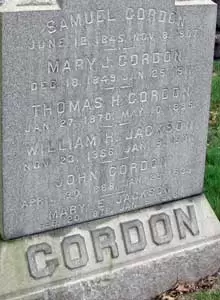
GORDON, SAMUEL (1845-1907). Corporal, 11th New York Infantry, Company H. A native of New York City (although one record says Scotland and another says Ireland), he enlisted as a private at New York City on April 20, 1861, mustered into his company on May 7, was promoted to corporal on September 1, and mustered out on June 2, 1862, at New York City.
As per the censuses of 1870, 1880, and 1900, Gordon was a painter in a shop; one obituary indicates he was a painter at the Brooklyn Navy Yard. The 1890 Veterans Schedule confirms his Civil War service. In 1904, he applied for and received an invalid pension, certificate 1,083,295. As per his obituary in the Brooklyn Daily Eagle, which reports his Civil War service, and his obituary in the Brooklyn Standard Union, he belonged to the New York Council of the Royal Arcanum, a fraternal organization. In addition, he was a member of Engine Company No. 24, Volunteer Firemen of New York. Gordon last resided at 424 Rodney Street in Brooklyn, his home for more than 20 years. He died from chronic bronchitis. Mary J. Gordon, who is interred with him, applied for and received a widow’s pension in 1908, certificate 665,468. Originally interred in lot 27363, his remains were moved to the current location on February 22, 1908. Section 132, lot 32694, grave 2.
GORE, MARTIN A. (1841-1876). Private, 22nd Regiment, New York State National Guard, Company D. A native of New York City, Gore enlisted there as a private on May 28, 1862, mustered into his company the same day, and mustered out on September 5 of that year at New York City. Gore last resided on Seventh Avenue in Manhattan. He succumbed to Bright’s disease. Section 73, lot 3547.
GORMAN, CORNELIUS (1840-1906). Landsman, United States Navy. On September 6, 1862, he enlisted as a landsman at the Naval Rendezvous at New York City. His Navy pension record indicates that he was a landsman on the USS Mahaska, USS Alleghany, USS Brandywine, and USS North Carolina. He was discharged on September 2, 1863, on the R.S. Baltic.
According to the 1881 Brooklyn Directory, he was a boatbuilder on Court and Halleck Street in Brooklyn who lived at 627 Court Street. The 1890 Veterans Schedule was not successful in verifying his Civil War service; he was listed as “not home.” He applied for and received an invalid pension in 1897, certificate 34,250. Gorman last lived at 957 Second Avenue in Brooklyn. His death was caused by cancer. In 1907, Araminta Gorman, who is interred with him, applied for and received a widow’s pension, certificate 18,604. Section 207, lot 32510, grave 2.
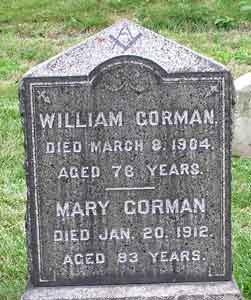
GORMAN, WILLIAM (1828-1904). Private, 2nd New York Heavy Artillery, Company B. Born in Belfast, Ireland, he immigrated to the United States when he was about twenty-one years old. During the Civil War, he enlisted as a private at New York City on September 15, 1861, and mustered into the 2nd New York Heavy Artillery three days later. His muster roll notes that he was 5′ 9″ tall with grey eyes, brown hair and a light complexion. He listed his occupation as “soldier.” As per his muster roll, he deserted from Staten Island on October 15, 1861, but returned and was restored to duty. Gorman re-enlisted on December 23, 1863. His muster roll notes that on February 29, 1864, he was present but confined awaiting a court-martial. He was found guilty and sentenced on March 5, 1864, to forfeiture of $10 pay, for disrespecting a superior officer. He mustered out at Washington, D.C., on September 29, 1865.
The census of 1870 reports that Gorman was a laborer; the census of 1880 indicates that he was a compositor. The 1892 New York State census lists Gorman as a printer; the Brooklyn Directory for 1900 lists him as a compositor. According to his obituary in the Brooklyn Daily Eagle, he was the foreman of the printing department at D. Appleton & Co. for thirty years. The obituary states that he was a Freemason and member of the Royal Arcanum, another fraternal organization; members of the Brooklyn Masonic Veterans, of which he was a member, were invited to his funeral. He lived in Bushwick, Brooklyn, for thirty-five years, last residing at 991 Decatur Street. The cause of his death was nephritis. Section 20, lot 6828.
GORTON, CEPHAS (1840-1870). Private, 71st Regiment, New York State National Guard, Company K. Various documents give his place of birth as New York, Ireland or England. Groton enlisted as a private at New York City on May 28, 1862, mustered into Company K of the 71st Regiment that day, and mustered out after three months on September 2, at New York City. His last residence was 707 5th Street in Brooklyn where he died from tuberculosis. Section 64, lot 4071, grave 555.
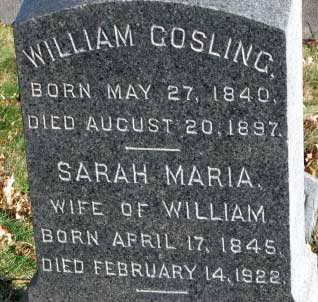
GOSLING, WILLIAM (1840-1897). Ordinary seaman, United States Navy; private, 41st New York Infantry, Company F. Originally from England, Gosling resided in Boston, Massachusetts, when he enlisted and mustered into the United States Navy as an ordinary seaman on May 24, 1861. He served on board the following vessels: USS Ohio, USS Colorado, and the USS North Carolina, from which he was discharged on July 11, 1862. As per the Draft Registration for Worchester, Massachusetts, in 1863, he was a marble-cutter like his father. He re-enlisted on November 16, 1863, at Tarrytown, New York, mustered immediately into the 41st New York, and transferred out on July 20, 1864. His soldier record indicates that he transferred into the Navy at that time. According to his pension index card, he saw service on the USS Lehigh, USS Yankee and the USS Princeton in addition to the three ships mentioned above; it is not clear when he served on each vessel.
In 1892, Gosling applied for an invalid pension to both the Army and the Navy; he received the pension from the Navy, certificate 31,973. Gosling is listed as a stone worker in the Newport, Rhode Island, City Directory of 1884; he is listed as a mason and home builder in 1890 Newport City Directory. His last residence was in Newport, Rhode Island. Gosling died of chronic endocarditis. Section 183, lot 19172, grave 6.
GOSMAN, GEORGE McALLISTER (1842-1923). Artificer, 15th New York Engineers, Company B. George was a New York City native who was a descendant of two old Long Island families: his maternal side settled on Long Island in 1688 and his paternal side settled in the area in 1760. George was born in Newtown, in the County of Queens, New York, on July 23, 1843, the youngest of six children born to William Gosman and Margaret Bargaw. The 1850 census reveals 82-year-old Elizabeth Bargaw living with the family when George was a child; her age and shared surname suggests she was his maternal grandmother and, perhaps, regaled her young grandson with stories of the family’s history and longevity in the area.
Gosman enlisted in the Civil War on August 22, 1862, and noted his occupation as a carpenter, a skill that could be utilized by the unit he would be assigned to, the 15th New York Engineers. He was discharged from his unit with the rank of artificer. An artificer, as defined by CivilWarTalk.com, “…was skilled at working on artillery in the field and would have been competent in metal and wood working, as well as repair of artillery wagons, limbers, caissons, wheels, etc.” He mustered out on June 13, 1865, and filed for an invalid pension on September 22, 1905.
After his separation from the military, George was active in the Sheridan Post #67 of the Grand Army of the Republic, serving as its commander for 21 years. Wikipedia defines the Grand Army of the Republic “…as a fraternal organization composed of veterans of the Union Army, Union Navy and Marines who served in the American Civil War…and [the Grand Army of the Republic] became among the first organized advocacy groups in American politics…It was dissolved in 1956 at the death of its last member.”
Upon his return to New York, George served as Collector of School Taxes in Newtown, Water and Fire Commissioner of Long Island City, and real estate broker.
In 1870, he married the former Jennie E DeBevoise, and they had at least two sons, Richard, born 1875, and Andrew, whose life started and ended in 1880. In 1913, Jennie was diagnosed with breast cancer. Despite the resulting mastectomy, the cancer returned and she died at the age of 70 in 1914.
On November 1, 1920, George suffered a cerebral hemorrhage which left him paralyzed. He died on November 12, 1923, at the home he shared with his son, Richard, at 231 3rd Ave in Long Island City.
George and Jennie are buried in Greenwood Cemetery, along with their sons, Richard (who died in 1946) and Andrew, George’s parents and other family members. Section 154, lot 22025.
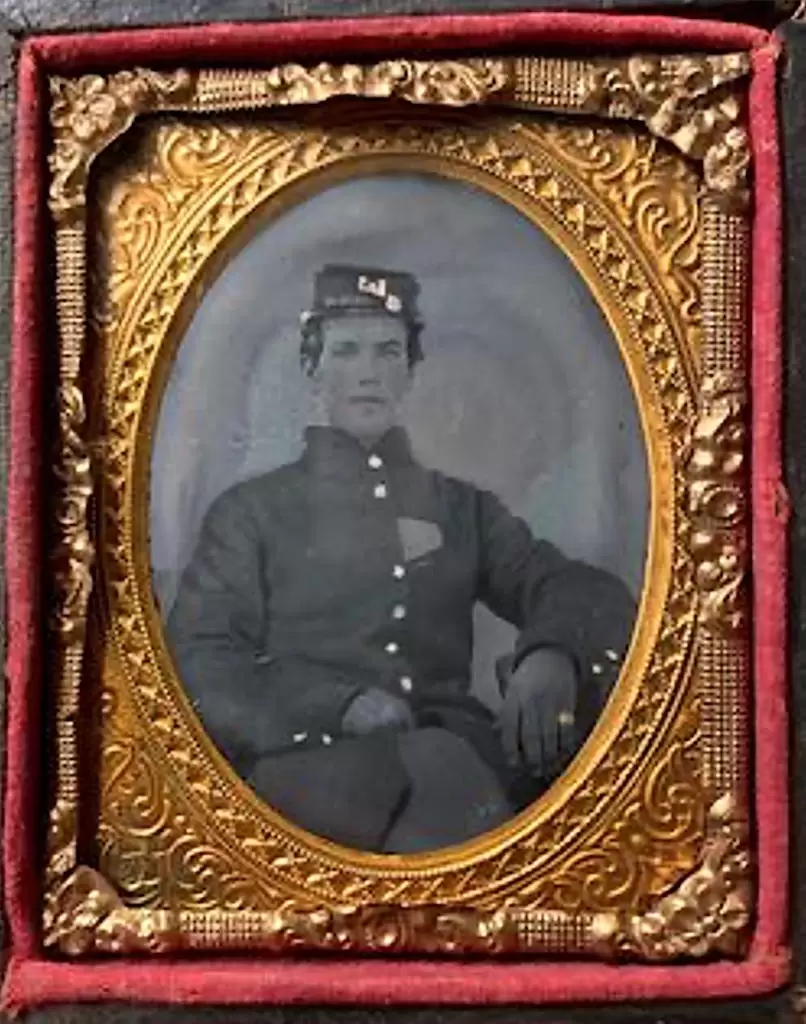
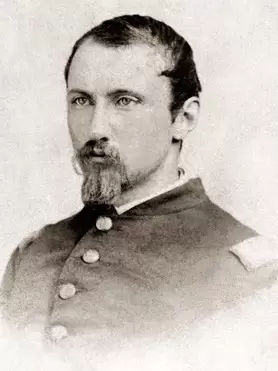
GOTT, BENJAMIN FRANK (1834-1904). Colonel, 174th New York Infantry; captain, 57th New York, Company C. Born in Newark, New Jersey (his death certificate says Upper Montclair, New Jersey), he was active in the 8th Regiment, New York State Militia, beginning as a private in 1850 and rising to lieutenant on October 6, 1854. As per his obituaries in The New York Times and the Brooklyn Standard Union, he was also a member of the State Fencibles, a noted military organization attached to the 8th Regiment, of which he was appointed second lieutenant by Governor Horatio Seymour. According to the 1860 census and the 1863 Draft Registration, he was a watchmaker.
During the Civil War, Gott helped raise a company for the 57th New York, of which Governor Edwin D. Morgan later appointed him captain. His obituary in the Brooklyn Standard Union reports that at the time he was recruiting for the 57th, he trained and was captain of a home guard organization which later became the 47th Regiment, New York State Militia; Gott was known as “the father” of that regiment. At the time he entered service, he was 5′ 9″ tall, with blue eyes, dark hair and a light complexion. After he mustered in as captain of Company C of the 57th New York Infantry in 1861, he served in the Army of the Potomac under General George B. McClellan. Gott was discharged in June 1862 for disability due to a disease of the kidneys and liver. He joined the 174th New York Infantry as its lieutenant colonel on October 17, 1862. Gott was assigned to the Department of the Gulf, served in the Peninsula Campaign, the siege of Yorktown and Battles of Fair Oaks and Plain’s Store in Virginia, the siege of Port Hudson, Louisiana, and the Sabine Pass Expedition into Texas. The 174th, due to depletion of its ranks, mustered out on October 17, 1863; Gott was promoted to colonel on October 18, 1863, and officially discharged on September 17, 1864 (although the soldier record says February 17, 1864).
After the War, Gott was a merchant in the jewelry business, then was in the wholesale liquor business in 1880. He was appointed commissioner of the Board of Charities and Corrections for Kings County in 1885, serving as president for one term. On November 1, 1885, the New York Herald reported that Gott, as a member of the Loyal Legion, a patriotic organization of military men, was one of a group of seven men who were selected to accompany the remains of General George B. McClellan from New York City to Trenton, New Jersey, and attend the funeral there. The Veterans Schedule for 1890 confirms his Civil War service. On January 6, 1891, he mustered into the Mansfield Post #35 of the G.A.R.; he later transferred to the Moses F. O’Dell Post #443. Gott voiced his opinion in the Brooklyn Standard Union that the Soldiers’ Monument should be erected in Fort Greene rather than near City Hall. His obituary in the Sun notes that he was a Democrat and a founder of the Andrew Jackson Club in Brooklyn.
Gott’s career was not without controversy. On June 29, 1895, an article in the New York Herald Tribune reported that he was questioned over discrepancies in funds during his time on the Board of Charities. Apparently, there was a surplus of $118,000 in August of 1891 and then a deficit of $252,000 in 1895. Another article about that matter appeared in the Buffalo Express on July 19, 1895. In that article, Gott admitted to “juggling the books” and noted that $500 from the emergency fund was spent for the purchase of whiskey, sherry and alcohol; Gott could not explain why so much alcohol was purchased as an emergency measure. The final disposition of the case is not noted. Although he applied for a pension in 1904, application 1,319,273, he died before it was certified. His last residence, and summer home, was at 349 Upper Mountain Avenue in Upper Montclair, New Jersey. Julia Gott, who is interred with him, applied for and received a widow’s pension, certificate 683,198. Section 178, lot 13143.
GOTT, WALLACE CONE (1843-1920). Sergeant, 57th New York Infantry, Company C; private,71st. Regiment, New York State Militia, Company H. Wallace Cone Gott was born in January 1843 to Benjamin John Gott and Elizabeth (Eliza) Holmes Gott in Brooklyn, New York (Ancestry.com). He was the youngest of three children. He and his family lived in Brooklyn’s 13th Ward where Wallace attended school.
By 1860, the United States census shows seventeen-year-old Wallace working as a clerk and living in Mount Vernon, Knox, Ohio, with Adolf Mollf and his family of nine.
A year later, eighteen-year-old Wallace had returned to New York and enlisted early in the Civil War as a private in the 71st New York State Militia, Company H; he is listed in the National Park Service’s website of Civil War soldiers as having served in the 71st for the three months of its activation (May 3-July 31, 1861). Soon after his discharge from the 71st, on September 19, 1861, he enlisted in Brooklyn as a sergeant. On October 15, 1861, he mustered into 57th Regiment, New York, Company C, according to the New York, United States Civil War Muster Roll Abstract 1861-1900. Wallace is described as on his muster roll as “eyes brown, hair brown, complexion dark, 5 feet 8 inches high.”
Things had changed for Wallace by February 1862. In a document from the New York: Report of the Adjutant-General 1893-1906, Major J.T. Sprague, Superintendent of Recruiting Services for New York State, listed Wallace as “on detached service.” This phrase referred to a soldier who was removed from his regimental responsibilities because of a change of assignment. A separate notation dated June 24, 1864, notes that Wallace deserted at White House, Virginia. However, that notation appears to be incorrect. That same muster roll (which names him with his middle initial as Wallace C. Gott) notes that Gott was on detached service, away from the 57th, as of February 7, 1862. His service discharge date is unknown.
By 1871, Wallace was back in Brooklyn. According to the New York Marriage Index 1866-1937, thirty-six-year-old Wallace was living in Brooklyn, New York, and was married to Martha A. Gott. By the 1880 federal census, Wallace and Martha were parents of three-year-old Ora and four-year-old Harry. Wallace’s mother, Elizabeth, was living with the family. Twenty-year-old Henrietta Gott was also listed as a resident in the household but her familial relationship is not described.
The family remained in Brooklyn for the rest of Wallace and Martha’s lives, although they moved at least twice within the borough. When Wallace was 57 years old, he and his family were living at 315 10th Street in Brooklyn. Wallace listed his occupation at that time as commission agent. The 1900 federal census shows that their children, 24-year-old Ora W., and 23-year-old Harry J., were living with their parents along with a younger sibling,18-year-old Jessie M. Ten years later, according to the 1920 census, 67-year-old Wallace was still living in Brooklyn with his wife Martha, and their two sons, Harry 35 and Jessie 27.
In May 1907, Wallace applied for a pension for veterans; that pension was never certified. The 1915 New York State census shows that the family, including Martha, Harry and Jessie, had moved to 471A 1st Street in Brooklyn, and Wallace’s occupation was listed as salesman. It was there that Wallace died at 77 years of age on August 27, 1920. According to his Brooklyn Daily Eagle obituary, he was survived by two sons; Martha is not mentioned. His cause of death was listed as “senility.”
In the years after the Civil War, Wallace apparently developed a reputation as an important civic figure in Brooklyn. His obituary in the Brooklyn Eagle, September 30, 1920, says that Wallace went to the front as a private (although his enlistment documents show him as sergeant) in the “old 71st Regiment” and “fought in all of its battles.” This obituary also notes that “he was one of the most prominent members of the regimental veterans association,” and that during “the Spanish-American War in 1898, he again went into service as a captain of the Quartermaster’s Department U.S.A.” This obituary concludes noting that Wallace was “known as an inventor of novelties.” An obituary in New York’s Times Union newspaper, September 29, 1920, describes Wallace as “a veteran of the Civil War through the Gettysburg Campaign” and “a member of the Veteran Association of the 71st Regiment, N.Y.” Section 65, lot 3240.
GOTTSCHALK, LOUIS MOREAU (1829-1869). Pianist and composer. He was born in New Orleans to a German-Jewish father and a Creole mother who was an accomplished singer. At an early age he showed musical ability, and went to Europe to study. When he applied to study at the Paris Conservatory, he was rejected without an audition; the director of piano classes explained that his school was no place for someone from America, “the country of railroads but not of musicians.” Gottschalk did manage to find a teacher in Paris, was befriended by Hector Berlioz, and toured Europe to acclaim. At the age of sixteen he played for Chopin, who was duly impressed, predicting Gottschalk would “become the king of pianists.” In 1853 he made American debut at Niblo’s in New York City, then toured the United States, Mexico, and South America. He was the first important composer from the United States, the first American musician with a national and international reputation, the first from his country to popularize concert music, and a brilliant pianist who shone playing his own very difficult compositions. His music combined Creole, black, minstrel, South American, Spanish, mariachi, West Indian, and Cuban elements. Though critics were divided on his talents, his popularity was enormous, rivaled only by that of the “Swedish Nightingale,” Jenny Lind. He always wore white gloves at his concerts, which he removed on stage one finger at a time. Often female admirers would then run on stage, tearing the gloves to pieces as they fought for souvenirs. A showman and a Don Juan, he was fluent in five languages. Gottschalk, who never married, was run out of San Francisco for his romantic escapades, and was threatened by many men for using his good looks and matinee-idol status to corrupt the morals of their wives. A committed Unionist and abolitionist, he toured Civil War battlefields, playing for the troops. On November 24, 1869, while leading close to 600 musicians in a performance of his own composition, Morte!! (She is Dead), he became ill and succumbed a month later. Section M, lot 19581.
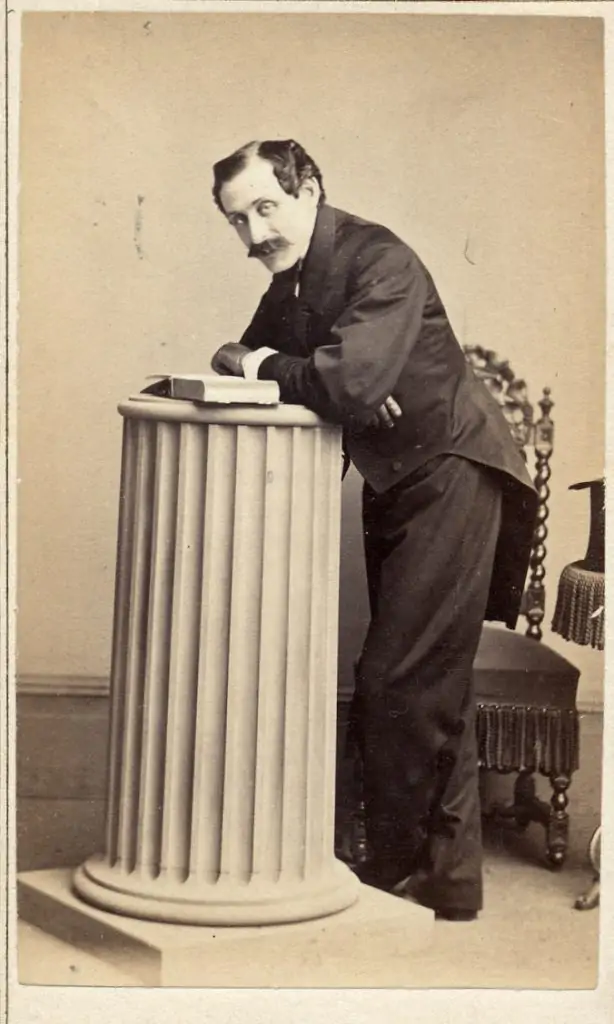
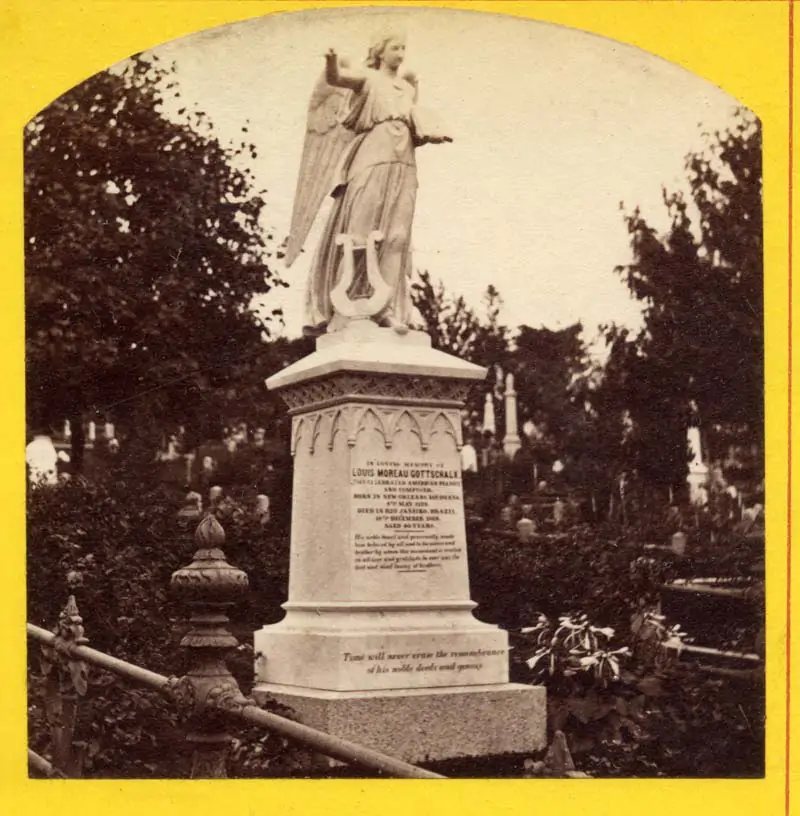
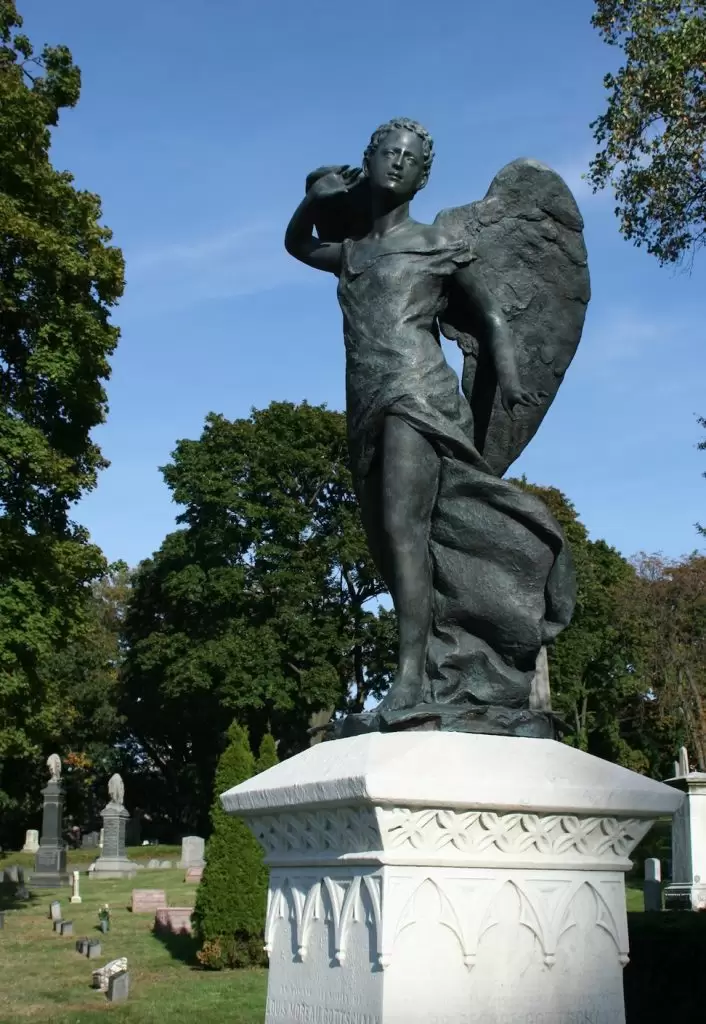
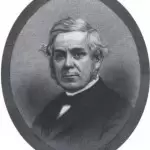
GOULD, CHARLES (1811-1870). Colonel, 176th New York Infantry. Born in Litchfield, Connecticut, Gould worked as a broker and joined the 176th New York Infantry as its colonel in September 1862. He died of apoplexy in Europe in 1870. Section 32, lot 14750.
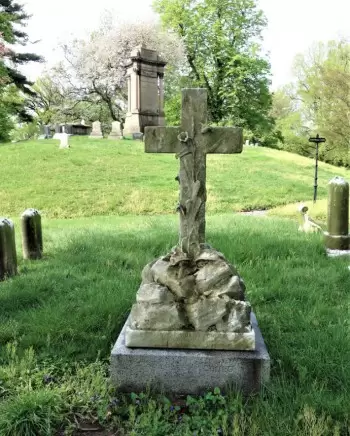
GOULD, JR., ROBERT S. (1838-1912). Sergeant, 7th Regiment, New York State National Guard, Company B. Gould, who was born in Hackensack, New Jersey, was a clerk in New York City at the time of the 1860 census. After enlisting in April 1861, Gould served for 30 days with the 7th Regiment when it was activated that year. On October 23, 1861, he re-enlisted as a first lieutenant and was commissioned into an unassigned company of the 15th New York Engineers; he declined his commission on that day and was discharged. According to his G.A.R. sketch, he returned to the 7th Regiment, now part of the New York State National Guard, as a corporal, when the unit was activated in 1862, and served from May 24 through September 2. In 1863, he was promoted to sergeant and served from June 17 through July 21.
The 1880 census reports that Gould was a real estate agent in Newark, New Jersey. On April 26, 1883, he mustered into Post #140 of the G.A.R. in Newark, New Jersey. His 1895 passport application indicates that he was 5′ 11″ tall with a long face, large nose and chin, blue eyes, grey hair and a florid complexion. Gould applied for and received a pension in 1904, certificate 1,098,699. The Newark City Directory for 1906 states that his firm’s name was Doughty & Gould and that he resided in Brooklyn. His last address was 32 Remsen Street. He succumbed to apoplexy. Elizabeth Gould, who is interred with him, applied for and received a widow’s pension in 1912, certificate 738,208. Section 163, lot 28692.
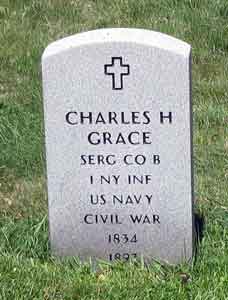
GRACE, CHARLES H. (1834-1893). Sergeant, 1st New York Infantry, Company B; paymaster, United States Navy. A native of Dublin, Ireland, Grace enlisted as a private at New York City on April 22, 1861, and mustered into the 1st New York the next day. As per his muster roll, he was a clerk who was 5′ 4½” tall with grey eyes, dark hair and a fair complexion. His regiment was part of the Army of the Potomac. Promoted at some point to sergeant, he was reduced to the rank of private on December 31, 1862, and mustered out on May 25, 1863, at New York City. According to a descendant, he re-enlisted and served as paymaster on the USS Wave and was captured on May 6, 1864, in the Sabine River campaign. The Wave and the USS Granite City were surrendered that day at the Battle of Calcasieu Pass, Louisiana. Taken as a prisoner and kept at Camp Groce in Hempstead, Texas, he kept a meticulous diary of the deplorable camp conditions until he was paroled on December 16, 1864.
The 1870 and 1876 Brooklyn Directories note that Grace was a clerk; the 1880 census and the 1891 Brooklyn Directory report that he was an inspector of weights. The Veterans Census of 1890 confirms his Civil War service. Grace was a member of the Perry Post #89 of the G.A.R. His obituary in the New York Herald, which confirms his Civil War service in both the Army and the Navy, reports that in spite of deprivation in the prison camp, Grace never applied for a pension. However, it does appear that Grace applied for a pension from the Navy citing inability to provide support through manual labor that was approved in October 1892, certificate 22,833. He last lived at 342 Greene Avenue in Brooklyn. The cause of death was nephritis. Eliza Grace applied for and received a widow’s pension in March 1893 for herself and a pension for her minor children, certificate 13,479. Upon Eliza Grace’s death in 1926, her daughter asked the Pension Bureau for reimbursement of her mother’s burial expenses and submitted a bill for them. Section 117, lot 10975, grave 1014.
GRADY, JOHN O. (1832-1894). Mate, United States Navy. Grady enlisted in the Navy on November 18, 1861, and resigned on May 3, 1862. He last lived in New York City. His death was attributed to nephritis. Section F, lot 17906.
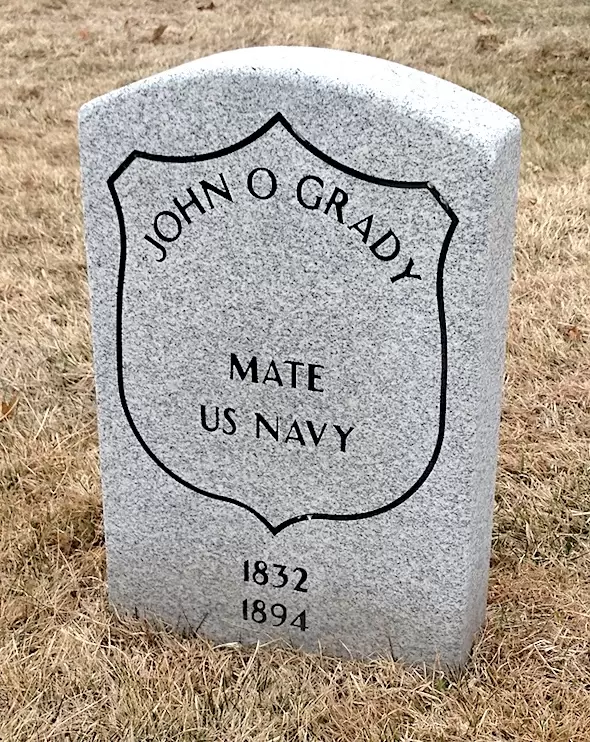
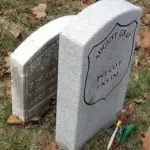
GRAF, AUGUST (1839-1894). Private, 7th New York Infantry, Company F. Born in Germany, Graf enlisted at New York City on April 23, 1861, and mustered into the 7th New York on that day. He was wounded in action on December 13, 1862, at Fredericksburg, Virginia, and mustered out at New York City on May 8, 1863. In 1892, he applied for an invalid pension but it apparently was never granted. His last residence was 524 Wythe Avenue in Brooklyn. After his death from nephritis in 1894, his widow, Margaretta Graf, who is interred with him, received a pension, certificate 403,705. Section 185, lot 22502.
GRAF, GEORGE (1829-1912). Private, 68th New York Infantry, Company K. As per Ancestry.com’s family tree, Graf was born in Westfalen, Germany on January 8, 1859. German Birth and Baptism Records, 1558-1898, document that he was baptized there as Georgius the next day, to parents Nicolai and Reginae née Biechler. He immigrated to the United States aboard the Olivia from LeHavre, France, and arrived in New York City on August 10, 1854. In 1855, he married Elisabetha Heinrika Gutzler.
There were four George Grafs (or Graff) who served in New York State regiments during the Civil War. Therefore, Graf’s Civil War history, as described below, is based on the closeness of his age to one of those soldiers. The most likely match is a George Graf who enlisted as a private at New York City on August 20, 1861, and mustered immediately into Company K of the 64th New York Infantry. That man, who was born in Bavaria, deserted on August 15, 1862. That soldier’s muster roll, with the surname spelled Graff, describes a laborer with blue eyes, brown hair and a light complexion. His online family tree on Ancestry.com shows that Graf served three months with the 6th Regiment, New York State Militia, in 1861, and then was a private in the 64th New York later in 1861.
As per his obituary in the Brooklyn Citizen, Graf established a school at his home in Brooklyn as a young man where he taught languages and music. He organized the first band in South Brooklyn that played at social functions. In addition, he led German singing societies including the Harmonia, the Concordia and the Brooklyn Saengerbund. An accomplished organist, he played for the Herman Lodge (his branch of Odd Fellows) and for the Von Moltke Society of South Brooklyn.
As per the 1870 census, Graf was living in Brooklyn with his wife, Elizabeth (Elisabeth) and children: George (15), Elizabeth (12), Joseph (6) and Amelia (4). He was working as a school teacher and had a personal estate of $200, as well as real estate valued at $2,600. According to the 1875 New York State census, the family was living in Brooklyn with a new one-year-old baby boy, Julius. The census of 1880 details that he was from Bavaria, was living at 189 19th Street in Brooklyn with his wife and four children; his eldest son, George, is not named on the census
As per his family tree, Graf was listed in 1888 as a bandmaster and professor of music. He led music societies in South Brooklyn. At the time of the 1900 census, George and Elizabeth, his wife of 45 years, were at the same address on 19th Street in a house that he owned. He was a naturalized citizen, still worked as a music teacher and his daughter Amelia (listed as Emilie on this census and other documents), her husband and two children were living with him. The 1905 New York State census shows George, Elizabeth and son Julius living in Brooklyn. By the time of the 1910 census, George was widowed and lived with his daughter, Emilie and family and son Julius. George was a self-employed music teacher.
Graf’s obituary in The New York Times noted that he died at his 19th Street home and was a professor of music, leader of singing societies and music teacher. His obituary in the Brooklyn Citizen, which refers to him as one of the best-known residents of South Brooklyn, indicates that his funeral was under the auspices of the Herman Lodge of the Independent Order of Odd Fellows, of which he was a member. Graf’s obituary in the Brooklyn Daily Eagle adds that he was a past noble grand of his lodge. His death was attributed to old age. The obituaries in the Brooklyn Citizen and Brooklyn Daily Eagle note that he requested that he be cremated at Fresh Pond and that his remains be placed at Green-Wood in the same grave as his wife, who had died and was cremated three years prior. He was survived by his children, twelve grandchildren and seven great-grandchildren. His son, George, was also a professor of music who had his own band. George Graf’s ashes were interred at Green-Wood a month after his death. Section 135, lot 27263, grave 95.
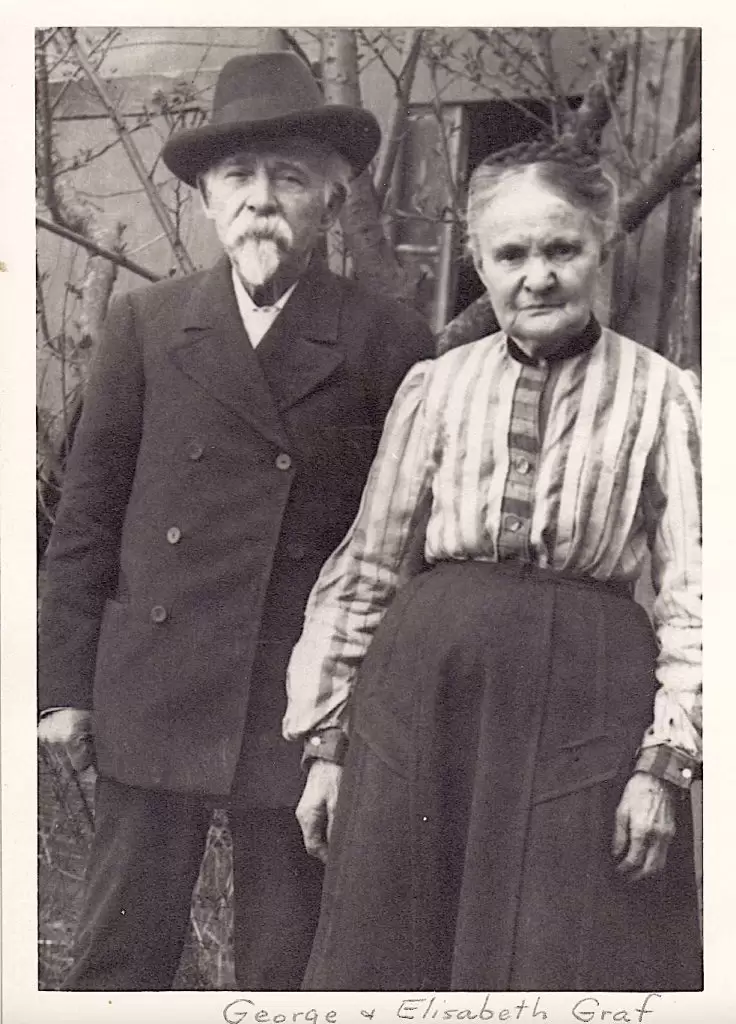
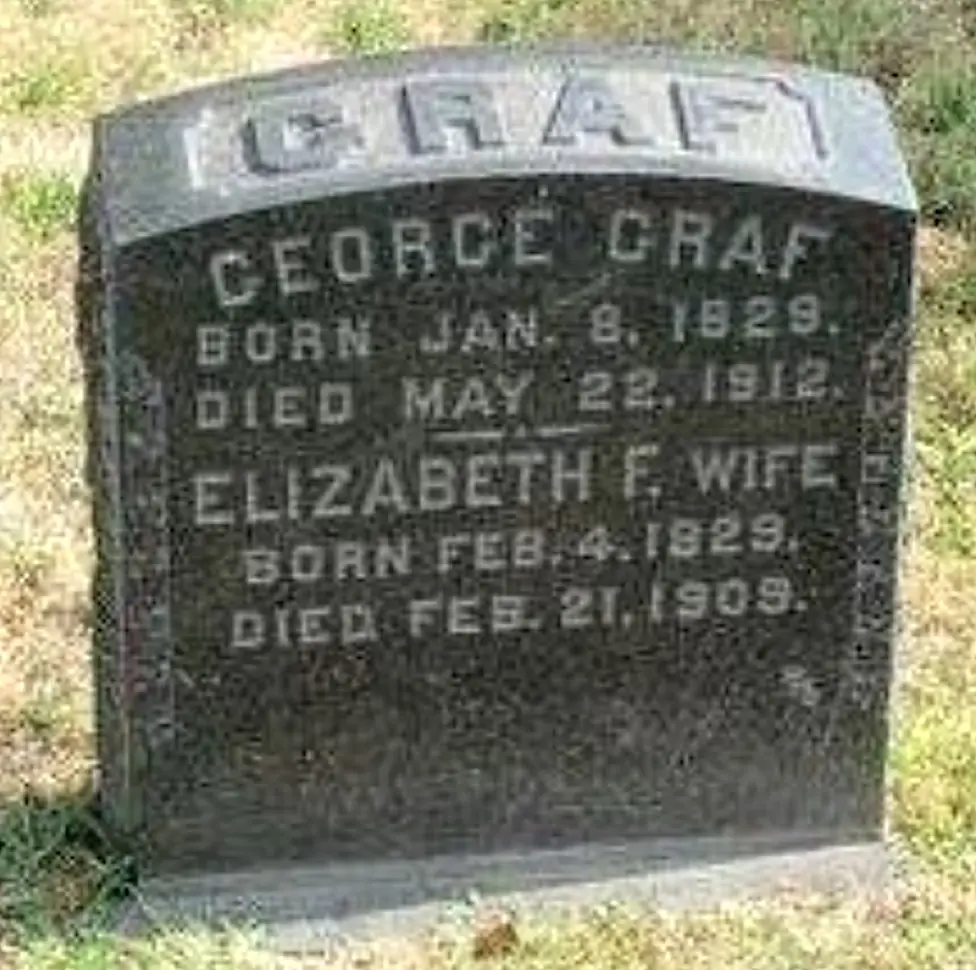
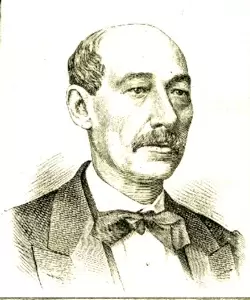
GRAFULLA (or GRAFFULA), CLAUDIO (or CLAUDIUS, CLAUDE) S. (1812-1880). Principal musician, 7th Regiment, New York State National Guard. Born on the Island of Minorca, Spain, Grafulla immigrated to the United States in 1838 and played French horn with the New York Brass Band, a group of fifteen musicians. After seven years, he left for Europe, then returned to the reorganized ensemble in 1860 as its director. Grafulla added woodwinds to the group, then forty-eight instruments. The New York Brass Band was at first closely connected to the 27th New York Regiment. Known for his technical skill, Grafulla’s most famous work was the Washington Grays March written in 1861 for the 8th Regiment, New York State Militia and still popular today. The New York Brass Band was attached to the 7th Regiment during the Civil War and according to his obituary in the New York Herald, Grafulla and his band were with the regiment when it was called to “the front.” He was band master for the first activation of the 7th Regiment from April 18-June 3, 1861. He returned as band master when the 7th Regiment was activated at New York City on May 25, 1862, and mustered out three months later on September 5. Grafulla again was the band master when the 7th Regiment was reactivated in 1863. He still is renowned for his stirring musical compositions that were developed for the over-the-shoulder brass instruments of the Civil War period. He composed and arranged Port Royal Band Books for the 3rd New Hampshire Regiment Band which it performed during the Civil War.
His obituary notes that Grafulla believed that military music was not meant for concert halls and was to be performed in the street, on the field, or in parade grounds. The 7th’s Band was considered as best of its kind in the United States and comparable to those in Europe. Grafulla never accepted payment for conducting at summer encampments, escorting bodies of troops or public processions throughout the city. Associated with Boss Tweed, he received the nickname of “general” by the Americus Club when it held festivities on Long Island Sound and formed a “mock army.” Grafulla continued to serve as the director of the 7th’s Band until his death from pneumonia. In 1922, John Philip Sousa honored the 7th Regiment with his piece, The Gallant Seventh March. Section 203, lot 23582.
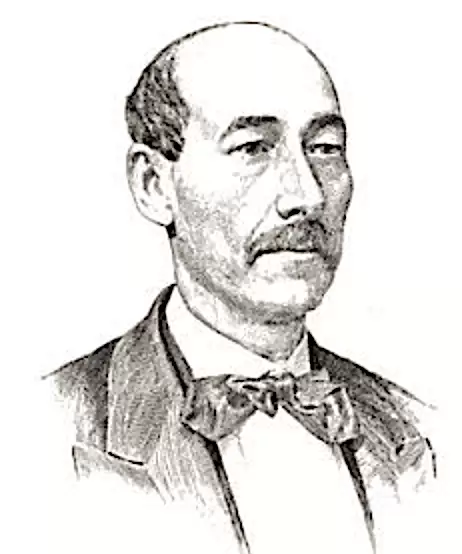
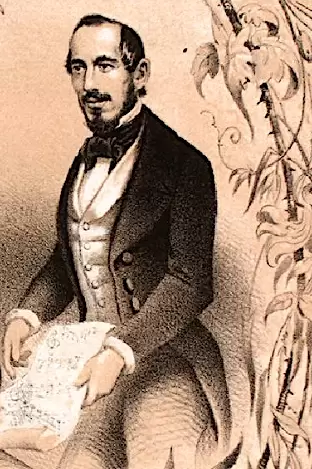
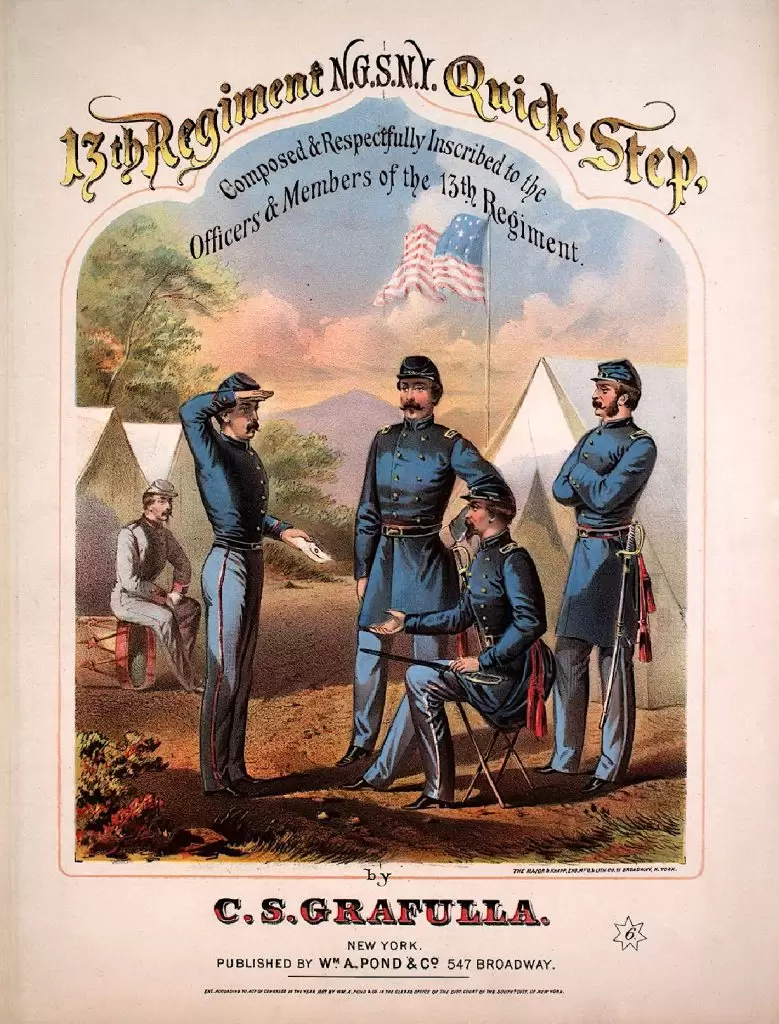
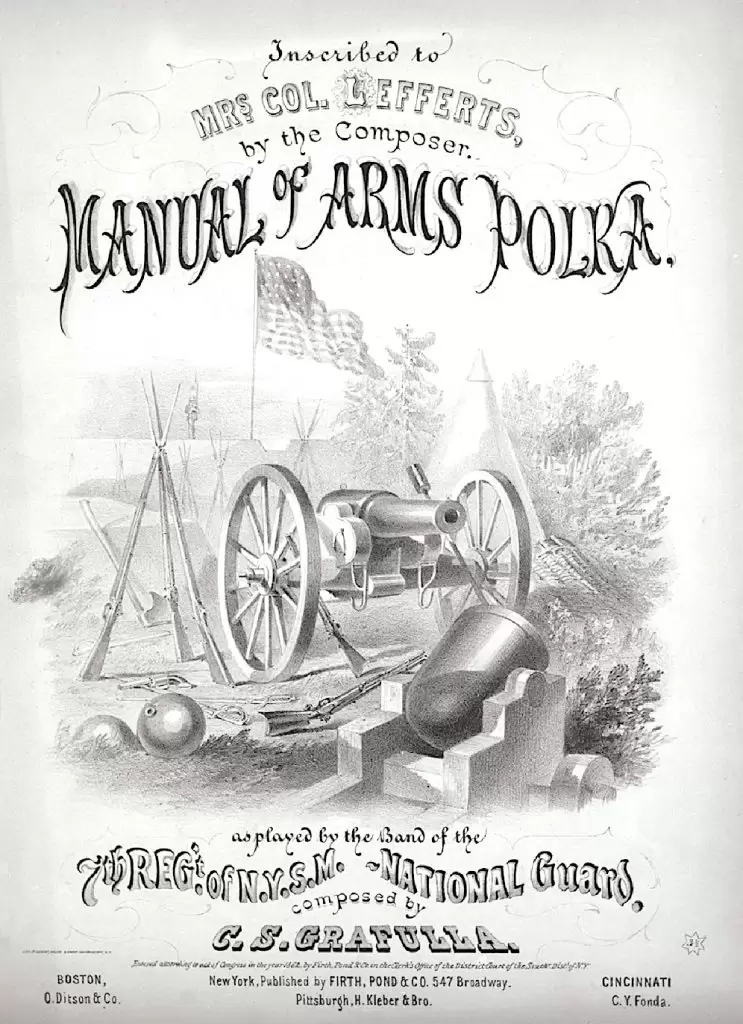
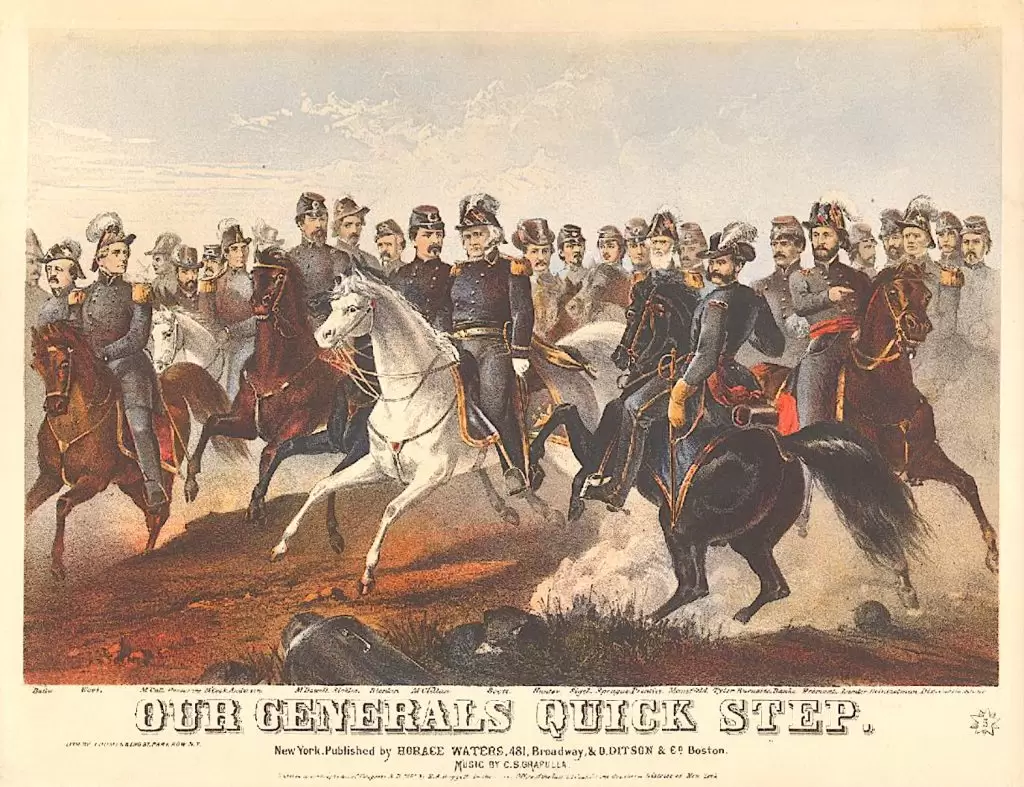
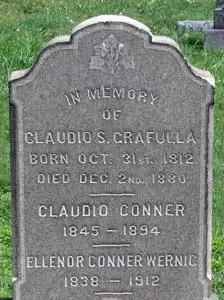
GRAHAM, ADELBERT HORACE (1846-1917). Private, 1st New York Light Artillery, Battery L. Graham, a native New Yorker, enlisted as a private at Rochester, New York, on March 7, 1864, and mustered into the 1st New York Light Artillery that same day. As per his muster roll, he was a merchant who was 5′ 8″ tall with blue eyes, light hair and a light complexion. Graham mustered out with his company on June 17, 1865, at Elmira, New York. He was living in Brooklyn at the time of the census of 1900 and had been married for 29 years. In 1908, he applied for and received an invalid pension, certificate 1,148,781. The 1910 census reports that he was a widower living with his son’s family on Central Avenue in Hempstead, New York, and was a retired carpenter. Section 79, lot 10292.
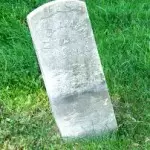
GRAHAM, ALEXANDER (1837-1889). Private, 12th Regiment, New York State National Guard, Company I. According to the inscription on his circa 1890 government-issued gravestone, Graham served with the 12th New York State National Guard for three months in 1862. When he died on September 27, 1889, his demise was recorded as a homicide. His last residence was 351 Bowery, Manhattan. Section 6, lot 20118, grave 164.
GRAHAM, ALEXANDER L. (1826-1863). Captain, 25th Regiment, New York State Militia, Company E. Of Irish birth, Graham enlisted as a captain on May 11, 1861, at New York City, and one month later, on June 14, mustered into the 25th Regiment, New York State Militia. He mustered out on August 2, 1861. His last residence was in Washington, D.C. The cause of death was lung inflammation. Section 55, lot 7341.
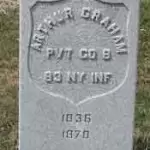
GRAHAM, ARTHUR (1836-1870). Private, 83rd New York Infantry, Company B. He enlisted as a private at New York City on May 27, 1861, mustered immediately into the 83rd New York, and deserted on March 6, 1863. His last address was 420 West 46th Street in Manhattan. His death was attributed to “exhaustion.” Section 116, lot 4073, grave 759.
GRAHAM, JOHN HODGES (1794-1878). Commodore, United States Navy. A native of Rutland, Vermont, Graham had a long career in the United States Navy entering service at age sixteen. He was appointed midshipman on June 18, 1812, and saw action on Lake Ontario during the War of 1812. During that conflict, he was wounded in the ankle and was carried off by a young sailor; his injury resulted in the amputation of his leg. After being refitted with an artificial limb, he returned to sea and was with Commodore Perry at Lake Erie where he experienced hearing loss from the extensive firing of cannons. His obituary in the Brooklyn Daily Eagle notes that he commanded the magazine of Commodore McDonough’s flagship during the Battle of Lake Champlain. Returning to the United States after a tour in the Mediterranean, he was stationed at the Brooklyn Navy Yard and spent most of his career engaged in shore duty. He rose to lieutenant on March 5, 1817. He became a commander on February 28, 1838, a captain on March 7, 1849, and was placed on the Reserved List on September 13, 1855. Graham was listed as a commodore on the Retired List on April 4, 1867.
Graham was a member of the Episcopal Church in Brooklyn during his time at the Navy Yard. He last lived in Newburgh, New York. As per an article in The New York Times, his estate was valued at $300,000; half of his estate was left to his wife and $150,000 was bequeathed to charitable organizations in New York City and in Newburgh. Among the many charities that were gifted were: Trustees of the Protestant Episcopal Church and other Episcopal organizations and churches, St. Luke’s Hospital in New York City, American Bible Society, two sick relatives of his wife, and numerous charitable organizations that helped children, widows, and the disabled. Section 100, lot 4084.
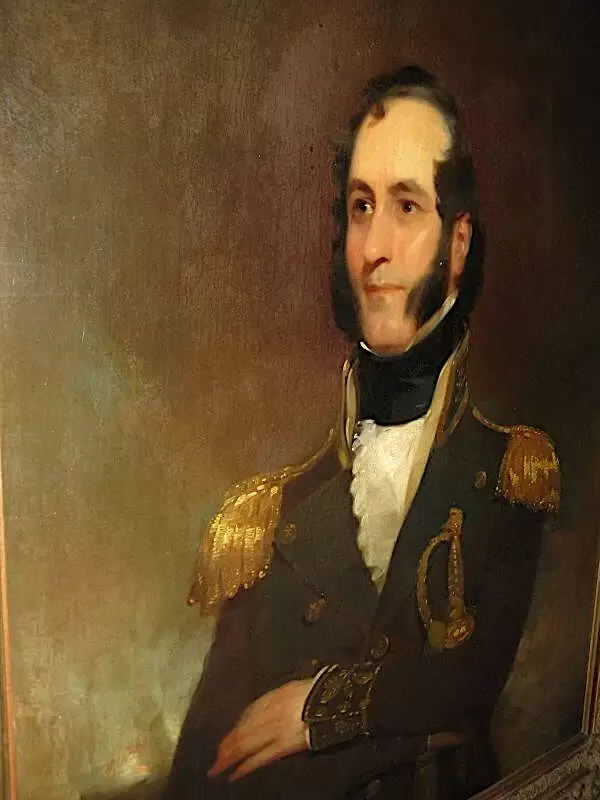
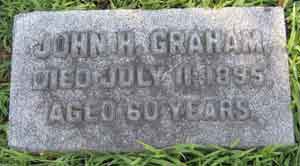
GRAHAM, JOHN HUGH (1835-1895). Lieutenant colonel and major by brevet; captain, 5th New York Heavy Artillery, Company A. Born in Belfast, Ireland, and the son of Samuel A. Graham (see), he immigrated to Brooklyn when he was three months old. His father was prominent in business and public affairs in Brooklyn. John Graham was educated in the public schools at P.S. 4 on Classon Avenue. After apprenticing as an architect, he entered the hardware business in 1854 and continued in that trade throughout his lifetime. His obituary in the Brooklyn Daily Eagle reports that in 1857, 1858 and 1859, he was deputy commissioner of repairs and supplies in that business. On June 2, 1858, he married Annie Oliver; the couple had three sons.
Graham served for seven years in the militia before enlisting as a captain at Brooklyn on December 1, 1861, and was commissioned into the 5th Heavy Artillery on June 10, 1862, the same day his father was made its colonel. John Graham organized Battery A of the 5th Artillery, then commanded it at the siege and surrender of the garrison at Harpers Ferry, Virginia, on September 12-15, 1862, was taken prisoner, then exchanged. His actions there were noted by Lieutenant Henry Binney in his field report of September 18 that said Graham and another captain deserve much praise “for the masterly and gallant manner of handling their guns, and good conduct on several occasions…” From July 4 to July 8, 1864, he commanded the 5th on Maryland Heights at the engagement at Harpers Ferry (now West Virginia). He mustered out at Harpers Ferry on March 6, 1865, and was brevetted major and lieutenant colonel to date from March 13, 1865, for his “gallant and meritorious services during the bombardment of Harpers Ferry, Va., by the enemy in September 1862.” His obituary notes that a few months before the end of the Civil War, he was employed by Hotchkiss, the inventor of the machine gun.
In January 1870, he entered the wholesale hardware business with an establishment, John H. Graham & Co., at 113 Chambers Street in Manhattan; two of his sons later joined him in the business. He was a member of the Military Order of the Loyal Legion, a patriotic organization of Civil War officers, and mustered into the George C. Strong Post #534 of the G.A.R. in January 1885. He was long active in the Democratic Party, where he served on the Democratic General Committee in his district for 17 years. Although he was nominated as a Presidential elector in 1892, he resigned because he was a national bank director. However, he ran for national office and served in Congress 1893 through 1895. Graham’s obituary in the Brooklyn Daily Eagle, which confirms his service and gallantry in the Civil War, notes that he was a Democrat who was elected in a Republican District.
Active in his community, he was a trustee of the East Brooklyn Savings Bank, a director of the National Shoe and Leather Bank of New York, as well as a director of the Port Jervis and Monticello Railroad. Also interested in charitable work, he was active in the Association for Improving the Condition of the Poor. He also belonged to the Bushwick Club and was the representative of the Hardware Board of Trade in the World Fair Commission. Graham’s funeral took place at the Puritan Congregational Church on Lafayette and Marcy Avenues. He last lived at 663 Lafayette Avenue in Brooklyn. His obituary noted that he had been ill for two years before succumbing to pneumonia and a complication of diseases. Section 153, lot 20406, grave 3.
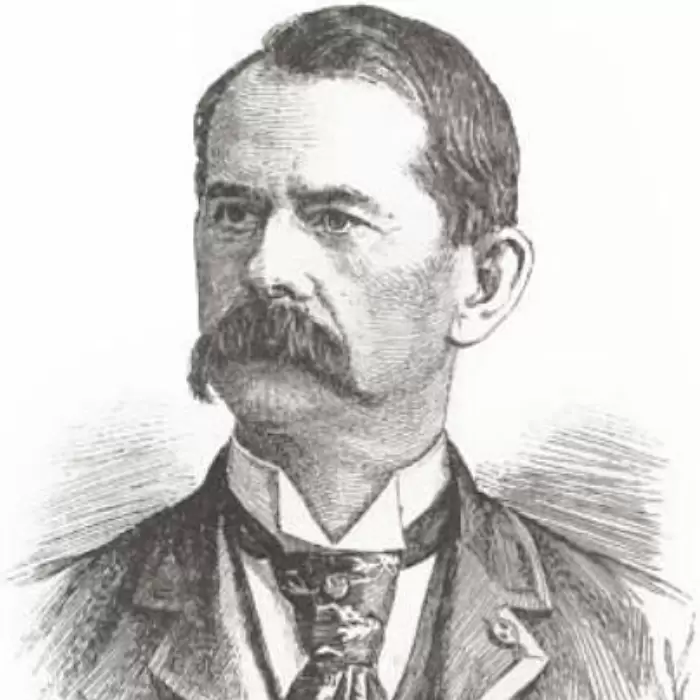
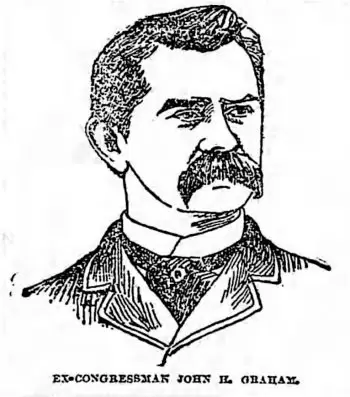
GRAHAM, SAMUEL A. (1813-1884). Brigadier general by brevet; colonel, 5th New York Heavy Artillery. Born in Belfast, Ireland, he enlisted on March 6, 1862, and was commissioned into the 5th as its colonel on June 10, 1862. Brevetted to the rank of brigadier general on March 13, 1865, “for gallant and meritorious services in the engagements in and around Harpers Ferry, Virginia, in 1864,” he mustered out at Harpers Ferry, West Virginia, on July 19, 1865. Among his many occupations were hardware merchant, builder, and municipal official. He was the father of John Hugh Graham (see). His death was caused by “valvular of heart.” Section 95, lot 1612.
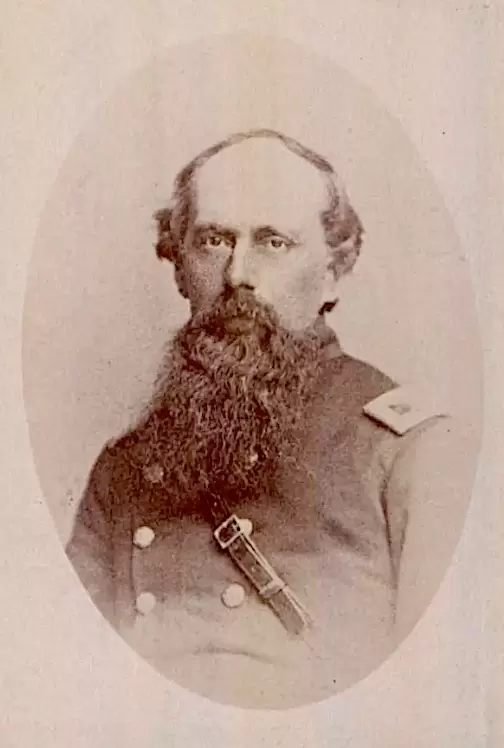
GRAHAM, THOMAS L. (1838-1909). Private, 8th Regiment, New York State Militia, Company D. A New York City native, Graham served for three months when the 8th Regiment was activated in 1861. According to the census of 1880, he was a bookkeeper living in Cortlandt, New York. The 1902 Brooklyn Directory lists Graham as an oilcloth manufacturer in Astoria, New York. In 1907, he received a pension, certificate 1,138,122. His obituary in the Brooklyn Daily Eagle, which confirms his Civil War service, reports that he was a prominent Freemason and the chief accountant for the Standard Oilcloth Company (oilcloth is waterproofed canvas used for table cloths or floor covering) which was formed in 1907. The aforementioned business originated in 1901 as the Standard Table Oilcloth Company which consolidated the leading manufacturers of oilcloth in the United States. He last lived at 55 Brooklyn Avenue in Brooklyn. He succumbed to cancer. Emma Graham, his widow, who is interred with him, received a pension in 1909, certificate 692,116. Section 52, lot 4952.
GRAHAM, WILLIAM (1841-1893). Coal heaver, United States Navy. An Irish native, Graham served as a coal heaver on board the USS Kanawha during the Civil War. The Veterans Census of 1890, which confirms his service in the Navy, reports that he served from January 10, 1861, through February 22, 1864. As per his invalid pension approved by the Navy, he was disabled by eye disease eventually resulting in total blindness. Graham first received $4 per month as of February 28, 1865, $8 per month as of December 1, 1870, $18 per month as of February 16, 1875, $50 per month as of September 28, 1881, and $72 per month as of April 8, 1884. He last lived at Richmond and Fulton Streets in Brooklyn. His death was attributed to tuberculosis. Isabella Graham applied for and received a widow’s pension from the Navy, certificate 13,482. Section 114, lot 8999, grave 889.
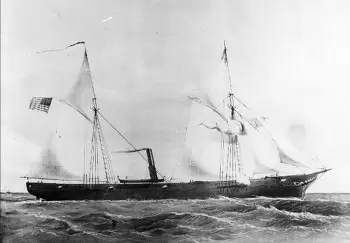
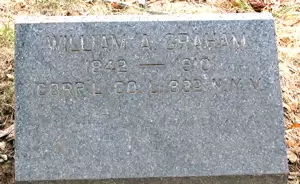
GRAHAM, WILLIAM A. (1842-1910). Corporal, 83rd New York Infantry, Companies L and A; 94th New York Infantry, Company D; private, 97th New York Infantry, Company H. A New York City native, he enlisted there on September 11, 1861, as a private, immediately mustered into the 83rd New York’s Company L, and was promoted to corporal on or about April 15, 1863. After being taken prisoner on July 1, 1863, at the Battle of Gettysburg, Pennsylvania, he was paroled on an unknown date. He also served in Company A of the 83rd. On June 7, 1864, Graham was transferred into the 97th New York as a private, and then was transferred to the 94th New York on August 10 upon his promotion to corporal. He mustered out on September 10, 1864, at New York City.
The 1882 Jersey City Directory indicates that he was living there and working as a machinist. According to the 1890 Veterans Schedule, which confirms his Civil War service, Graham was slightly wounded in the shoulder at the Battle of Antietam, Maryland, and imprisoned for three months (no date given but likely after his capture at Gettysburg). He applied for an invalid pension in 1890 and received it under certificate 675,701. The censuses of 1900 and 1910 both state that he was employed as a machinist. He last lived on 309 Fourth Street in Jersey City, New Jersey. Shortly after his death due to septicaemia in 1911, his widow, Sarah Graham, received a pension, certificate 718,025. Section 115, lot 20990.
GRANDIN, WILLIAM GAIN (1820-1863). Captain, United States Volunteers, Commissary Department. Grandin graduated from West Point, 44th in the class. He began service as a second lieutenant with the 4th Infantry in July 1837, was aide-de-camp to General Zachary Taylor from 1838-40, was promoted to first lieutenant in April 1840, and resigned from service six months later. After he enlisted as a captain on September 30, 1861, he was commissioned into the Commissary Department of the United States Volunteers as a captain and commissary. He was discharged on February 3, 1862, after his appointment was negated by the Senate. He last resided in Washington, D.C., where he died of coup de soleil (sunstroke). Section 74, lot 6101.